

7 Science Fair Projects that Solve Problems
- August 5, 2023
Share this post:
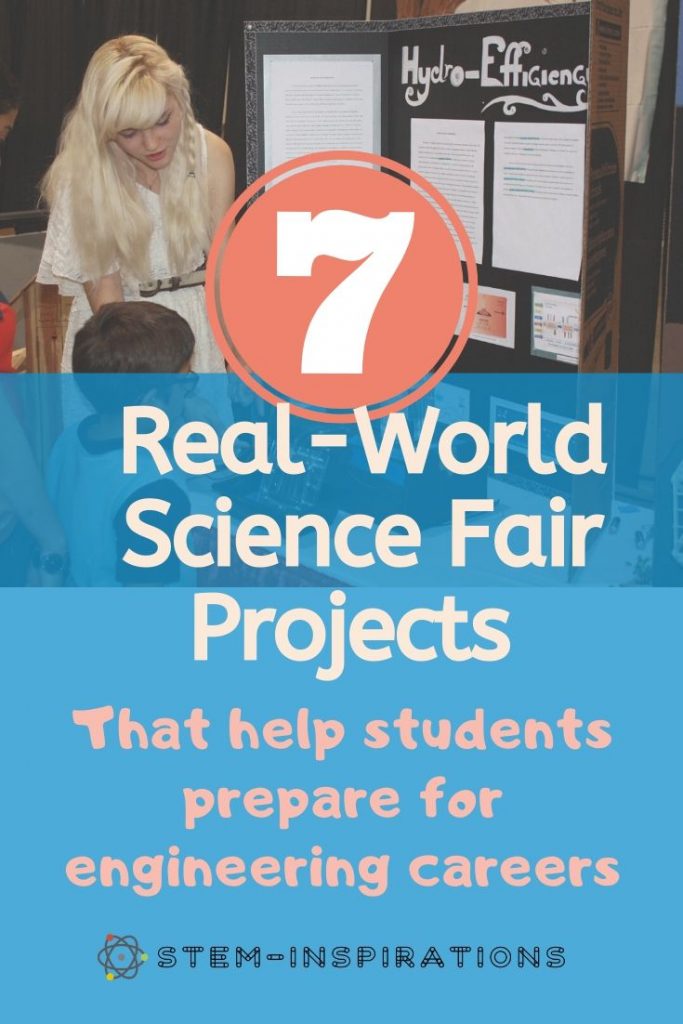
Science fair projects that solve problems are a great way for students to test their interest and aptitude for a career in STEM (science-technology-engineering-math). But they shouldn’t choose just any old topic. To make the most of the opportunity, try to focus on projects with real-world applications. This will give them hands-on experience directly related to a good-paying job field, like engineering .
With planning and hard work, the right science fair project might bump up a student’s chances for a scholarship or a trip to one of the science competitions sponsored by the Society for Science .
Do your students need help sketching the experimental set-up for a science fair presentation? Check out these resources:
- No-Prep Worksheets – How to Draw like an Engineer and Isometric Drawing
- 3D Isometric Drawing and Design for Middle School
- My Engineering Draw & Write Journal for Kids : 48 Fun Drawing and Writing Prompts to Learn about the Engineering Design Process.
Don’t get me wrong — creating foaming volcanoes or diagramming the human circulatory system are fun and classic ideas for a science fair project. But unless your student plans to go to med school or major in geology, these typical projects won’t do much to advance his or her future career. Far more practical engineering jobs will be available in the 21st century.
In this post you’ll find seven problem-solving science fair projects gleaned from the Education.com website. They provide simple, but realistic, introductions to real-world careers in electronics, robotics & automation, and construction engineering.
For more help with choosing a science fair topic, setting up your experiment, collecting and analyzing the data, and presenting your results, visit NASA’s video page on How to do a Science Fair Project .
Solving problems in Smart Technology
Consider the hottest topic in industry today – Smart Manufacturing, or Industry 4.0, sometimes called the Industrial Internet of Things (IIOT). Industry 4.0 is just one facet of the global push towards Smart Cities, Smart Homes, and Smart Agriculture.
All these concepts center on wireless connectivity between machines using cellular networks. So, for Smart Homes, this means your utilities, fridge, lights, security, HVAC, and other systems would be connected through an app on your smartphone. From there you can track and control these systems to keep your home safe and comfortable, while reducing water and energy use.
[Click here to join the STEM-Inspirations mailing list ]
For Industry 4.0, companies are connecting the machines used in their manufacturing and power generation plants at different locations around the world. On top of that, they are creating “digital twins” of each machine, which are 3D animated computer models of the machines.
The idea is to collect real-time data from each machine and then use that data, along with artificial intelligence (AI), machine vision, and even virtual reality simulations, to:
- Design new products
- Predict when a machine will need maintenance BEFORE something goes wrong
- Optimize the output of the machines and harmonize them to work together
Solving problems in Robotics
Another major topic in industry is robotics and automation . Automation means that machines are programmed to perform tasks without human help. Some robots are standalone, “service” robots, like the Roomba. Others, like robotic arms in factories and warehouses, pick and place items to be processed.
The more human-friendly “collaborative” robots can improve human capacity and are safe to work around. Put together, these technologies allow some manufacturing plants to run “lights out,” without any human input for days.
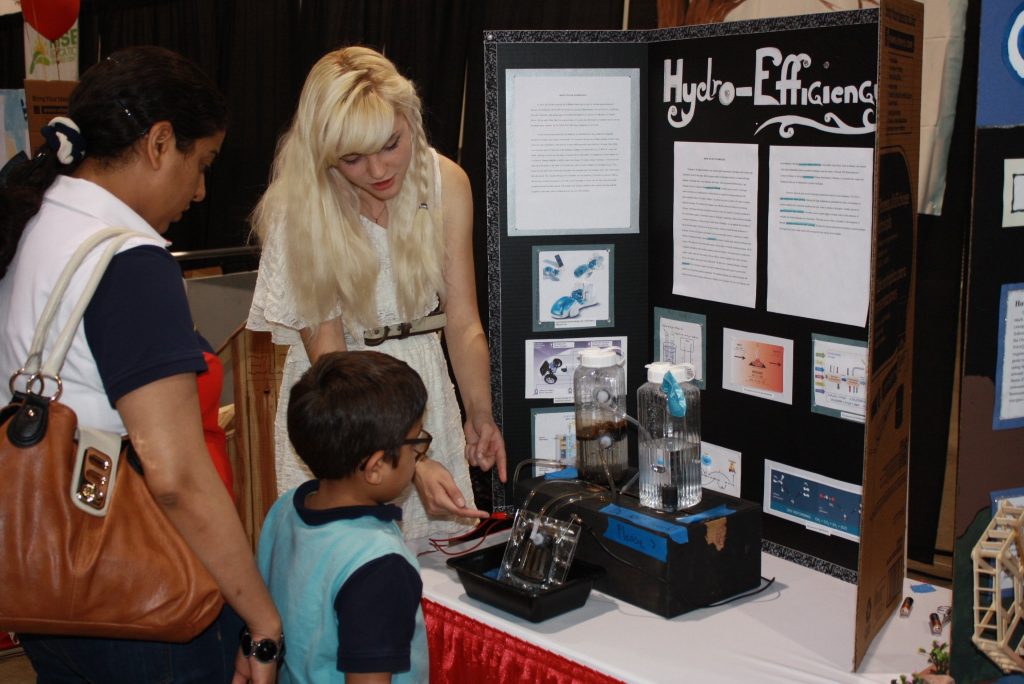
Robots are boosting agriculture, both in planting and harvesting fields and in packaging food. With Smart Agriculture technology, farmers collect data in their fields with mobile apps applying artificial intelligence (AI) software to reduce fertilizer needs and optimize water use.
Help students sketch their experimental set-up for science fair presentations with these resources: No-Prep Worksheets – How to Draw like an Engineer and Isometric Drawing 3D Isometric Drawing and Design for Middle School My Engineering Draw & Write Journal for Kids : 48 Fun Drawing and Writing Prompts to Learn about the Engineering Design Process.
Solving Engineering Problems
Most science fair projects on the internet seem to focus on the basic sciences, like biology and chemistry. But in light of the skills gap we are now experiencing between the available job force and manufacturing industry requirements, I believe engineering-focused science fair projects that solve problems in Industry 4.0, robotics, automation, and construction may be better choices for building up tomorrow’s workforce.
Here are 7 science fair project ideas that focus on solving problems:
1. cell phone dead zones science fair project.
https://www.education.com/science-fair/article/cell-phone-dead-zones/
Students learn how wireless networks work, find dead zones where wireless signals are lost, and determine ways to reduce these zones – important preparation for students who hope to work on Smart Homes, Smart Factories, Smart Cities, or Smart Agriculture.
2. App development science fair project
https://www.education.com/science-fair/article/iphone-application-design/
An app on a phone or tablet can be an interactive game, a navigational device, a business software package, or just about anything else you can imagine. This project allows you to get a head start in the growing app design field by designing your own app for popular smartphones.
3. Smoke detector science fair project
https://www.education.com/science-fair/article/smoke-detectors-working/?source=related_materials&order=2
Sensors of all kinds solve problems for smart technologies and robotics engineering. Sensors can detect motion, gases, light, heat, and other changes in the environment to allow robots to avoid collisions or Smart Homes to detect a fire, for example. This project compares the effectiveness of two types of sensors in a smoke detector.
4. Faraday’s experiment science fair project
https://www.education.com/science-fair/article/faraday-experiment-current-generated-magnet/
Electric currents create their own magnetic fields, and the movement of magnets induces , or creates, current in a wire. Motors and generators use magnetic movement to create current and send electricity to do useful work to power machines. In this lab, you will recreate Michael Faraday’s famous experiment by building a solenoid (a coil of wire) and experiment with moving magnets to produce current.
5 & 6. EMFs science fair projects
https://www.education.com/science-fair/article/smart-card-electromagnetic-fields/
https://www.education.com/science-fair/article/EMF-affect-us/
Radio Frequency Identification (RFID) is an electronic technology used in credit cards, ID Cards, and theft prevention systems, as well as in manufacturing, warehousing and shipping products. The first project measures the electromagnetic fields (EMFs) given off by various RFID transmitters, which may have harmful effects on people. The second project looks directly at how EMFs can affect us physically.
7. Rust prevention science fair project
https://www.education.com/science-fair/article/bust-that-rust/
Metals rust, and that can be a big problem when it comes to bridges, buildings, cars, and any object exposed to air and water. This project examines the process of oxidation (not just rust) that ultimately breaks down every physical object and looks at ways to prevent that from happening.
For more problem-solving science fair project ideas, follow the STEM-Inspirations Science Fair Projects board on Pinterest.
Copyright © 2017-2021 by Holly B. Martin
Click here to join the STEM-Inspirations mailing list .

Hi, I'm Holly!
I help you educate and inspire students to pursue careers in STEM/STEAM!
Click here to learn more about me and how I can help you .
Let's Connect!
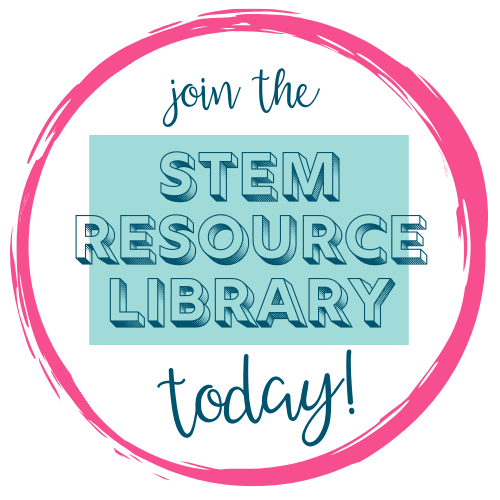

150+ Engaging STEM Projects for Kids and Students
STEM projects, which encompass science, technology, engineering, and math, are the perfect way to ignite curiosity, develop problem-solving skills, and have a blast while learning.
Are you looking for exciting and educational activities for your kids, students, or even the whole family? Look no further! STEM projects, which encompass science, technology, engineering, and math, are the perfect way to ignite curiosity, develop problem-solving skills, and have a blast while learning. In this blog post, you’ll discover over 150 engaging STEM projects for young learners, elementary school students, middle school students, high school students, and even projects the whole family can enjoy together. Let’s dive in and explore the exciting world of STEM!
Key Takeaways
- Introduce young learners to STEM concepts with fun and easy projects!
- Encourage kids to explore technology, renewable energy, and water filtration through engaging projects.
- Inspire the whole family to learn about rocketry principles, meteorology & astronomy by creating DIY telescopes & backyard weather stations!
Fun and Easy STEM Projects for Young Learners
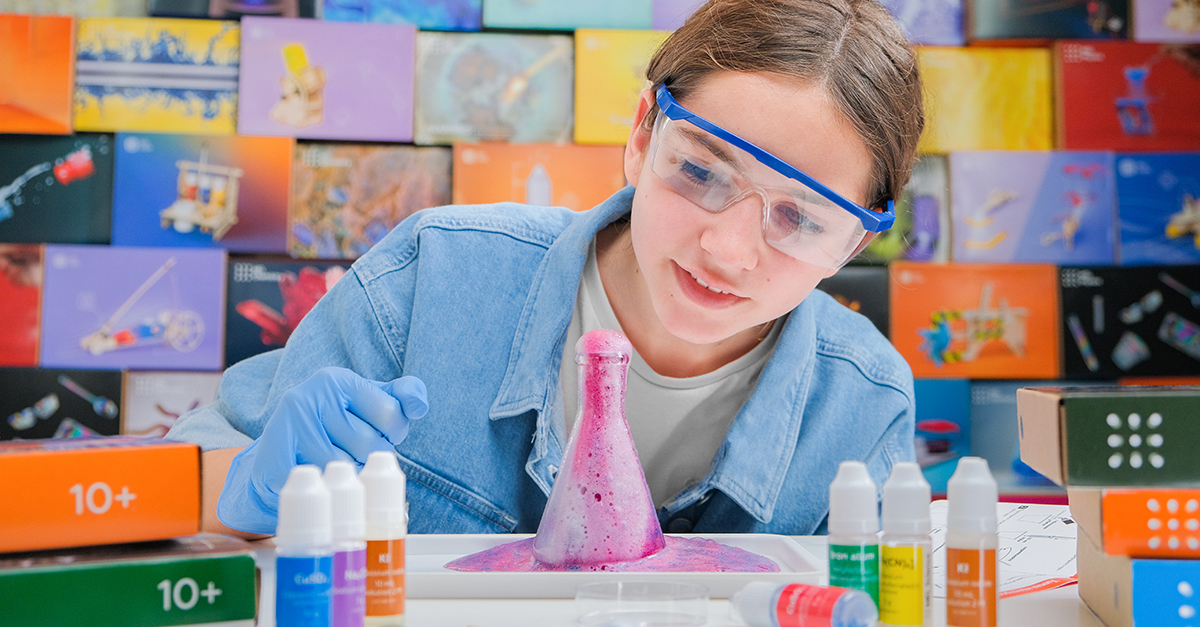
Young minds are naturally curious and eager to explore the world around them. Fun and easy STEM activities for kids, like creating homemade slime, building LEGO towers, and conducting homemade volcano experiments, are perfect for introducing young children to STEM concepts while keeping them engaged and entertained. These projects not only teach kids about science, technology, engineering, and math, but also help them develop critical thinking, creativity, and problem-solving skills.
Starting with basic supplies, most activities can be completed in just 15 to 30 minutes, making them perfect for classroom or home use. The hands-on nature of these projects allows kids to learn by doing, which is often the most effective way to teach and engage young learners. Now, here are some thrilling STEM projects that young learners can immediately embark on!
Creating Homemade Slime
A classic and fun STEM activity for kids is creating homemade slime. This gooey, slimy concoction not only provides hours of entertainment, but also teaches kids about chemical reactions and properties of matter. As they mix ingredients like glue, baking soda, and contact lens solution, they’ll observe how the combination results in a fascinating new substance with unique properties.
To get creative with slime, kids can:
- Experiment with different colors, textures, and even add-ins like glitter or small toys
- Follow instructions and ideas from online resources like Slime Design/Science Buddies and STEAM-Powered Family
- Make slime in various ways, with the range of choices being infinite
This promises endless fun with the egg drop challenge!
Building a LEGO Tower
LEGO bricks have been a popular toy for generations, and they’re also fantastic STEM resources for kids to develop their creativity, problem-solving skills, and engineering abilities. Building a LEGO tower is an exciting engineering challenge that encourages kids to think critically and strategically about how to construct the tallest tower possible.
This activity can be done individually or in groups, making it perfect for both classroom and home settings. Kids can experiment with different building techniques, materials, and styles, and even compete with their friends to see who can build the tallest tower. With this captivating STEM challenge blending enjoyment and education, there are no limits when it comes to stem stands!
Homemade Volcano Experiment
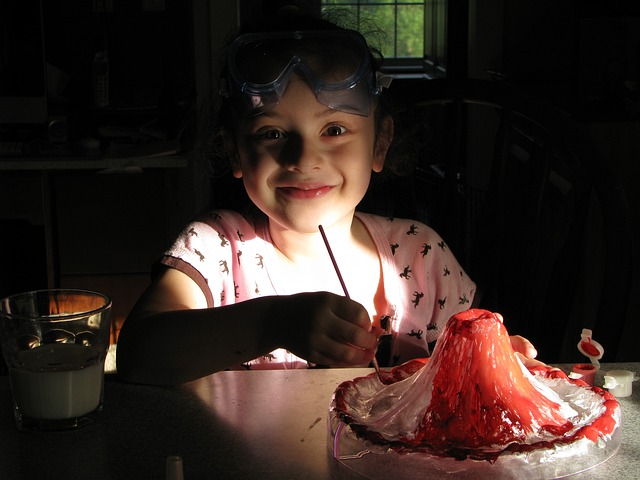
Who doesn’t love a good volcano eruption? The homemade volcano experiment is a classic science activity that introduces kids to chemical reactions and geology in a fun and exciting way. Using simple materials like baking soda, vinegar, and some food coloring, kids can create their very own volcanic eruption right in their own kitchen or backyard.
This hands-on science experiment not only provides a thrilling experience for young learners, but also helps them develop a deeper understanding of how chemical reactions work and the geological processes that occur within our Earth. This enjoyable activity ignites curiosity, motivating kids to delve into the intriguing world of science.
STEM Projects for Elementary School Students

Elementary school students, especially younger kids, are ready to take on more challenging STEM projects that help them develop their problem-solving skills, critical thinking, creativity, and engineering skills. Activities like simple machine construction, solar-powered car design, and building water filtration systems are perfect stem ideas for engaging young minds and teaching them valuable STEM concepts.
By participating in these hands-on projects, elementary school students will not only develop a strong foundation in science, technology, engineering, and math, but also gain a sense of accomplishment and pride in their creations. Let’s delve into some thrilling STEM projects suitable for elementary school students.
Simple Machine Construction

Simple machines are the building blocks of many complex devices we use in our daily lives. They make tasks easier by allowing us to use a single force to do work. Some examples of simple machines include:
- Inclined planes
- Wheels and axles
By understanding how these simple machines work, we can better understand and appreciate the technology that surrounds us.
By constructing their own simple machines, kids can gain a hands-on understanding of how these essential tools work and apply them to various tasks. To build a simple machine, kids will need to choose the type of machine they’d like to create, gather the required materials, and assemble the machine. This activity fosters creativity and problem-solving skills, while enhancing appreciation for the ease that simple machines bring to our lives.
Solar-Powered Car Design
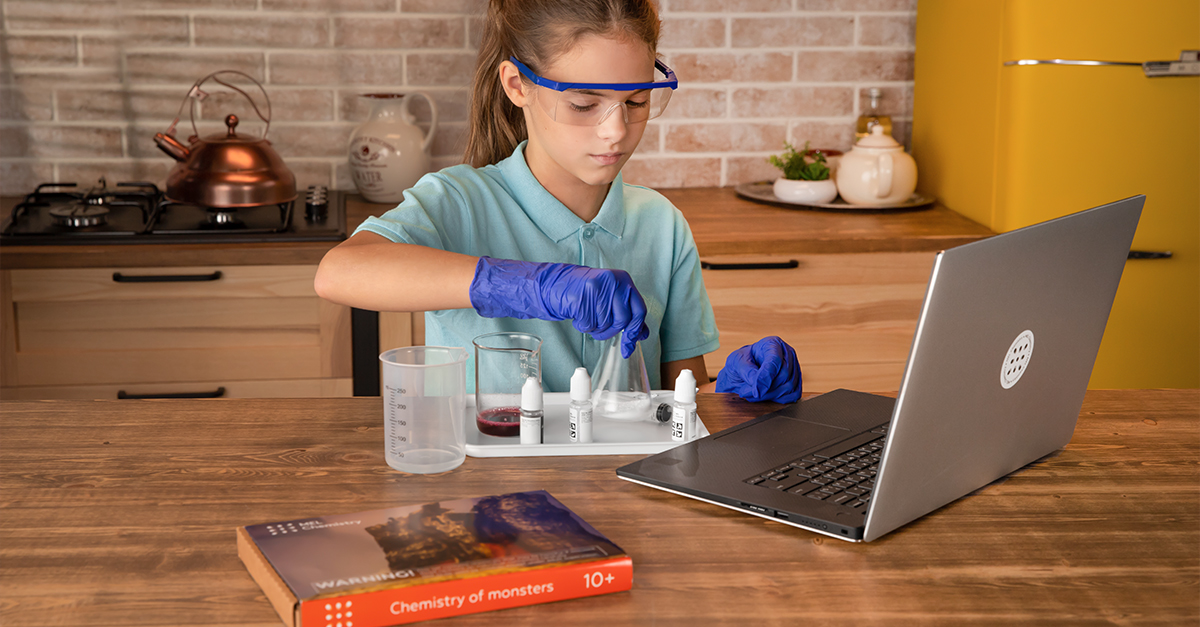
Designing and building a solar-powered car is an exciting and rewarding STEM project for elementary school students. This activity combines engineering, design, and environmental awareness as kids learn about the power of renewable energy and create their own solar-powered vehicles.
To gather materials such as a small solar panel, a motor, wheels, and a lightweight body made from recycled materials, you can create an alternative energy vehicle, like a balloon powered car.
Kids can design, build, and test their cars to see how well they perform in various conditions. This project not only imparts essential STEM concepts, but also cultivates an understanding of the importance of sustainable living and energy efficiency.
Water Filtration System
Clean water is essential for life, and understanding the science behind water filtration can help kids appreciate this vital resource. In this project, kids will create their own water filters using simple materials like:
- Plastic bottles
- Activated charcoal
By building their own water filtration system, kids will learn about the importance of clean water, the process of water filtration, and the effects of pollution on water sources. This practical activity not only imparts crucial STEM concepts, but also encourages kids to consider their actions’ environmental impact and the value of conservation.
Engaging STEM Projects for Middle School Students

Middle school students are ready to tackle more advanced STEM projects that challenge their critical thinking skills and creativity. Activities like coding challenges, bridge engineering, and circuit experiments provide the perfect opportunity for students to delve deeper into the world of STEM and apply their newfound knowledge to real-world problems.
These projects not only help students develop a strong foundation in STEM concepts, but also instill a sense of curiosity, determination, and resilience as they work through challenges and find innovative solutions. Let’s discover some intriguing STEM projects that middle school students can confidently undertake.
Coding Challenges

In today’s increasingly digital world, coding is a valuable skill that can open doors to exciting career opportunities. Introducing middle school students to computer programming through coding challenges and activities is a fantastic way to ignite their interest in this essential skill.
Platforms like Scratch and Code.org offer intuitive interfaces and engaging activities that make learning to code fun and accessible for students of all skill levels. Participation in coding challenges allows students to enhance their problem-solving skills, refine their logical thinking, and deepen their understanding of computer programming.
Bridge Engineering

Bridge engineering is an exciting STEM project that teaches students about engineering principles, materials, and construction techniques. By designing and building their own bridges, students can develop an understanding of the forces at play in bridge construction and the importance of strong, stable structures.
Using materials like toothpicks, popsicle sticks, or even newspaper, students can experiment with different building techniques and styles to create bridges that can support weight and span distances. This practical activity not only imparts essential STEM concepts, but also instills a sense of achievement and pride in their creations.
Circuit Experiments
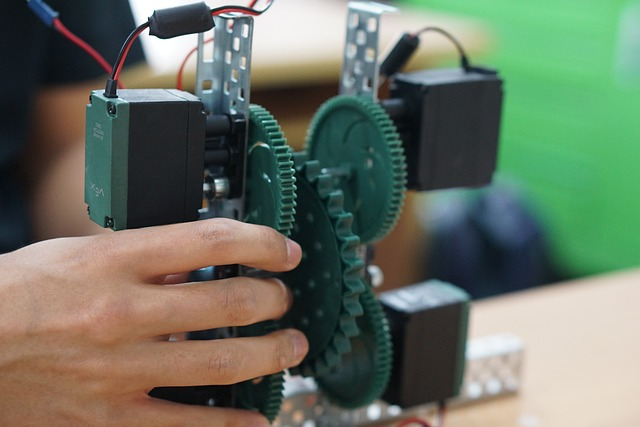
Electricity is a fundamental part of our daily lives, and understanding how circuits work is essential for students to grasp the principles of electrical engineering. Circuit experiments are a great way for middle school students to learn about electricity, components, and circuit design by building their own circuits using simple materials like batteries, wires, and light bulbs.
By creating and testing their own circuits, students can develop a hands-on understanding of how electrical components work together and the role of electricity in powering our devices. This captivating project not only imparts essential STEM concepts, but also ignites curiosity, encouraging students to delve into the intriguing world of electrical engineering.
Advanced STEM Projects for High School Students

High school students are ready to tackle advanced STEM projects that challenge their knowledge, creativity, and problem-solving skills. Activities like robot building, energy-efficient home design, and chemistry experiments provide the perfect opportunity for students to delve deeper into the world of STEM and apply their skills to real-world problems.
These projects not only help students develop a strong foundation in STEM concepts, but also instill a sense of curiosity, determination, and resilience as they work through challenges and find innovative solutions.
Let’s explore STEM projects that high school students can confidently undertake and discover captivating ideas through a fun stem challenge.
Robot Building
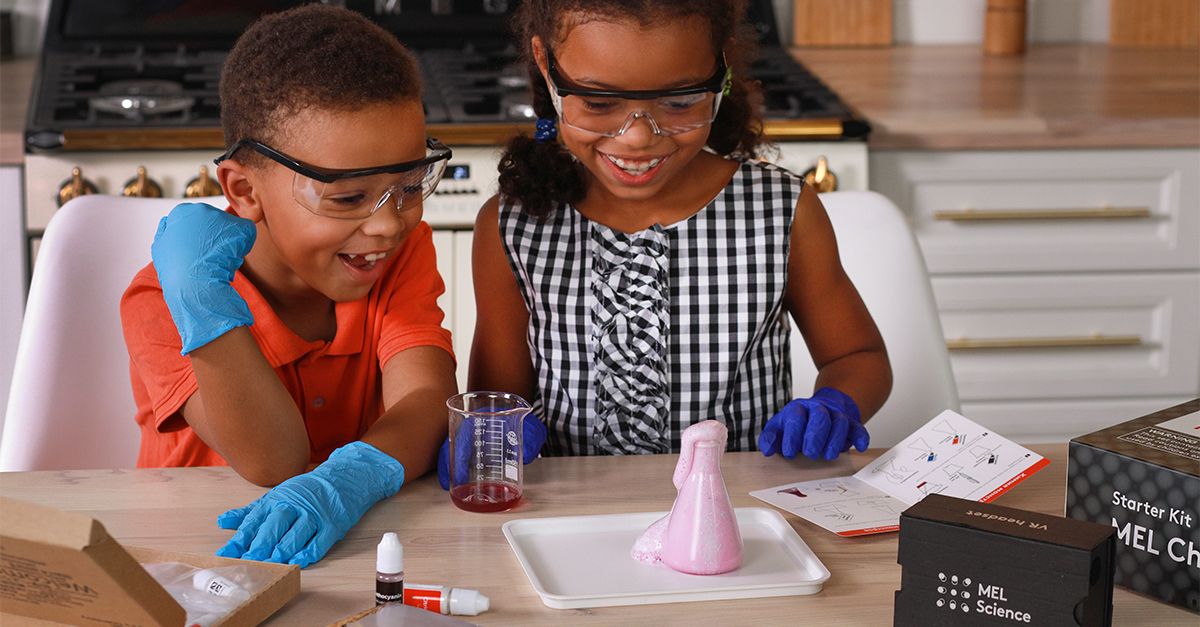
Robotics is an exciting and rapidly growing field, and introducing high school students to robot building is a fantastic way to ignite their interest in this cutting-edge discipline. Building robots not only teaches valuable engineering and programming skills, but also encourages creativity and innovation as students design their own robots using kits or DIY materials.
By constructing and programming their own robots, students can gain a hands-on understanding of how robotics technology works and the potential applications of robots in various industries. This captivating project not only imparts essential STEM concepts, but also ignites curiosity, encouraging students to delve into the intriguing world of robotics.
Energy-Efficient Home Design
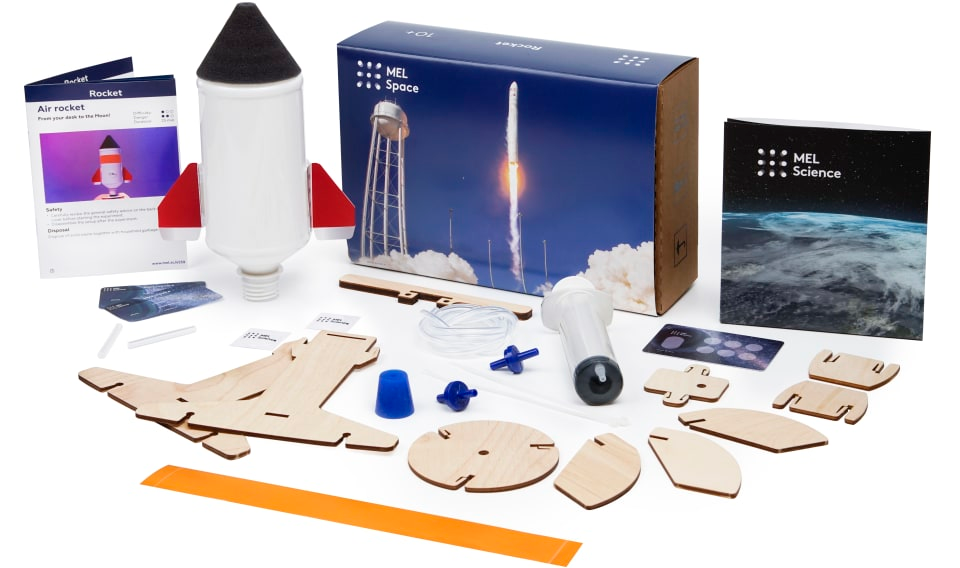
With growing concerns about climate change and the need for sustainable living, understanding energy-efficient home design is more important than ever. This project challenges high school students to design and build a model of an energy-efficient home, incorporating elements such as insulation, energy-efficient windows and doors, and renewable energy sources like solar panels.
By designing and constructing their own energy-efficient homes, students can develop an understanding of the importance of sustainable living and the role of energy efficiency in reducing our environmental impact. This practical activity not only imparts essential STEM concepts, but also fosters a sense of responsibility and awareness of the importance of conservation.
Chemistry Experiment
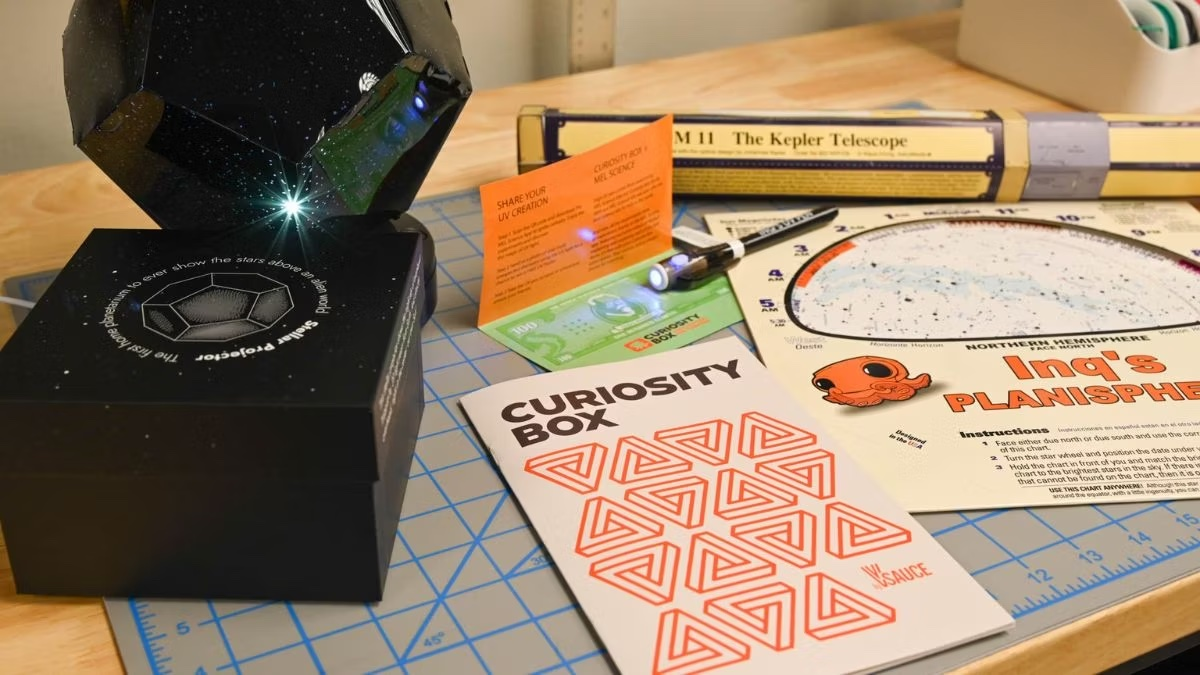
Chemistry experiments are an exciting way for high school students to explore the world of chemical reactions, properties of elements, and more. Hands-on experiments allow students to develop an understanding of the principles of chemistry and the role of chemical reactions in our daily lives.
By conducting their own chemistry experiments, students can gain a deeper understanding of the scientific method, develop critical thinking skills, and ignite their curiosity about the fascinating world of chemistry. This captivating project not only imparts essential STEM concepts but also encourages students to explore the marvels of science through engaging science experiments.
STEM Projects for the Whole Family
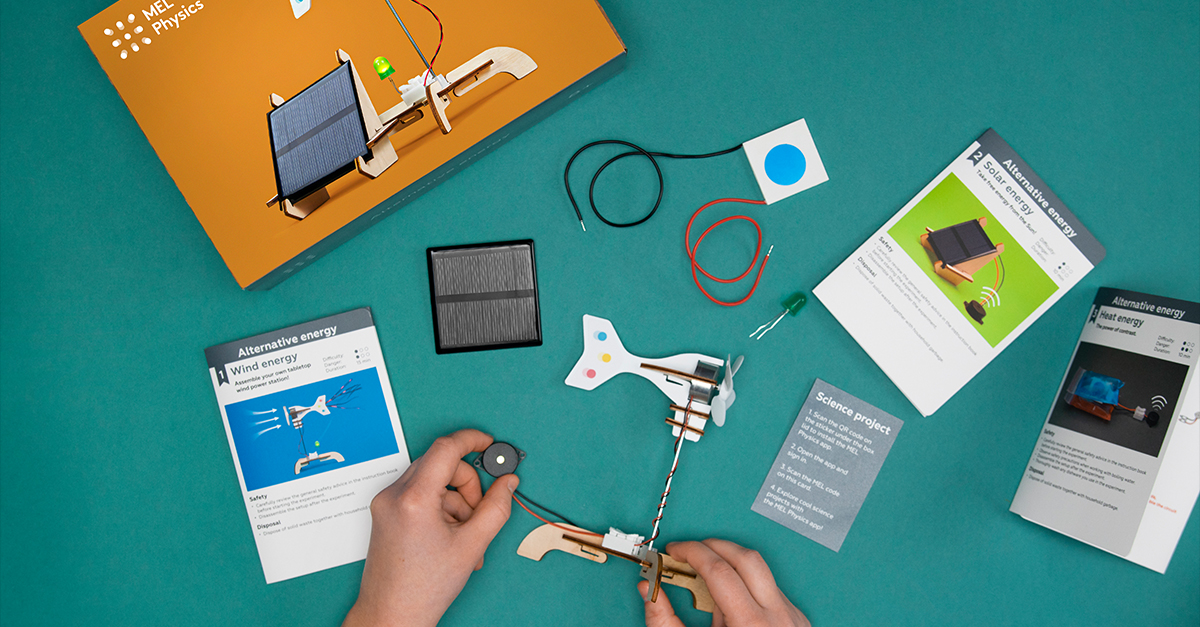
STEM projects aren’t just for kids! Engaging in STEM activities as a family is a fantastic way to bond, learn, and have fun together. Projects like homemade rocket launches, DIY telescope construction, and backyard weather stations are perfect for bringing the whole family together and sparking curiosity and creativity in everyone, regardless of age.
By participating in these family-friendly STEM projects, you’ll not only create lasting memories, but also instill a love for STEM in your children, setting them up for success in their future endeavors. So, gather the family and embark on some thrilling STEM projects that everyone can relish!
Homemade Rocket Launch
Launching homemade rockets is a thrilling and educational activity that’s perfect for the whole family. By building and launching rockets using simple materials like plastic bottles, baking soda, and vinegar, kids can learn about physics, aerodynamics, and the science behind rocket propulsion.
This practical activity not only offers a thrilling experience for the whole family, but also aids kids in developing a more profound understanding of rocketry principles and science’s role in powering our world. So, gather the family and prepare for lift-off with this enjoyable and educational project!
DIY Telescope Construction
Astronomy has fascinated humans for centuries, and building your own telescope is an exciting way for the whole family to explore the wonders of the night sky. Using simple materials like PVC pipes, lenses, and mirrors, kids can construct their own telescopes and learn about the principles of optics, astronomy, and the vast universe.
This practical activity not only offers an engaging learning experience for the whole family, but also fosters a sense of curiosity and awe about the universe. So gather your materials and set off on a starry journey with this DIY telescope project!
Backyard Weather Station
Understanding the weather is essential for everyday life, and building a backyard weather station is a fantastic way for the whole family to learn about meteorology and weather patterns. Using simple tools and materials, kids can create their own weather station that measures:
- Temperature
This practical activity not only imparts essential STEM concepts, but also encourages kids to develop an appreciation for the environment and the natural world. So, assemble the family and begin weather tracking with your very own backyard weather station!
In conclusion, STEM projects offer a world of exciting and educational opportunities for kids, students, and families alike. From fun and easy projects for young learners to engaging activities for middle and high school students, there’s a STEM project out there for everyone. By participating in these hands-on activities, we can foster a love for science, technology, engineering, and math, setting our children up for success in their future endeavors. So, whether you’re a parent, teacher, or student, dive into the exciting world of STEM and unleash your creativity, curiosity, and problem-solving skills!
Frequently Asked Questions
What is a good stem project.
The Egg Drop Challenge, DIY kite-building, solar oven-making, landmark building, and bridge-building are all great STEM projects for learning and fun.
Unleash your creativity to build something amazing!
What does STEM project mean?
STEM stands for science, technology, engineering and mathematics and is a learning approach that integrates these fields. It allows students to develop problem solving, creative, and critical analysis skills, making it an important priority for U.S. job markets.
STEM education is becoming increasingly important in the modern world, as it prepares students for the jobs of the future. It encourages students to think critically and develop skills that are essential for success in life.
What is STEM project in high school?
STEM projects in high school give students the opportunity to develop their skills in Science, Technology, Engineering and Mathematics in a fun and engaging way.
These projects can help students gain a better understanding of the concepts they are learning in the classroom, as well as giving them the chance to apply their knowledge in a practical setting. They can also help to develop problem-solving skills.
What are some cool STEM projects?
Explore the exciting world of STEM with these 10 simple and fun activities for kids - from building volcanoes to constructing paper circuits!
Unlock your child’s creativity and develop their science, engineering, and technology skills today.
What age group is most suitable for the STEM projects listed?
The STEM projects listed are best suited for elementary, middle, and high school students, as well as for the whole family.
Sign up for more like this.

ChatGPT for Teachers
Trauma-informed practices in schools, teacher well-being, cultivating diversity, equity, & inclusion, integrating technology in the classroom, social-emotional development, covid-19 resources, invest in resilience: summer toolkit, civics & resilience, all toolkits, degree programs, trauma-informed professional development, teacher licensure & certification, how to become - career information, classroom management, instructional design, lifestyle & self-care, online higher ed teaching, current events, stem projects that tackle real-world problems.

STEM learning is largely about designing creative solutions for real-world problems. When students learn within the context of authentic, problem-based STEM design, they can more clearly see the genuine impact of their learning. That kind of authenticity builds engagement, taking students from groans of “When will I ever use this?” to a genuine connection between skills and application.
Using STEM to promote critical thinking and innovation
“Educational outcomes in traditional settings focus on how many answers a student knows. We want students to learn how to develop a critical stance with their work: inquiring, editing, thinking flexibly, and learning from another person’s perspective,” says Arthur L. Costa in his book Learning and Leading with Habits of Mind . “The critical attribute of intelligent human beings is not only having information but also knowing how to act on it.”
Invention and problem-solving aren’t just for laboratory thinkers hunkered down away from the classroom. Students from elementary to high school can wonder, design, and invent a real product that solves real problems. “ Problem-solving involves finding answers to questions and solutions for undesired effects. STEM lessons revolve around the engineering design process (EDP) — an organized, open-ended approach to investigation that promotes creativity, invention, and prototype design, along with testing and analysis,” says Ann Jolly in her book STEM by Design . “These iterative steps will involve your students in asking critical questions about the problem, and guide them through creating and testing actual prototypes to solve that problem.”
STEM projects that use real-world problems
Here are some engaging projects that get your students thinking about how to solve real-world problems.
Preventing soil erosion
In this project, meant for sixth – 12th grade, students learn to build a seawall to protest a coastline from erosion, calculating wave energy to determine the best materials for the job. See the project.
Growing food during a flood
A natural disaster that often devastates communities, floods can make it difficult to grow food. In this project, students explore “a problem faced by farmers in Bangladesh and how to grow food even when the land floods.” See the project .
Solving a city’s design needs
Get your middle or high school students involved in some urban planning. Students can identify a city’s issues, relating to things like transportation, the environment, or overcrowding — and design solutions. See the project here or this Lego version for younger learners.
Creating clean water
Too many areas of the world — including cities in our own country — do not have access to clean water. In this STEM project, teens will learn how to build and test their own water filtration systems. See the project here .
Improving the lives of those with disabilities
How can someone with crutches or a wheelchair carry what they need? Through some crafty designs! This project encourages middle school students to think creatively and to participate in civic engagement. See the project here .
Cleaning up an oil spill
We’ve all seen images of beaches and wildlife covered in oil after a disastrous spill. This project gets elementary to middle school students designing and testing oil spill clean-up kits. See the project here .
Building earthquake-resistant structures
With the ever-increasing amount of devastating earthquakes around the world, this project solves some major problems. Elementary students can learn to create earthquake resistant structures in their classroom. See the project here .
Constructing solar ovens
In remote places or impoverished areas, it’s possible to make solar ovens to safely cook food. In this project, elementary students construct solar ovens to learn all about how they work and their environmental and societal impact. See the project here .
Stopping apple oxidization
Stop those apples from turning brown with this oxidation-based project. Perfect for younger learners, students can predict, label, count, and experiment! See the project here .
Advancing as a STEAM educator
The push for STEM has evolved into the STEAM movement, adding the arts for further enrichment and engagement. There are so many ways to embed STEM or STEAM lessons in your curriculum, but doing it well requires foundational knowledge and professional development. Imagine what type of impact you could have on your students and your community if you were supported by a theoretical framework, a variety of strategies, and a wealth of ideas and resources.
You may also like to read
- Teaching STEM: Challenging Students to Think Through Tough Problems
- Professional Development Resources for STEM Teachers
- What is the Washington State STEM Lighthouse Program?
- Characteristics of a Great STEAM Program
- Building a Partnership Between Your School and a STEAM Organization
- The Art of Inquiry in STEAM Education
Categorized as: Tips for Teachers and Classroom Resources
Tagged as: Art , Educational Technology , Engaging Activities , Math and Science , Science , STEAM
- Online & Campus Master's in Elementary Educat...
- 2020 Civics Engagement & Resilience: Tools fo...
- Online & Campus Master's in Curriculum Develo...
Science Bob
- Experiments
- Science Fair Ideas
- Science Q&A
- Research Help
- Experiment Blog
Okay, this is the hardest part of the whole project…picking your topic. But here are some ideas to get you started. Even if you don’t like any, they may inspire you to come up with one of your own. Remember, check all project ideas with your teacher and parents, and don’t do any project that would hurt or scare people or animals. Good luck!
- Does music affect on animal behavior?
- Does the color of food or drinks affect whether or not we like them?
- Where are the most germs in your school? ( CLICK for more info. )
- Does music have an affect on plant growth?
- Which kind of food do dogs (or any animal) prefer best?
- Which paper towel brand is the strongest?
- What is the best way to keep an ice cube from melting?
- What level of salt works best to hatch brine shrimp?
- Can the food we eat affect our heart rate?
- How effective are child-proof containers and locks.
- Can background noise levels affect how well we concentrate?
- Does acid rain affect the growth of aquatic plants?
- What is the best way to keep cut flowers fresh the longest?
- Does the color of light used on plants affect how well they grow?
- What plant fertilizer works best?
- Does the color of a room affect human behavior?
- Do athletic students have better lung capacity?
- What brand of battery lasts the longest?
- Does the type of potting soil used in planting affect how fast the plant grows?
- What type of food allow mold to grow the fastest?
- Does having worms in soil help plants grow faster?
- Can plants grow in pots if they are sideways or upside down?
- Does the color of hair affect how much static electricity it can carry? (test with balloons)
- How much weight can the surface tension of water hold?
- Can some people really read someone else’s thoughts?
- Which soda decays fallen out teeth the most?
- What light brightness makes plants grow the best?
- Does the color of birdseed affect how much birds will eat it?
- Do natural or chemical fertilizers work best?
- Can mice learn? (you can pick any animal)
- Can people tell artificial smells from real ones?
- What brands of bubble gum produce the biggest bubbles?
- Does age affect human reaction times?
- What is the effect of salt on the boiling temperature of water?
- Does shoe design really affect an athlete’s jumping height?
- What type of grass seed grows the fastest?
- Can animals see in the dark better than humans?
Didn’t see one you like? Don’t worry…look over them again and see if they give you an idea for your own project that will work for you. Remember, find something that interests you, and have fun with it.
To download and print this list of ideas CLICK HERE .

- The scientific method
- science fair resources
- a little helpful advice
ADS (these ads support our free website)
Share this page.

15 Cool Science Fair Projects

Hoping to enter a science fair for kids but not sure where to begin? The purpose of science fair projects are about more than simply coming up with a cool idea and sharing it with others.
Aside from the competitive glory of competing (and maybe winning) at a science fair, kids gain experience working with the scientific method: asking questions, forming hypotheses, testing, collecting data, and sharing results with others. Aside from these fundamental STEM skills, kids also gain valuable experience in collaboration, organizational skills, problem solving, communication, and creativity, turning that cool science fair project into a stepping stone on the path towards a career in science.
Join live online, small-group science classes led by an expert, to learn new skills to give you all sorts of science project ideas, including in Quantum Frontiers , NASA Science , Smart Devices , and Minecraft Redstone Engineering .
Discover cool science fair projects
In this list, we will share some awesome ideas for students and educators to get inspired and to make a project that will leave a lasting impression. Of course, there’s a huge gap between a beginner’s project and that of a competitive high schooler, but we have arranged it so you can easily find something for young explorers of all ages.
Explore the best science fair projects for elementary kids
While classic projects like making a cyclone in a bottle or stacking liquids to teach density can make a lasting impact on kids, these projects offer some unique ways of getting elementary schoolers to engage with science.
1. LEGO Zipline
Kids love LEGO and this project only requires a few blocks and some lengths of string. Projects can teach kids about Physics concepts like gravity, tension, friction, as well as Math ideas like slope, angle, and weight. Set a large slope to make the zip line fast, and add slack to the line to slow it down. You could even arrange this project as a race.
2. Slow Ball Race
Another race idea involves building a tower of ramps to allow a ball to roll down. To give your students a unique challenge, instead of making the ball rush to the bottom, you can have them compete to see who makes the ball reach the bottom slowest. All you need are some building materials (paper, cardboard, or plastic) and a ball, ideally something small and smooth like a ping pong ball.
3. Hot/Cold Water Density Project
For this project, students will only need some clear containers of the same size, hot and cold water and food coloring. Students will study the characteristics of water and how its density changes based on temperature. By adding one color to the cold and another to the hot, students then will stack the openings on top of each other, and if done correctly, the different temperature liquids will remain separate. Pretty cool.
4. Soil Erosion in a Bottle
This simple project requires garden soil, some plants with roots in the soil, and three clear soda bottles. After cutting out the side of each bottle, they will then be filled with different materials. In one bottle there will be simple soil, in another the soil could be mixed with rocks, branches, and other large chunks. In the final bottle, students will plant some flowers, whose roots will prevent the soil from eroding. As water is poured through the others, students will witness how plants help preserve and retain our most precious resource: the Earth.
5. Water Filtration
In another climate science project, students will use a variety of materials to experiment with water filtration. By pouring dirty water through a mix of sand, charcoal, rocks, and debris, students can collect the filtered water and demonstrate how clean it is by passing through the filter. This could be a supplement to conversations about the water cycle.
See the best science fair project ideas for middle school kids
Middle schoolers will be able to do more independent projects, and they should have a higher bar for formulating a hypothesis and repeatedly testing it. By analyzing the data in a group, students can improve their verbal reasoning skills in a team.
6. Seed Sprouting Experiment
With some seeds and some containers filled with various growing media (sand, soil, mulch, compost, etc.), students can test which material is ideal for sprouting seeds. Students can also study ideas of sustainability, food security, and climate change/soil erosion as part of their project.
7. Newton’s Balloon Car
“For every action there is an equal and opposite reaction,” is one of the most famous quotes in science and engineering, and one of Sir Isaac Newton’s most famous Laws of the physical world. Middle school students can experience this law first hand by building a toy car that propels itself with the expelled air of an inflated balloon. Kids love this experiment because it can be presented as a race.
8. Geodesic Domes
The geodesic dome joins the arch as one of the strongest physical structures in architecture and engineering. Students can test different materials and design strategies to build a dome that supports as much load as possible. Maybe teams can try to build a structure that carries the load of a human being!
9. The Greenhouse Effect
All students need for this experiment are a jar, some cellophane wrap, a thermometer, and a sunny window. If you want, students can opt for a heat lamp as well. By covering one jar and leaving one uncovered, this experiment can demonstrate in miniature how the atmosphere captures heat and warms the planet. This of course is a perfect experiment to introduce younger kids about the fundamentals of weather and climate science.
10. Coding in LEGO
As Computer Science plays a huge role in shaping the technologies kids love (Did someone say ‘video games’?), no age is too young to learn about coding and computer science concepts like algorithms, loops, functions, and Binary. In these exciting games, students combine their LEGO creation skills to build an algorithm that can be played like a game, using binary to help a LEGO figurine move through a LEGO environment. LEGO was one of our favorite toys as a kid, and this would be an amazing chance to get kids excited about coding early.
To learn beginner-friendly coding with the help of a live expert, join our free Scratch class:
Check out the best science fair projects for high school students
High school science fair projects should be sophisticated and nuanced in their design, analysis, and reporting. Since science fairs can be an important part of getting scholarships and advanced academic placements, high schoolers should be challenged to do college level work in their projects, and hopefully these ideas will help them find something.
11. Enzymes, Yeast, and Cheesemaking
Say Cheese! No, seriously, who doesn’t love cheese? Well, actually the science says that most people are at least a little bit lactose intolerant, but that shouldn’t stop aspiring chefs and chemists from trying out this cool project where students try to use cheesemaking kits to test the chemistry behind this delicious cheese. Kits like the one below are available online and contain not only the materials to make cheese, but also guidelines to build a proper science experiment.
12. Robotics
There has never been a better time to become a robotics scientist. (Seriously, check out the history of robotics !) With the advent of semiconductors, advanced circuits, and tools like 3-D printers and tiny Raspberry Pi computers, students can build a robot from the ground up to solve everyday problems, to interact with humans or nature, to complete human tasks, or to simply tell a story. The possibilities are endless!
To learn more about robotics with the help of a purposeful curriculum and live expert, join our award-winning robotics class.
13. Raspberry Pi
Did we mention Raspberry Pi? Do you want to build your own computer from the circuit board up? These cool little computers are a lot more powerful than their size makes it seem. Students can customize their circuits to build a video-streaming device, a musical instrument like a synthesizer or a drum machine, or a game. There's a bunch of models out there for different budgets or for different purposes, so students should begin with an idea or something they want to do before buying one.
14. Bioassay for Toxicity
In this type of experiment students can test crops for resiliency against drought, flood, or other extreme weather conditions. Students could test to see what level of salt in the soil is ideal for growing crops, and at what point does the salt become toxic? Environmental engineering is a major part in the fight against climate change, and we need scientists to propose solutions to ensure greater food security in the future.
15. Electrolytes in Various Liquids
Is it better to drink sports drinks or a glass of water after a period of exercise? Many products are sold on the promise of delivering electrolytes to help the body recover, but are sports drinks better than a simple glass of orange juice? Using an electrically charged wire, students can test the levels of electrolytes in liquids to both study chemistry and nutrition science in one project.
Bonus. Coding Projects
Now is a great time to learn how to code software. Students have a limitless supply of resources on the Internet, and learning how to do proper Internet research is a fundamental skill for academic success. Students will work in a programming environment like Scratch or Python to build a unique project such as a game to demonstrate their understanding of variables , algorithms , loops , functions, and other CS fundamentals. This project suggests building a program in Python that tests the hackability and strength of passwords.
Enjoy the best science fair project ideas
So that’s our list so far, but there’s a lot of great ideas out there for students heading to their first science fair in elementary school or competing at the national level against the best students in the country. Whether young or old, these projects can turn the key and get kids excited about learning in STEM . Whatever you choose, try to make it stand out by making it your own!
Written by Bryan Gordon, a Create & Learn instructor. After ten years of working as an English teacher, Bryan began studying Math and Computer Science over the past few years. Aside from writing and teaching, he likes cooking, gardening, playing guitar, and hanging out with his cats, Baguette and Wally.
You Might Also Like...
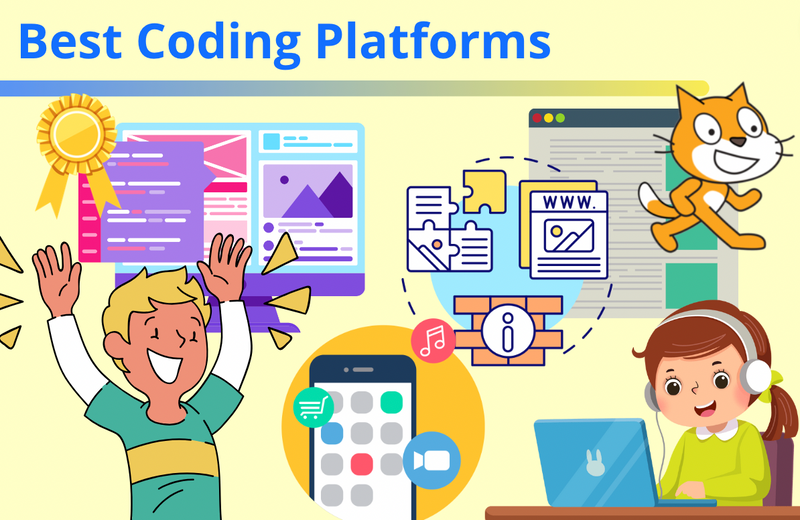
15 Remarkable Online Coding Platforms for Kids & Teens

25 Inspiring Computer Science Quotes
Science Fair Project Ideas
- Ph.D., Biomedical Sciences, University of Tennessee at Knoxville
- B.A., Physics and Mathematics, Hastings College
Science fair is an opportunity for students of all ages to ask big questions, conduct meaningful research, and make exciting discoveries. Browse hundreds of science fair project ideas to find the ideal project according to grade level.
Preschool Science Project Ideas
Preschool is not too early to introduce children to science! Most preschool science ideas aim to interest kids in exploring and asking questions about the world around them.
- Play with silly putty and examine its properties.
- Look at flowers. How many petals does each flower have? What parts do flowers share in common?
- Blow up balloons. What happens when you release an open balloon? What happens when you rub a balloon on your hair?
- Explore color with fingerpaints.
- Blow bubbles and look at how bubbles interact with each other.
- Make a telephone with cups or cans and some string.
- Have preschoolers categorize objects into groups. Discuss similarities and differences between objects.
Grade School Science Project Ideas
Students are introduced to the scientific method in grade school and learn how to propose a hypothesis . Grade school science projects tend to be quick to complete and should be fun for the student and the teacher or parent. Examples of suitable project ideas include:
- Determine whether insects are attracted to lights at night because of their heat or their light.
- Does the type of liquid (e.g., water, milk, cola) affect seed germination?
- Does the power setting of the microwave affect how many unpopped kernels are in popcorn?
- What happens if you pour a liquid other than water through a pitcher-type water filter?
- What type of bubble gum produces the biggest bubbles?
Middle School Science Fair Ideas
Middle school is where kids can truly shine at the science fair! Kids should try to come up with their own project ideas, based on topics that interest them. Parents and teachers may still need to help with posters and presentations, but middle school students should have control of the project. Examples of middle school science fair ideas include:
- Examine food labels. How does the nutritional data for different brands of the same food (e.g., microwave popcorn) compare?
- Is laundry detergent effective if you use less than the recommended amount?
- How permanent are permanent markers? Are there chemicals that will remove the ink?
- Can a saturated solution of salt still dissolve sugar?
- Do green bags really preserve food longer?
- Are goldfish water chemicals really necessary?
- What shape of ice cube melts the slowest?
High School Science Fair Ideas
High school science fair projects can be about more than a grade . Winning a high school science fair can net some nice cash prizes, scholarships, and college/career opportunities. While it's fine for an elementary or middle school project to take hours or a weekend to complete, most high school projects run longer. High school projects typically identify and solve problems, offer new models, or describe inventions. Here are some sample project ideas:
- Which natural mosquito repellents are most effective?
- Which home hair color holds its color through the most washings?
- Do people who play car racing video games have more speeding tickets?
- Which high school sport is associated with the most injuries?
- What percentage of left-handed people use a computer mouse with their left hand?
- What season is worst for allergies and why?
College Science Fair Ideas
Just as a good high school idea can pave the way for cash and college education, a good college project can open the door to graduate school and gainful employment. A college project is a professional-level project that shows you understand how to apply the scientific method to model a phenomenon or answer a significant question. The big focus on these projects is on originality, so while you might build on a project idea, don't just use one someone else has already done. It's fine to use an old project and come up with a new approach or different way of asking the question. Here are some starting points for your research:
- What plants can detoxify gray water flowing from a home?
- How could the timing of a traffic light be changed to improve intersection safety.
- Which home appliances use the most power? How could that energy be conserved?
This content is provided in partnership with National 4-H Council. 4-H science programs provide youth the opportunity to learn about STEM through fun, hands-on activities and projects. Learn more by visiting their website.
- Chemistry Science Fair Project Ideas
- Elementary School Science Fair Projects
- 11th Grade Science Fair Projects
- Middle School Science Fair Project Ideas
- High School Science Fair Projects
- 5 Types of Science Fair Projects
- 6th Grade Science Fair Projects
- 3rd Grade Science Fair Projects
- 7th Grade Science Fair Projects
- Biology Science Fair Project Ideas
- Kindergarten Science Projects
- Science Fair Project Help
- Grade School Science Fair Project Ideas
- How to Select a Science Fair Project Topic
- Science Fair Project Ideas for 12th Graders

Home » Tips for Teachers » 14 Engaging Science Fair Projects for 3rd Graders to Ignite Curiosity and Explore the Wonders of the Natural World
14 Engaging Science Fair Projects for 3rd Graders to Ignite Curiosity and Explore the Wonders of the Natural World
In 3rd grade, science education plays a transformative role in shaping young minds. As students progress from foundational learning to deeper understanding, their curiosity reaches its peak. Engaging science fair projects offer a gateway to scientific discovery, moving beyond traditional classroom teaching. By creating, executing, and presenting these projects, 3rd graders gain insights into scientific concepts and develop essential skills.
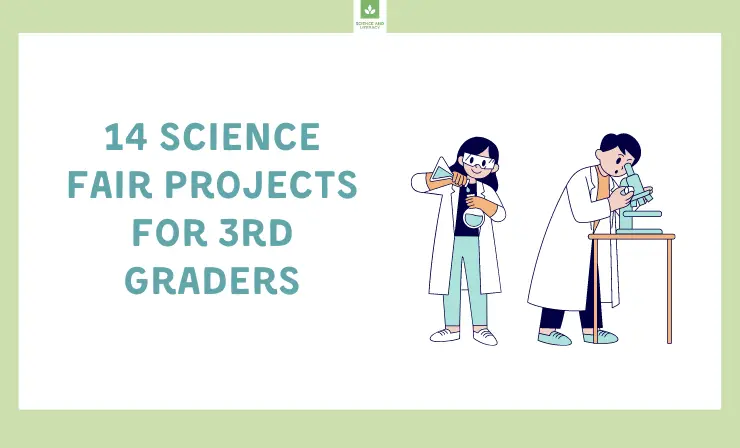
Science fair projects provide immersive experiences fueled by curiosity. Students become architects of their learning, exploring real-world phenomena, asking questions, and seeking answers. Bridging theory with practice, these projects make science tangible, igniting enthusiasm among young learners.
The impact of science fair projects extends beyond science itself. They foster critical thinking, nurture creativity, hone problem-solving abilities, and refine communication skills. This holistic approach blends knowledge with practicality, curiosity with collaboration, and individual exploration with shared learning.
In the upcoming sections, we’ll explore 14 tailored science fair projects for 3rd graders. Each project aims not only to educate but also to spark wonder and excitement, leaving a lasting impression. Through these projects, we’ll witness the magic of education and curiosity intertwining, creating a vibrant tapestry of knowledge, growth, and an insatiable thirst for discovery.
After reading this article, you’ll get to know about:
- The Significance of Science Education in 3rd Grade→
4 Benefits of Science Fair Projects
- What Do 3rd Graders Learn in Science?→
Discover the Importance of Science Education in 3rd Grade, Uncover the 4 Advantages of Science Fair Projects, and gain insight into the science curriculum for 3rd graders before diving into the projects.
The Significance of Science Education in 3rd Grade
The 3rd grade marks a pivotal point in a student’s educational journey, representing a phase of immense growth and cognitive development. As young learners transition from foundational skills to more advanced learning, their minds become fertile ground for cultivating a deeper understanding of the world. In the 3rd grade, students begin to bridge the gap between concrete and abstract thinking, as their cognitive abilities evolve to encompass more complex concepts.
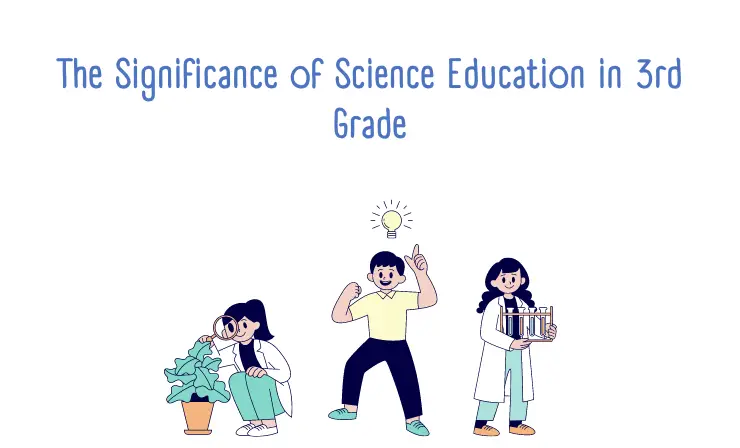
At this juncture, children are not only curious about the world but are also developing the cognitive tools to explore it in a systematic and structured manner. Their emerging ability to think logically, ask probing questions, and apply critical thinking to their observations makes the 3rd grade a fertile ground for introducing science education. By nurturing this curiosity through science education, educators lay the foundation for a lifelong appreciation of the subject. This early exposure to scientific concepts equips students with the foundational knowledge and skills necessary for their future academic pursuits and prepares them to be informed, engaged citizens who can navigate an increasingly complex and scientific world.
Science fair projects offer a myriad of invaluable benefits to 3rd graders that extend far beyond the classroom walls:
- These projects serve as a bridge that connects theoretical knowledge with real-world applications, providing hands-on learning experiences that are both tangible and relatable. By engaging with scientific concepts through practical experimentation, students develop a deeper understanding of the subject matter. As they actively participate in designing, conducting, and analyzing experiments, they transition from passive recipients of information to active contributors in their own education.
- Furthermore, the process of planning and executing science fair projects cultivates essential life skills. Teamwork is fostered as students collaborate with peers, brainstorm ideas, and share responsibilities. Effective communication skills are honed as students articulate their hypotheses, methodologies, and findings to their classmates, teachers, and parents. Presentation skills are polished as they deliver their findings in an organized and engaging manner, fostering confidence and poise from an early age.
- Additionally, science fair projects spark curiosity and a genuine excitement for learning. The hands-on nature of these projects taps into students’ innate desire to explore and discover, making learning an immersive and enjoyable experience. This, in turn, paves the way for the development of a growth mindset, encouraging students to embrace challenges, learn from failures, and persist in the face of difficulties.
- In essence, science fair projects are vehicles of holistic education. They not only convey scientific principles but also instill essential life skills, foster a passion for learning, and prepare 3rd graders for the ever-evolving demands of the future. Through the process of active exploration and discovery, these projects empower young learners to become confident, curious, and capable individuals who approach both education and life with a sense of wonder and possibility.
What Do 3rd Graders Learn in Science?
In the realm of 3rd-grade science education, students embark on a journey of discovery that mirrors the immersive nature of the curated science fair projects. The foundation is laid through the introduction of fundamental scientific concepts and processes. Much like the science projects encourage experimentation and communication, students learn the art of scientific observation, hypothesis formation, and experimental design. These skills not only echo the hands-on approach of the projects but also equip 3rd graders with the ability to investigate the world around them and effectively convey their findings.
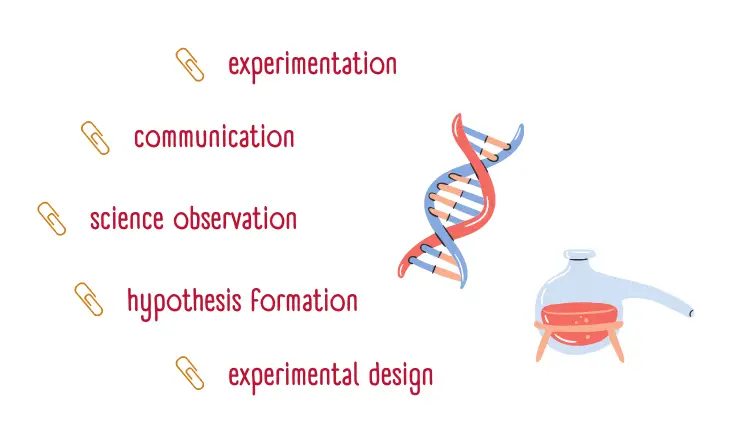
Beyond the building blocks, 3rd graders delve into the diverse branches of science—life science, earth science, and physical science. This mirrors the multidisciplinary nature of the projects, where young learners encounter a tapestry of scientific realms. In life science, they explore living things, their characteristics, and ecosystems, paralleling their interaction with the natural world through experiments. The explorations extend to earth science, where they delve into the planet’s structure, atmosphere, and climate, mirroring their hands-on engagement with the environment. In the realm of physical science, students comprehend matter, energy, and motion, aligning with their manipulation of materials in experiments.
As students navigate the dynamic landscape of 3rd grade science, they foster critical thinking akin to the problem-solving elements of the science fair projects. By asking questions, analyzing data, and drawing conclusions, students are primed to address challenges and dissect complex scenarios. Just as the projects encourage drawing insights from data, 3rd graders are equipped to unravel patterns, make informed decisions, and approach problems strategically.
Furthermore, the correlation between 3rd grade science and everyday life mirrors the practical applications emphasized in the science fair projects. By recognizing the impact of the water cycle on agriculture or understanding the force of gravity’s influence, students grasp the tangible relevance of their scientific knowledge. This parallel enables them to appreciate science’s profound effects on the world, just as the projects merge theory with practice. The connections formed between 3rd grade science and everyday life cultivate a deeper understanding, inspiring students to pursue lifelong learning and cultivate a genuine affection for the realm of science.
My 3rd grader is doing her first science fair project, and it’s somehow one that I don’t already know the outcome for. She’s looking at how temperature affects magnetic strength. We’ll do a bunch of runs of using a magnet to pick stuff up at room temp, 1/x — Humphrey Bogart’s Hairpiece (@Onychomys2) March 22, 2023
14 Engaging Science Fair Projects for 3rd Graders
Now, let’s delve into the realm of science fair projects. Explore a range of projects accompanied by detailed descriptions and instructional videos. These projects are designed to be relatively simple to execute, although occasional assistance from adults may be necessary for children.
1. Floating Egg Experiment
Explore the concept of buoyancy with this experiment. By adding salt to water in a tall glass, you’ll observe an egg floating. Discover the science behind why certain objects float while others sink.
Materials: Eggs, salt, water, tall glass
Level of Difficulty: Easy
- Fill a tall glass with water.
- Gently place an egg into the water. Observe that it sinks.
- Begin adding salt to the water while stirring until the egg starts to float.
- Record your observations and note the amount of salt required.
- Research and explain the scientific principles behind buoyancy and density.
View the video and adhere to the provided instructions. The video serves as an illustrative demonstration of how the experiment can be conducted.
2. Balloon Rocket Race
Embark on a journey to uncover Newton’s third law of motion. Create a balloon rocket by attaching a straw to a balloon and securing it with tape. Release the air from the balloon to propel the rocket forward and measure its distance traveled.
Materials: Balloon, string, straw, tape
Level of Difficulty: Moderate
- Attach a straw to a balloon using tape, ensuring it’s secure.
- Thread a length of string through the straw, creating a taut line.
- Find an open space and have a friend hold the string taut.
- Inflate the balloon and release the air, propelling the rocket along the string.
- Measure the distance the rocket traveled and record the results.
- Research and explain Newton’s third law of motion and the forces at play.
The video presents a demonstration of the experiment’s procedural steps. Additionally, the experiment can be undertaken as a challenge.
3. Rainbow in a Jar
Dive into the world of density by creating a rainbow in a jar. Layer liquids of different densities – honey, dish soap, water, and food coloring – to witness stunning separation and understand the principles of density.
Materials: Honey, dish soap, water, food coloring
- Gather the liquids: honey, dish soap, water, and food coloring.
- Start by adding the heaviest liquid, honey, to the jar.
- Carefully pour the dish soap, followed by water and a drop of food coloring.
- Observe the distinct layers forming in the jar.
- Research and explain the concept of density and how liquids with different densities interact.
This video provides an explanation of density and illustrates the process of conducting the experiment. The video can serve as an instructional guide for performing the experiment.
4. Simple Circuit Project
Immerse yourself in the realm of electricity through a basic circuit project. Construct a simple circuit using a battery, wires, a bulb, and paper clips. Illuminate the bulb by completing the circuit, gaining insights into electricity flow and switches.
Materials: Battery, bulb, wires, paper clips
- Gather the materials: battery, bulb, wires, and paper clips.
- Connect one end of a wire to the positive terminal of the battery and the other end to one side of the bulb.
- Attach a second wire to the negative terminal of the battery and the other end to the opposite side of the bulb.
- Use a paper clip to bridge the gap between the two ends of the wires, completing the circuit and illuminating the bulb.
- Experiment with switches by inserting a paper clip between the wires to break the circuit and turn off the bulb.
- Research and explain the flow of electricity in a circuit and how switches control it.
This video functions as a visual guide, offering instructions that can be utilized during your preparation for a science fair project.
5. Plant Life Cycle Observation
Witness the stages of plant growth with this project. Plant bean seeds in pots, nurture them with soil and water, and observe their transformation from seeds to thriving plants.
Materials: Bean seeds, pots, soil, water
- Fill pots with soil and make a small hole in each.
- Plant bean seeds in the holes and cover them with soil.
- Water the pots regularly and ensure they receive sunlight.
- Observe and document the growth stages of the plants, including seed germination, sprouting, leaf development, and flowering.
- Research and explain the various stages of a plant’s life cycle.
This video offers a valuable resource for students aiming to enhance their science fair presentations. It provides comprehensive insights into the different stages of a plant’s transformation from a seed to a fruit. The content is skillfully simplified to cater to the understanding of primary school students, making it a useful tool for speech preparation.
6. Solar System Model
Embark on a cosmic journey by crafting a solar system model. Use different-sized balls and objects to represent the planets and their positions relative to the sun. Paint and label each planet to create a visually accurate representation of our solar system. Present your model and explain the order of the planets, their unique characteristics, and their relationship to the sun. This project offers an interactive way to learn about the vastness of space and the arrangement of celestial bodies.
Materials: Various-sized balls, paint, labels
- Gather different-sized balls to represent the planets. Use a larger ball for the sun.
- Paint each ball according to the color of the corresponding planet.
- Arrange the balls in their proper order and distance from the sun, following the real solar system layout.
- Label each planet with its name and distance from the sun.
- Research and explain the unique characteristics of each planet and their positions in the solar system.
- Present your solar system model and demonstrate your knowledge of the planets’ arrangement and features.
This video illustrates a method for painting your own planets. It provides a simple and efficient technique to create your customized solar system model quickly.
7. Volcano Eruption
Embark on an explosive journey by creating your own miniature volcano. Craft the volcano using clay, then simulate an eruption by combining baking soda and vinegar. Observe the chemical reaction that triggers the eruption and learn about volcanic processes in a fun and interactive way.
Materials: Baking soda, vinegar, clay, dish soap
- Mold the clay into a volcano shape, leaving an opening at the top.
- Place the clay volcano on a tray or container to catch the eruption.
- Add a small amount of baking soda into the volcano’s opening.
- Mix dish soap with vinegar in a separate container.
- Pour the vinegar and dish soap mixture into the volcano.
- Observe the eruption as the mixture reacts with the baking soda, creating a bubbly foam that mimics volcanic activity.
- Research and explain the chemical reaction between baking soda and vinegar that causes the eruption.
The video showcases the process of creating a volcano and demonstrates how to conduct the associated experiment. By watching the video, you can learn how to construct your own volcano and replicate the experiment for yourself.
8. Homemade Lava Lamp
Fuse science and art with a homemade lava lamp experiment. Mix water, oil, and food coloring in a clear container, then drop an effervescent tablet to witness mesmerizing bubbles that resemble a lava lamp. Explore the science of density and chemical reactions while creating a visually captivating display.
Materials: Water, oil, food coloring, effervescent tablet
- Fill a clear container with water, leaving some space at the top.
- Add vegetable oil to the container, ensuring it forms a separate layer on top of the water.
- Add a few drops of food coloring to the oil, which will gradually sink into the water.
- Break an effervescent tablet into smaller pieces.
- Drop a piece of the tablet into the container and observe as it interacts with the liquids.
- Witness mesmerizing bubbles that rise from the oil layer to the water layer and back.
- Research and explain the science behind the formation of bubbles due to chemical reactions and the role of density in this process.
This video provides detailed instructions on creating 11 different types of DIY lava lamps. Explore various methods and techniques to make your own mesmerizing lava lamp creations.
9. Static Electricity Butterfly
Unleash the power of static electricity by creating a butterfly that “flies” with the touch of a balloon. Inflate the balloon and generate static electricity, causing the tissue paper butterfly to levitate. Understand the science behind static charges and engage in a playful exploration of electric forces.
Materials: Balloon, tissue paper, thread
- Inflate a balloon and tie it to a stationary object.
- Cut out a butterfly shape from tissue paper and attach a piece of thread to its center.
- Rub the balloon against your hair or clothing to generate static electricity.
- Hold the charged balloon near the tissue paper butterfly.
- Observe as the butterfly is attracted to the balloon and hovers in the air due to the static charges.
- Experiment with different objects and distances to control the butterfly’s movement.
- Research and explain the phenomenon of static electricity and how opposite charges attract.
Watch the video to gain insights into the preparation process for the Static Electricity Butterfly science project. Discover the steps and materials required to successfully undertake this engaging experiment.
10. Bouncing Egg Experiment
Discover the extraordinary properties of eggs by conducting a bouncing egg experiment. Submerge a raw egg in vinegar to dissolve the shell, leaving behind a bouncy, membrane-covered egg. Explore the concept of osmosis and observe the egg’s transformation while investigating the inner workings of cellular membranes.
Materials: Raw egg, vinegar
- Place a raw egg gently into a clear container.
- Carefully pour enough vinegar into the container to fully submerge the egg.
- Observe the initial reaction between the eggshell and the vinegar, which will create bubbles.
- Cover the container and let it sit for at least 24 hours.
- After 24 hours, carefully remove the egg from the vinegar and rinse it with water.
- Gently tap the egg on a surface to see how bouncy it has become due to the membrane.
- Research and explain the scientific processes of osmosis and the dissolution of the eggshell.
Observe the video to understand the essential steps in preparing for the Bouncing Egg science project. Acquire valuable insights into the necessary materials and procedures to effectively conduct this engaging experiment.
11. Solar Oven
Harness the power of the sun by constructing a solar oven using a shoebox, aluminum foil, and plastic wrap. Use the oven to heat small items and understand the principles of solar energy conversion. Delve into sustainable energy sources and the potential of harnessing sunlight for practical applications.
Materials: Shoebox, aluminum foil, plastic wrap
- Line the inside of the shoebox with aluminum foil, ensuring it’s reflective.
- Cut a flap in the box lid and cover it with plastic wrap, securing it with tape.
- Place small items, such as marshmallows or chocolate, on a tray inside the box.
- Set up the solar oven in direct sunlight, adjusting the flap to focus sunlight onto the tray.
- Monitor the temperature inside the oven using a thermometer.
- Observe as the items on the tray heat up and potentially melt.
- Research and explain the principles of solar energy conversion and its applications.
View the video tutorial to gain comprehensive guidance on preparing for the Solar Oven science project. Acquire a clear understanding of the required materials and step-by-step procedures to successfully execute this captivating experiment.
12. Water Cycle in a Bag
Condense the water cycle into a simple yet enlightening experiment. Fill a ziplock bag with water, seal it, and observe the water cycle in action as condensation forms on the bag’s interior. Witness evaporation, condensation, and precipitation in a miniature, controlled environment.
Materials: Ziplock bag, water, marker
- Fill a ziplock bag with a small amount of water.
- Seal the bag, ensuring it’s airtight.
- Hang the bag in a sunny window or place it outside in direct sunlight.
- Observe as the water inside the bag heats up and evaporates.
- Over time, notice droplets of condensation forming on the inner surface of the bag.
- As condensation builds up, it may eventually resemble raindrops.
- Research and explain the stages of the water cycle: evaporation, condensation, and precipitation.
Observe the instructional video to acquire valuable insights on how to prepare for the Water Cycle in a Bag science project. Discover the essential materials and follow the step-by-step instructions provided to effectively conduct this enlightening experiment.
13. Magnet Maze
Embark on a magnetic adventure with a maze designed for a paperclip “magnet.” Construct a cardboard maze with hidden metal objects, guiding the paperclip through magnetic forces. Explore magnetism’s invisible yet powerful effects and navigate through the intricacies of magnetic fields.
Materials: Cardboard, magnets, metal objects
- Create a maze design on a flat piece of cardboard.
- Attach magnets to a paperclip, creating a “magnet” that can navigate the maze.
- Place small metal objects strategically within the maze’s walls.
- Hold the maze at an angle, allowing the paperclip “magnet” to move through the maze via magnetic forces.
- Use the magnetic field to guide the paperclip and navigate the maze’s twists and turns.
- Experiment with different angles and approaches to navigate the paperclip through the maze.
- Research and explain the principles of magnetism and magnetic fields.
Discover the process of crafting a magnet maze in this instructional video. The video demonstrates the creation of a maze using cardboard, popsicle sticks, and two rare-earth magnets. Learn how the maze functions as the indicator is maneuvered through it, experiencing resistance from the magnets upon encountering walls or dead-ends.
14. Edible Rock Cycle
Take a delectable journey through geology by crafting an edible rock cycle model. Mold layers of chocolate to represent different rock types, then use a mallet to mimic the forces that transform rocks over time. Learn about the rock cycle while savoring the sweet rewards of hands-on learning.
Materials: Chocolate, wax paper, mallet
- Melt the chocolate and pour it into layers on a piece of wax paper.
- Create layers to represent different types of rocks (igneous, sedimentary, metamorphic).
- Let the chocolate layers cool and harden.
- Once hardened, use a mallet to break the layers into smaller pieces, symbolizing the rock cycle’s forces.
- Arrange the chocolate pieces to illustrate the stages of the rock cycle: melting, cooling, weathering, and pressure.
- As you enjoy the edible rock cycle, research and explain the geological processes behind rock formation and transformation.
Explore the process of conducting the Edible Rock Cycle science project in this informative video. The video provides step-by-step instructions on how to create the edible rock cycle model using chocolate and a mallet. Discover how the layers of chocolate represent different rock types and learn about the geological processes behind rock formation and transformation.
Useful Resources
- 18 3rd Grade Classroom Management Tips and Ideas
- Teaching 3rd Graders Problem Solving Skills
- How to Do a Great Elementary Science Fair Project and Board Layout
In the dynamic landscape of 3rd-grade science education, the power of hands-on learning shines through science fair projects. These 14 engaging science fair projects for 3rd graders offer a gateway to discovery, nurturing curiosity, critical thinking, and creativity. As these young minds delve into density towers, erupting volcanoes, and edible rock cycles, they forge a deeper connection with the world around them. Through these projects, 3rd graders not only grasp scientific concepts but also develop lifelong skills that fuel their journey of exploration and growth. The journey of scientific inquiry has never been more exciting, setting the stage for a future marked by wonder, learning, and unbridled curiosity.
- Recent Posts

Simona Johnes is the visionary being the creation of our project. Johnes spent much of her career in the classroom working with students. And, after many years in the classroom, Johnes became a principal.
- 28 Exciting Yarn Crafts for Preschool Kids: Igniting Creativity and Fine Motor Skills - April 29, 2024
- 16 Engaging and Educational Cause and Effect Activities for Preschoolers to Boost Cognitive Development - April 24, 2024
- 25 Innovative and Engaging Parts of Speech Activities for Middle School: Fun Grammar Games to Enhance Learning - April 14, 2024
Leave a Comment Cancel reply
Save my name, email, and website in this browser for the next time I comment.


21 Quick STEM Activities that Will Bring Out the Genius in Every Child
Categories STEM Activities
STEM activities (activities with elements of science, technology, engineering, and math) help children see that science and math can have a creative element, too. Try these quick STEM activities when you don’t have tons of time to plan!
In today’s world, technology seeps into everything we do, and children can be taught to approach all of their learning through the lens of scientific exploration.
However, we don’t always have time for involved STEM activities for kids that take weeks to complete (although those are beneficial as well!).
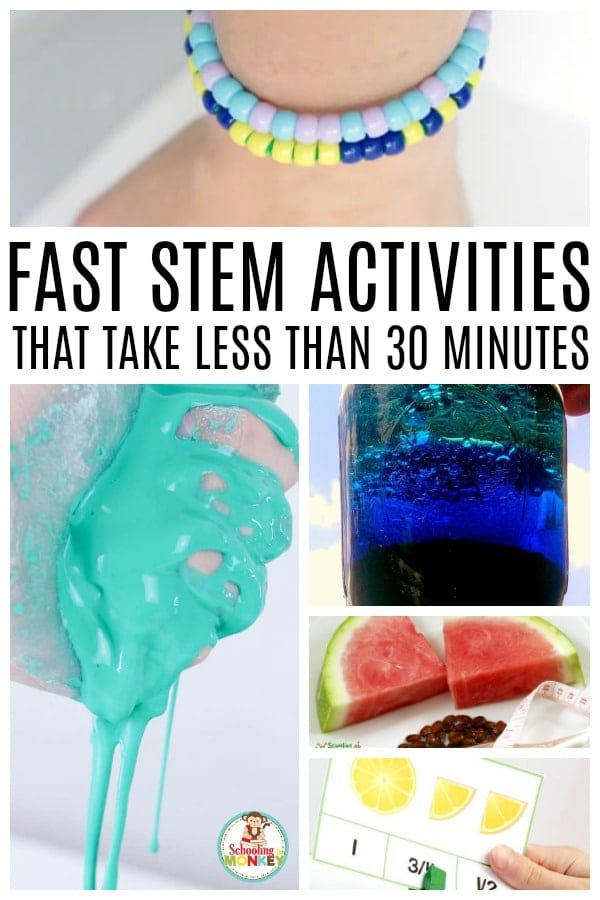
But if you’re simply looking for a few easy and quick STEM activities for your kiddos, you’ll appreciate the quick STEM lessons you’ll find in this post.
Today, I am sharing 21 quick STEM projects that are simple to set up and quick to do.
You’ll love how quickly you can set up these projects and get them completed, even if you have just a few minutes to do them in!
Perfect for easy STEM activities in the classroom or at home. Teach science in minutes, rather than hours.
What are Quick STEM Activities?
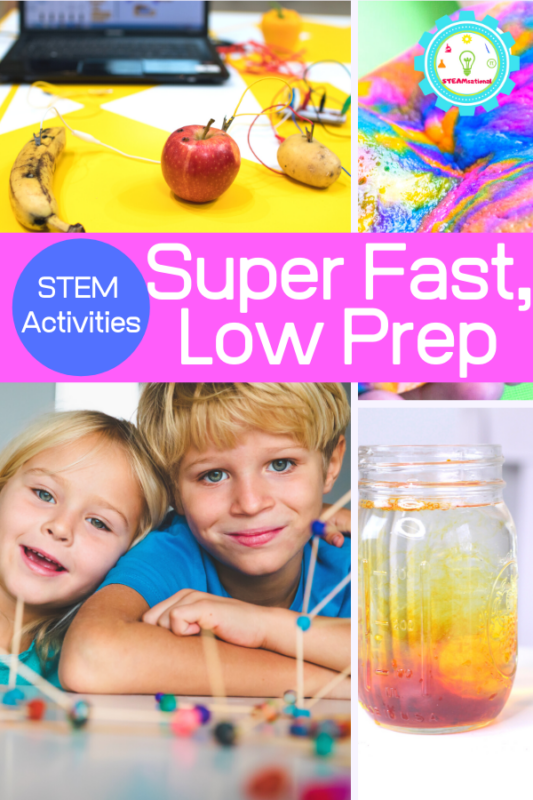
Integrating learning across Science, Technology, Engineering and Mathematics, there are quick and easy STEM challenges suitable for children of all ages on the list, and many of these activities can be easily scaled up or down through questioning to suit the age of your child.
In this case, a quick STEM challenge is one that takes 30 minutes or less to complete- or one class period!
The hardest thing might just be choosing which quick and easy STEM activity to try first!
21 Fast STEM Activities for Kids
Kids will love these hands-on STEM activities, and teachers and parents will love how quickly you can use these lessons to illustrate science lessons and teach STEM thinking skills to kids.
Why Do Quick STEM Activities with Kids?
A STEM activity is more than just a hands-on project that includes elements of science, technology, engineering, and math.
STEM activities are whole-brain exercises, that kids can use to explore disciplined subjects in a creative and exploratory way.
One of the best things about quick STEM activities is that there are no right or wrong answers.
In a true STEM experiment, children learn to think of solutions to problems on their own, with no particular planned outcome, just like in the real world.
STEM activities are one of the best ways to prepare children for problem solving and learning in the real world, and they give kids a taste of what sort of decision processes adults go through every day.
With the openness of STEM activities guiding children, there is no fear of failure and children who typically look for the “right” answer are encouraged to explore a topic, rather than just memorizing an answer.
Kids who regularly engage in quick STEM activities are better able to solve problems, think outside the box, go through a logical process to come up with an answer, and can tell you why they chose a certain solution clearly.
What Kids Learn Doing Quick STEM Activities
Quick STEM activities help illustrate the concepts of science, technology, engineering, and math in a fast, easy-to-see way that is ideal for quick science and STEM lessons, such as for early elementary science class, kindergarten lessons, STEM and science centers, preschool, STEM summer camp, and more!
The quick demonstrations work well when time crunches are an issue, and for many of these activities, kids can do them alone, making them perfect for self-guided play and exploration.
Check out more fun STEM themes, including our list of easy science experiments for kid s and creative STEM activities .
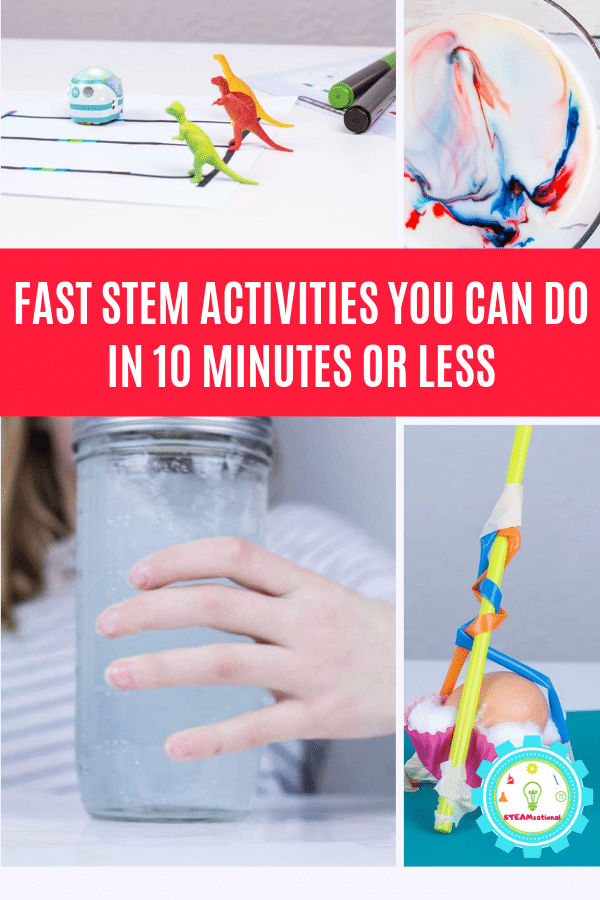
You don’t have to take a long time to teach a STEM lesson. Kids can learn the basic elements of science, technology, engineering, and math in these hands-on STEM projects for kids.
Use these lessons when you need to teach a scientific topic, but don’t have time to spend weeks on the project.
Quick STEM activities can be used to help keep morale up in the STEM classroom between bigger projects, as they often give fun, quick, and visually appealing results.
You can also use these quick STEM activities at home to make learning fun there!
How to Set Up Quick STEM Challenges for Kids
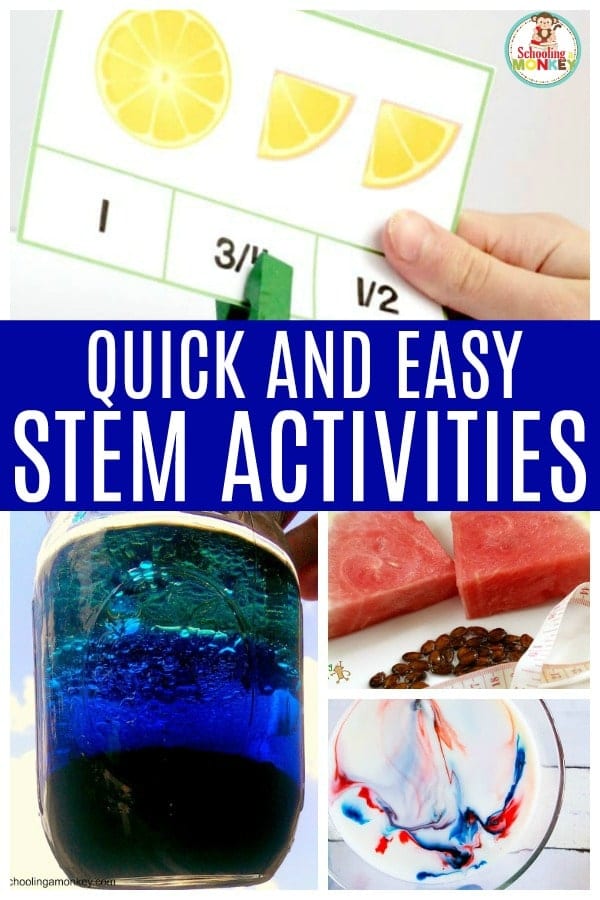
When possible, it’s best to mix several elements of STEM together, using elements of science, technology, engineering, and math all at once.
You’ll maximize the learning of children and help them understand how all the elements of STEM activities work together.
More STEM Activities for Kids
50+ LEGO STEM Challenges- Free Printable STEM Activities
20+ Carnival Themed STEM Activities for Kids
20+Spectacular and Fun Circus STEM Activities
Toy Making STEM Activities
Quick STEM Activities that Take 30 Minutes or Less
Follow along with these activities to find a bunch of fun science, technology, engineering, and math activities that can be done in less than a single class period.
And best of all, they are super fun, too!
Quick Science Experiments for Kids
These fast science experiments are a breeze! Learn about liquid density, surface tension, non-Newtonian fluids, slime, light refraction, and more!
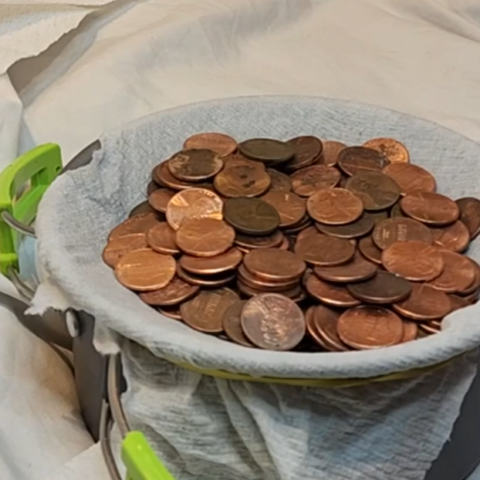
Paper Towel Strength Test Science Experiment
With just paper towels and pennies, students can conduct a simple penny paper towel experiment to determine whether wet or dry paper towels can hold more weight. Students will learn how adding a variable to an experiment can drastically change the outcome even when no other changes are made.
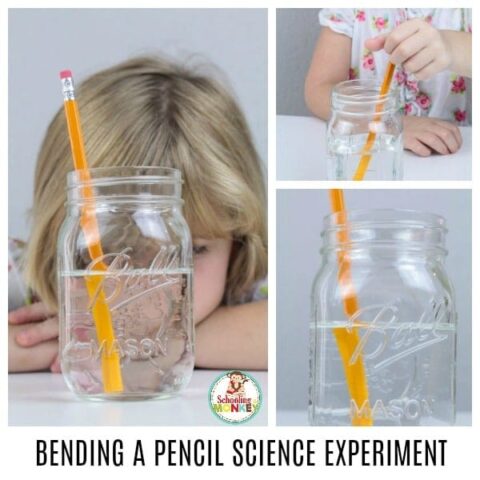
Amazing Bending Pencil Experiment That's Just Like Magic!
Use light to break a pencil. How is it done? You'll have to try it to find out!
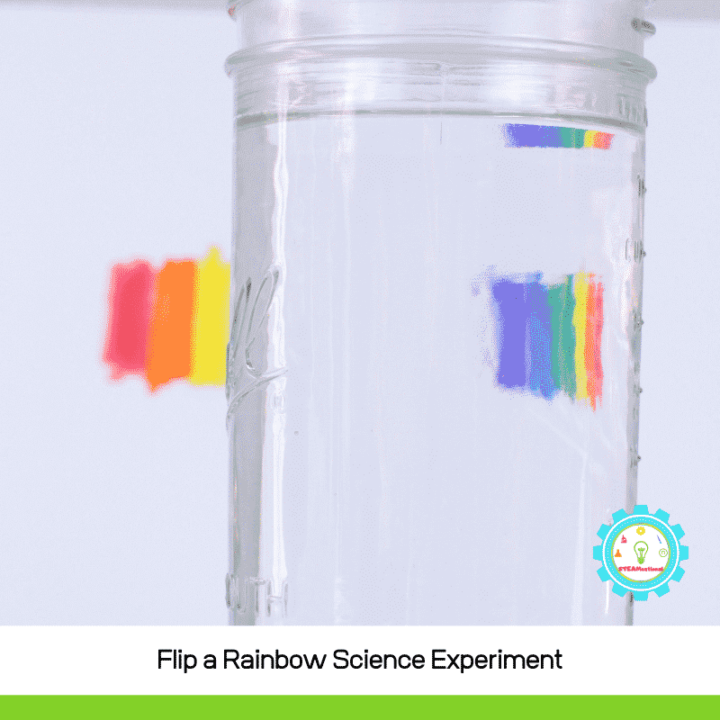
Flip a Rainbow Light Refraction Experiment
You can magically flip a rainbow with light! How? The science is complicated, but the project is a whole lot of fun!
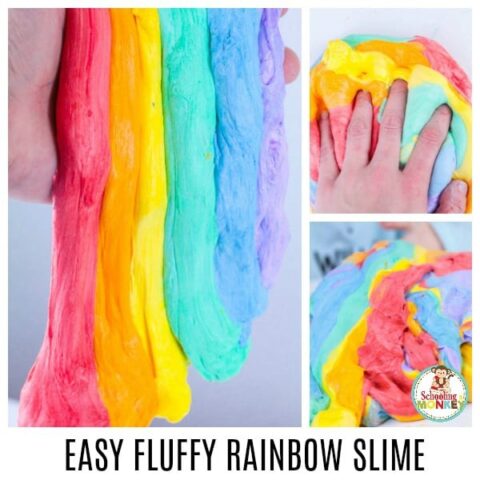
How to Make Fluffy Rainbow Slime (without the mess)
Did you know that slime uses a lot of scientific chemistry principles? Apply them and learn all about polymer chains and molecular bonds when you make this fluffy slime.

Fortnite Slurp Drink Water Density Experiment
Fortnite is a lot of fun for kids. This Fortnite slurp drink density tower uses science to keep the colors apart!
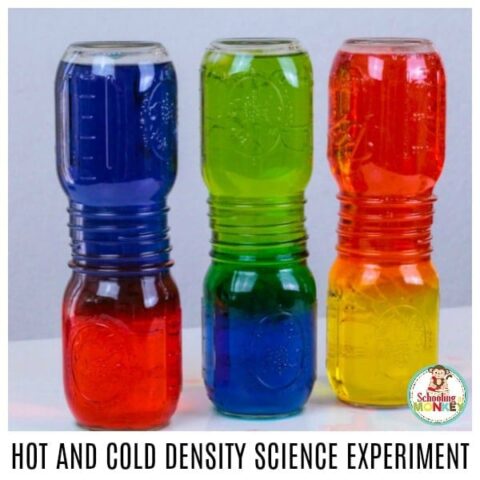
How to Do the Hot and Cold Water Density Experiment
You can learn about color mixing and how temperature has different densities in this super fun and quick science experiment.
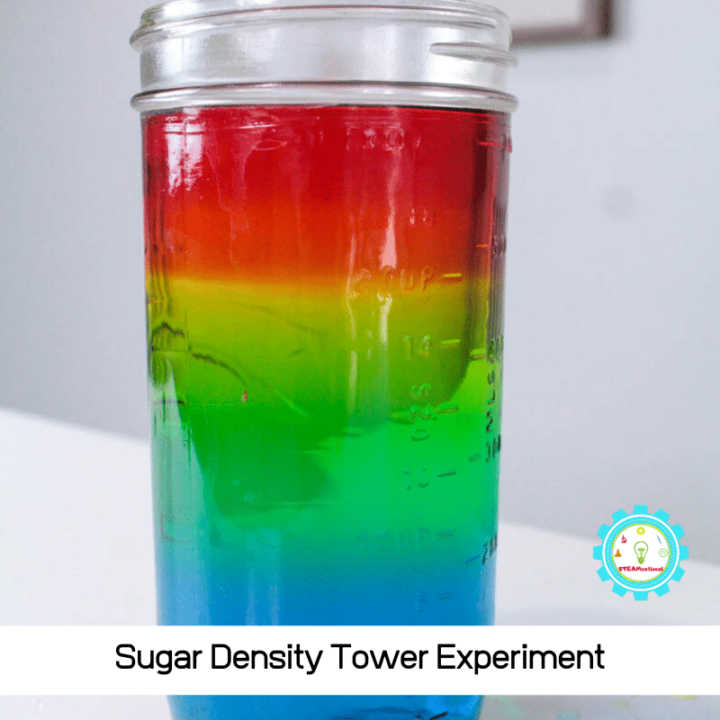
Sugar Rainbow Density Tower Experiment
Nothing is more fun than sweet science! Learn about density and viscosity in this quick experiment.
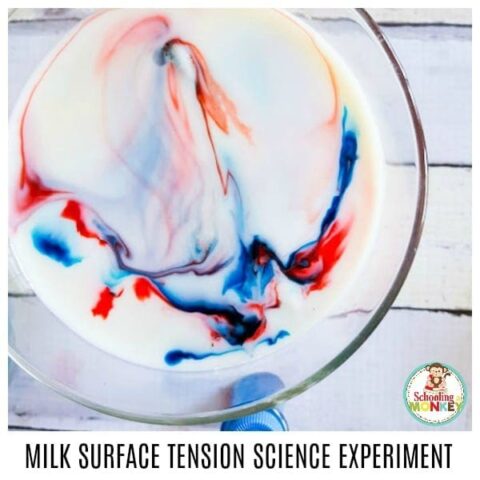
Super Fast Milk Surface Tension Science Experiment!
Surface tension is hard to describe, but with this experiment, its easy to see!
Quick Technology Activities for Kids
Fast technology challenges you can do in minutes! Learn about circuits, coding, binary, and more!
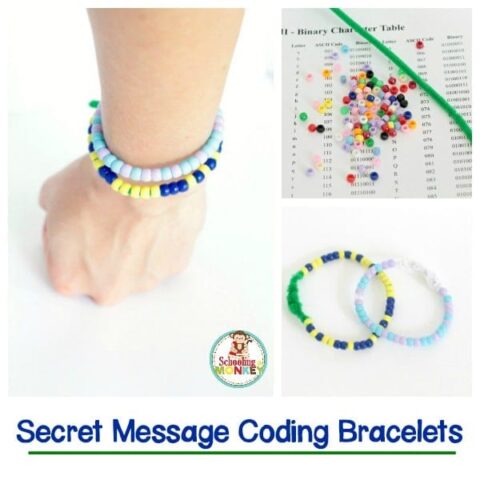
How to Make Binary Coding Bracelets with Secret Messages
Teach kids the basics of binary with these coding bracelets.
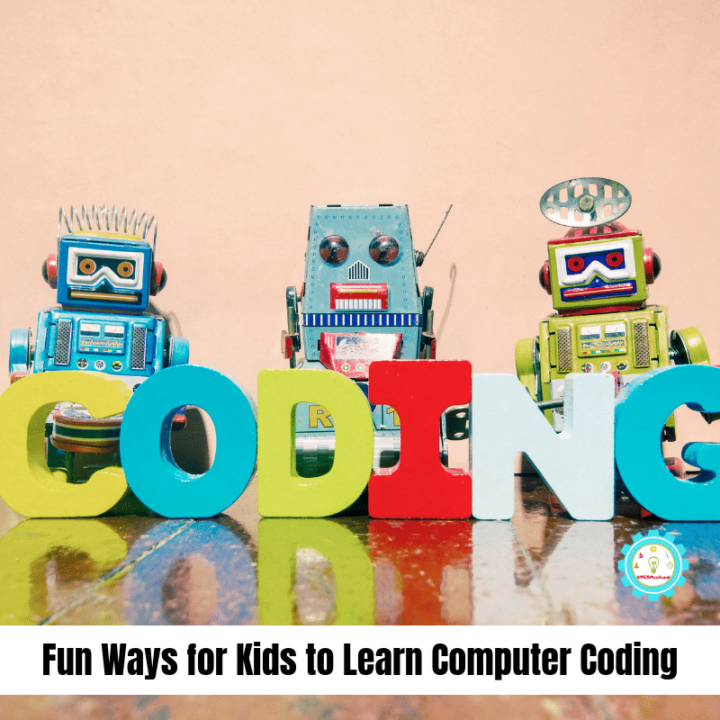
Fun Ways for Kids to Learn Computer Coding
Here are some super fun ways to teach coding to kids and learn how to make technology fun for them.
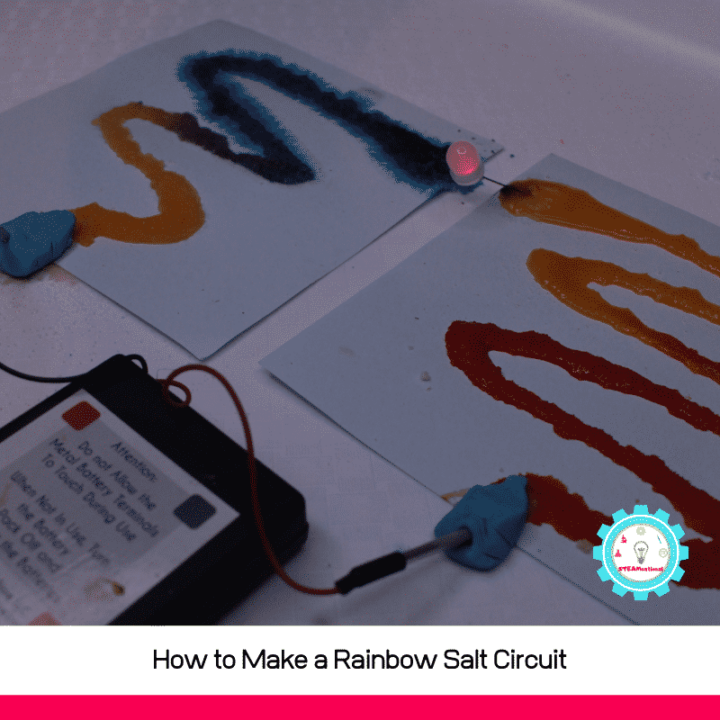
Rainbow Salt Circuit Engineering Activity
Learn how circuits work with this fun glow in the dark circuit activity!
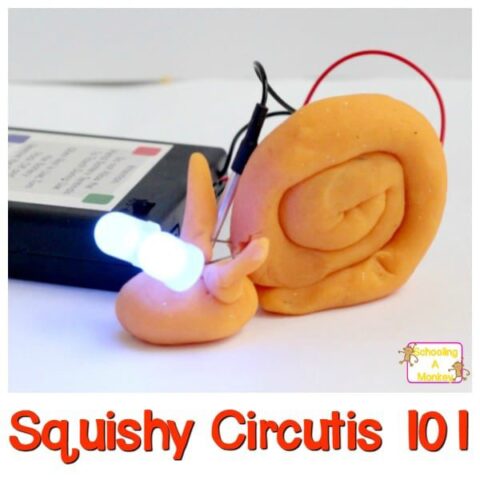
How to Use Squishy Circuits for Electrical Engineering
Learn all about electricity and electrical engineering with Squishy Circuits!
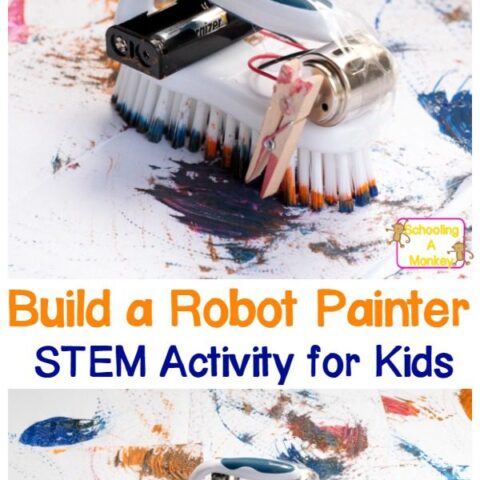
Painting Brush Bot
With a motor and a brush, you can create a robot painting system!
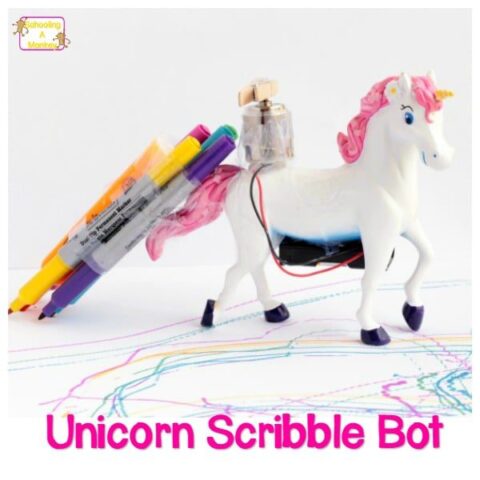
How to Make a Unicorn Rainbow Scribble Bot
Learn how to put together a working motor and create a robot that can draw for you!
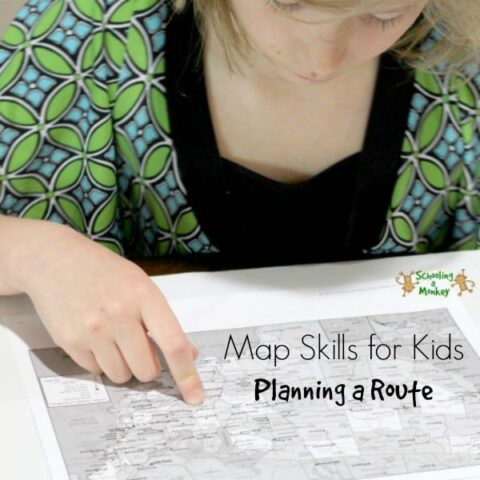
Map Skills for Kids: Planning a Route
Learning how to use a map is an essential skill for kids! Technology makes it easier.
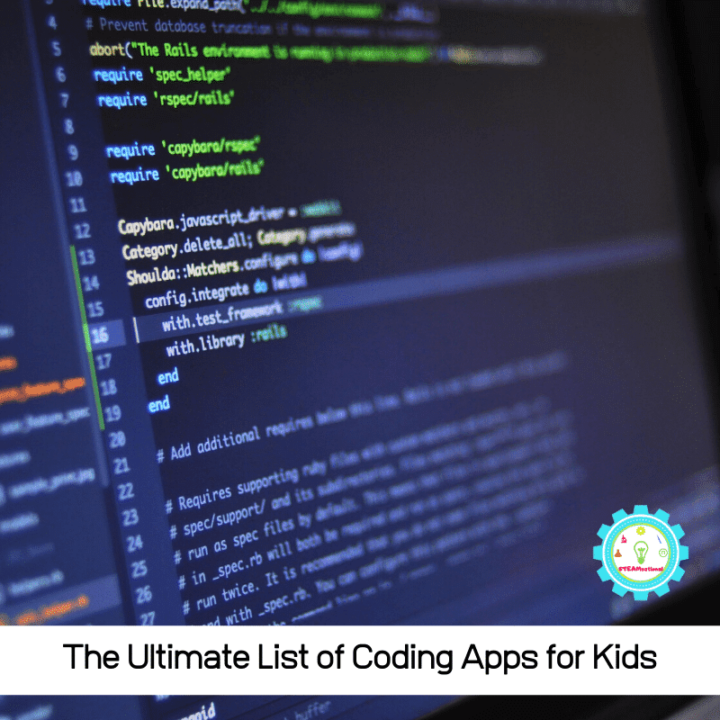
The Best Coding Apps for Kids
These coding apps will teach kids the basics of coding and more!
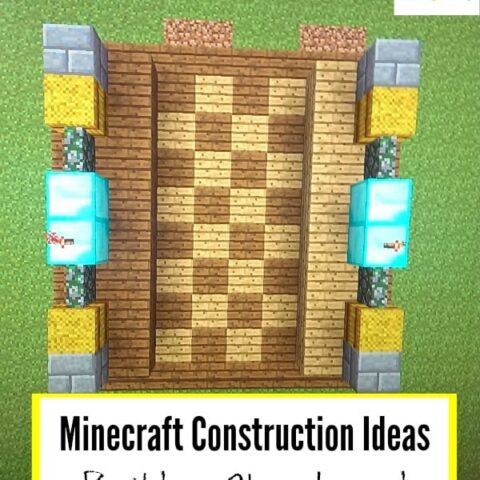

Build a Minecraft Chessboard
There is a lot of tech behind Minecraft! In this simple activity, challenge your kiddos with how to make a chess board!
Quick Engineering Activities for Kids
Rome might have taken more than a day to complete, but these engineering projects won't! You can knock these quick engineering challenges out in just minutes!
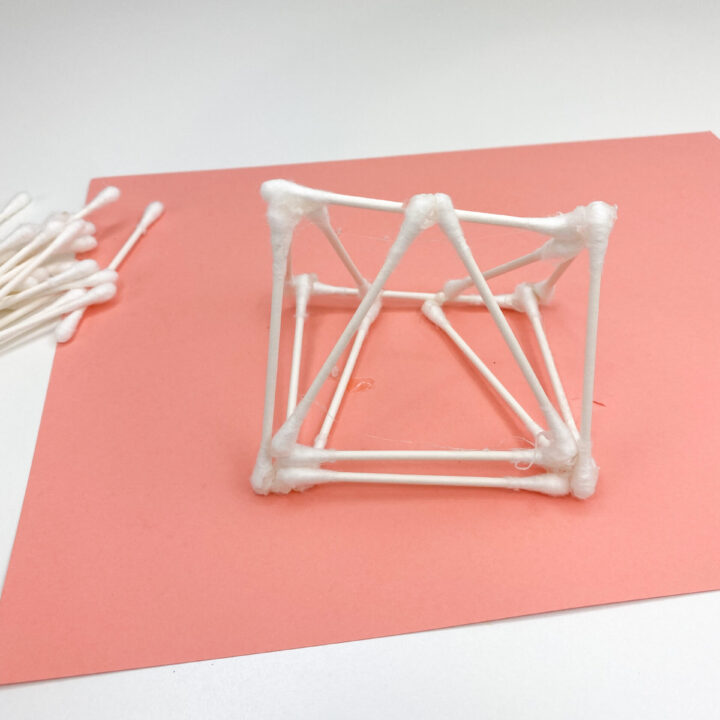
Cotton Swab Bridge Building Engineering Challenge Lesson Plan
Learn how to teach this q tip bridge engineering challenge with the students in your classroom. It's a fun twist on other bridge building engineering challenges and students will have a blast coming up with their unique designs.
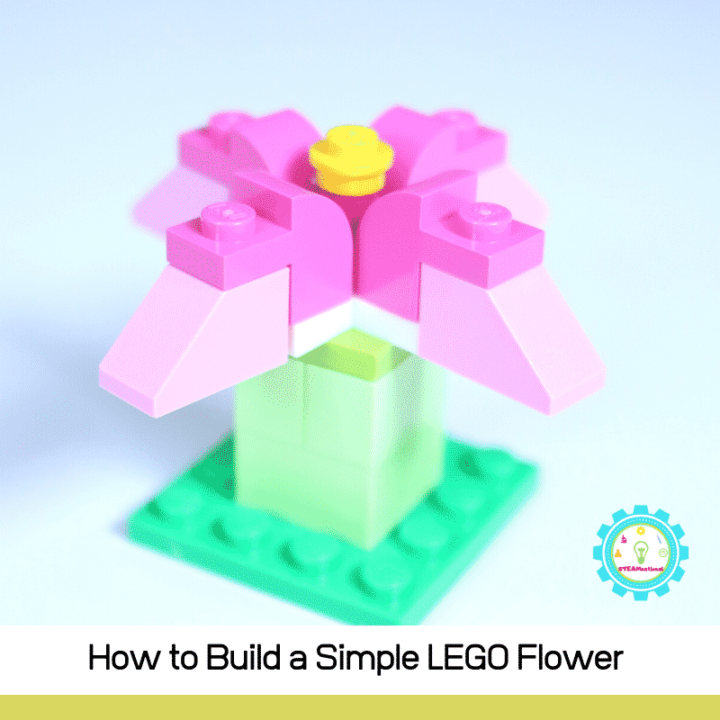
How to Build a Simple LEGO Flower
Building a LEGO flower is easy and fast and teaches kids the basics of design and engineering.
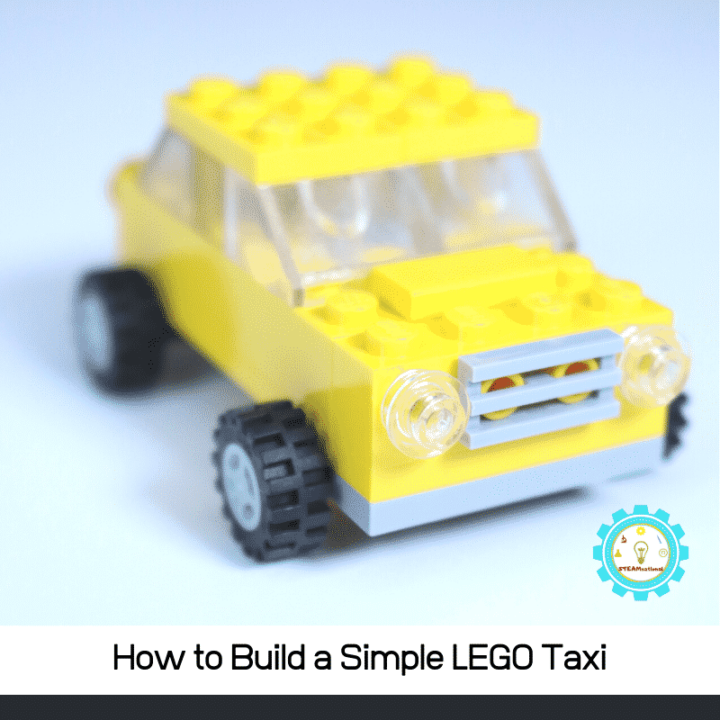
How to Build an Easy LEGO Car
Follow along with this simple guide to create a LEGO car in minutes!
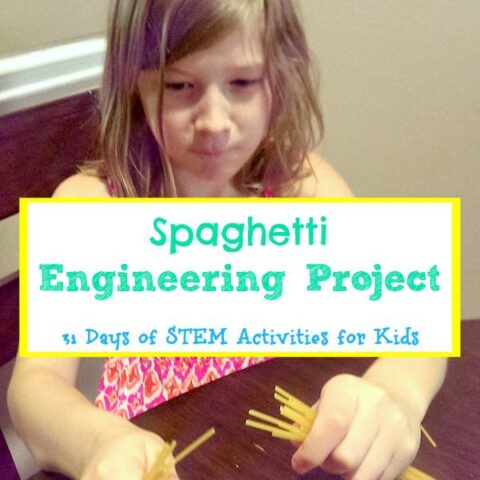
Spaghetti Engineering Project
This Spaghetti Engineering Challenge is so easy, but kids can learn a lot!
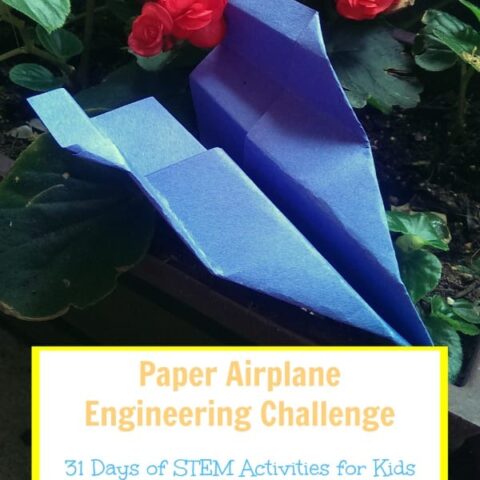
How to Design a Paper Airplane Engineering Challenge
If you love building and designing and testing, then the Paper airplane Engineering Challenge is for you!
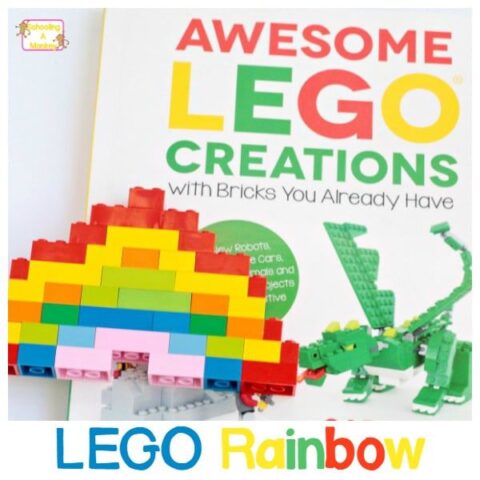
How to Make a LEGO Rainbow with Classic LEGO Bricks
Making a LEGORainbow sounds like it would be easy, but it's actually surprisingly difficult!
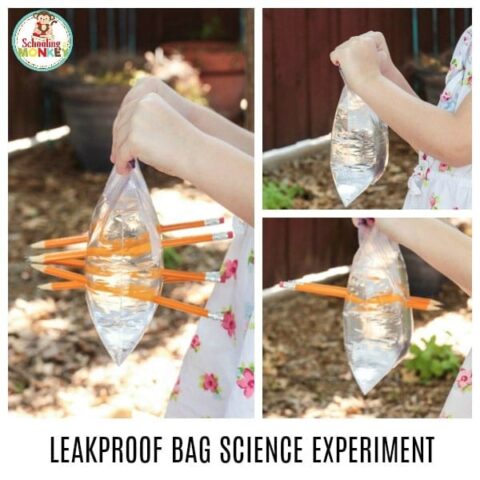
EASY! 3 Steps to the Perfect Leak Proof Bag Science Experiment
The leakproof bag science experiment teaches kids about polymer chains in less than five minutes!
Quick Math Activities for Kids
Quick math challenges for on-the-fly learning. You don't have to take forever to do math activities!
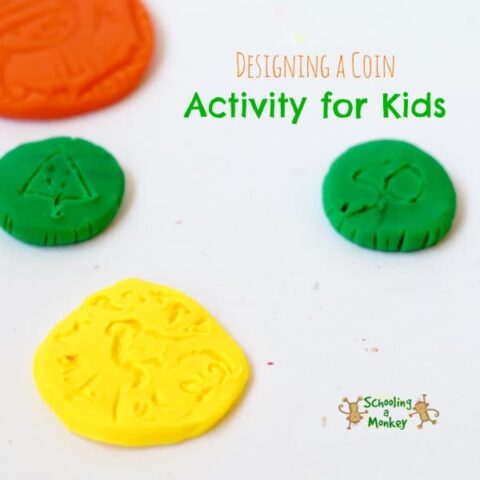
Design a Coin Activity for Kids
Design coins and learn all about coin values and how to use money in this super quick math activity!
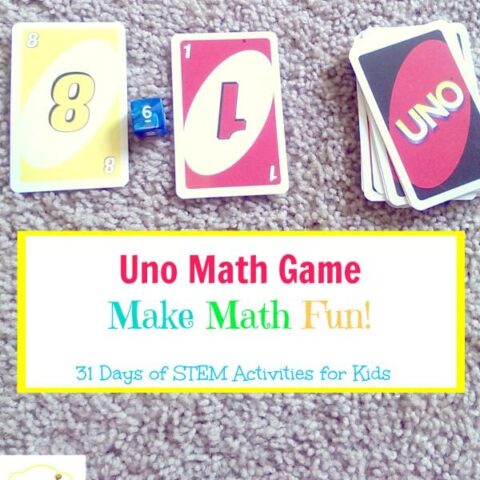
Uno Math Game
Kids will love this fun math variation on the classic UNO game!
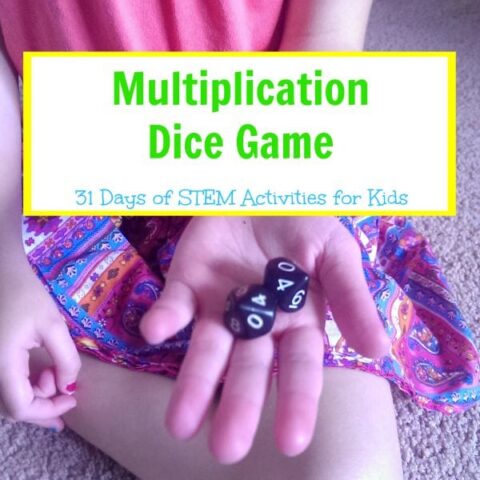
Multiplication Dice Game
Play the multiplication dice game when you have a few minutes to work some additional math practice in.
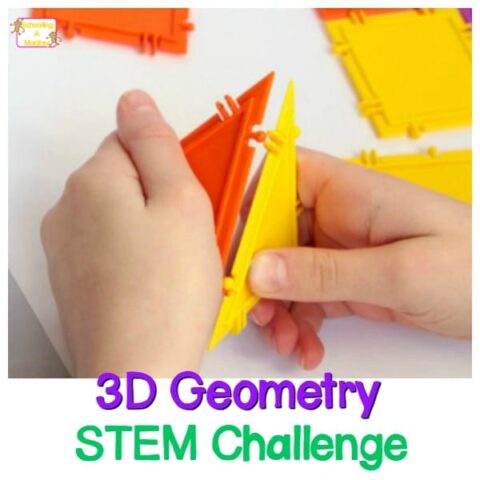
Hands-On Geometry Challenge: Building 3D Shapes
Build geometry shapes using geometry bricks for some fast geometry math practice.
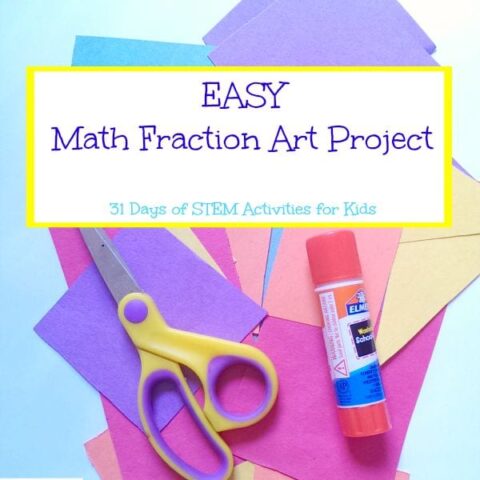
Math Fraction Art Project
Learn about fractions and turn them into fun art pieces in this fast math activity!
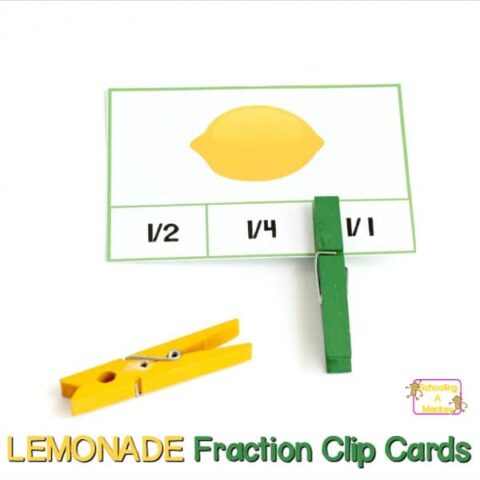
Printable Lemon Fraction Clip Cards for Elementary Kids
Learning fractions is way less of a bother when you use these cheery lemon fraction clip cards !
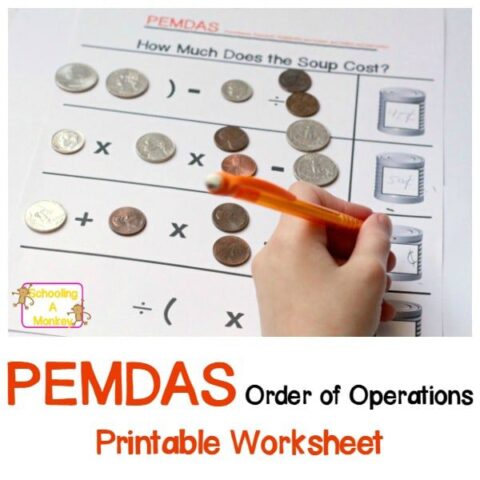
Soup Can Printable PEMDAS Worksheet for Teaching Order of Operations
Grab this fun soup-themed printable PEMDAS worksheet .
Share this project with a friend!


45+ Engineering Science Fair Projects (and advice!)
Before I started Innovative Arts class, I was a science teacher. The science and engineering fairs were ultra engaging and everyone learned so much! I hope you are excited by the possibilities that lie ahead. A lot of the resources I have created can help you have a great experience.
What is so great about engineering science fair projects?
Engineering science fair projects can be a great way for students to develop problem solving, critical thinking, and research skills in a fun and engaging way. They are challenging! We do our best learning and growing when we are challenged. If you’re looking for some ideas for engineering science fair projects that your child can do at home or in school, here are my best ideas and resources.
Do some popsicle stick engineering!
This one is my favorite. With a little patience and way to drill a hole in a popsicle stick, you can make a very cool project! Check out my entire page of movements and example videos .

Build Your Own Wind-Powered Car
For this project, students create a wind-powered car out of everyday materials like cardboard or Styrofoam. It’s great for kids who are interested in renewable energy sources because it gives them hands-on experience building something that runs on wind power instead of electricity or gasoline. Plus, it helps them learn about aerodynamics and basic physics concepts like drag force and momentum—all while having fun!
If you bring a fan to the fair, you could have a pretty cool demonstration set up for people to play with! Look at possible car projects.
Designing the Strongest Bridge
In this project, students must design the most durable bridge out of everyday materials such as toothpicks, popsicle sticks, straws, string, etc. It teaches them problem solving skills as they figure out which materials will make their bridge strong enough to withstand certain levels of pressure without breaking down. Additionally, it helps them understand basic physics principles such as tension and compression forces.
To take it a little further, you could test different designs and display the broken bridges with how much weight it took to break them. Possible bridge projects
Designing Windmills
Windmills are becoming more popular these days due to renewable energy initiatives around the world. Designing windmills is another great engineering project because it involves researching different types of wind turbines and their associated components like blades and hubs. After researching wind turbine designs students can then go ahead with designing their own prototype using cardboard or other available materials.
Bring a fan and let your windmill turn while the fair is being judged! Start looking for windmill projects here .
Creating an Effective Water Filter System
This project requires students to use everyday items such as coffee filters and gravel to construct an effective water filter system that can clean dirty water into drinkable water. It’s ideal for children who want to learn how filtration systems work since it gives them first-hand experience designing one from start to finish! Plus, it provides important lessons about water purification methods too!
To do this, research some simple water filter setups and choose an easy option. Make sure you demonstrate it at the fair! I would start here .
Creating Robots
Another great engineering project is creating robots. Robotics is becoming increasingly important in our society and more companies are investing in robotics research and development every day. To create a robot, students need to understand the components needed such as motors, microcontrollers, sensors, etc., as well as the coding language used to program them. Once these basics are understood students can start designing their own robot prototype!
There are a lot of kits available for this. I recommend using a robot that can be programmed using Scratch because you can learn it so quickly! See my tutorials below.

Other project ideas available!
I’ve spent years figuring out what works in a middle school classroom using cheap materials. Here are just a few projects from class!

Engineering science fair projects are a great way for students to apply their knowledge in STEM topics in real life situations while getting creative with their designs at the same time! Whether your child is interested in robotics or renewable energy sources, there’s bound to be an engineering science fair project that fits his/her interests perfectly!
I am creating this site to advance student creativity and help students to take ownership of their learning . The resources on this site are intentionally open-ended and a part of my Innovative Arts curriculum .
Email list – Stay in the loop

Check out the resource hub

A new vision for education
Get email updates & invites, i'm a full time teacher first, so it'll just be an occational email.
Your email address will not be published. Required fields are marked *
Save my name, email, and website in this browser for the next time I comment.
There was a problem reporting this post.
Block Member?
Please confirm you want to block this member.
You will no longer be able to:
- See blocked member's posts
- Mention this member in posts
- Invite this member to groups
Please allow a few minutes for this process to complete.

50 Simple STEM Activities using 15 Materials
I started doing simple STEM activities with my children at home, and students at school, a few years ago. They all loved it! They were always excited when I brought in materials and gave them a chance to create, problem solve and use their imagination. Because of the learning and engagement I saw every time we did one of this projects, STEM activities have become a regular part of my teaching program.
One of the great things about STEM activities is that they don’t have to be expensive. As a teacher I wanted to find a collection of STEM activities and challenges that didn’t require expensive materials or a lot of prep.
I created this collection of 50 Simple STEM Activities using only 15 materials. Most of the materials are supplies you likely already have on hand, such as paper, elastics and scissors.
STEM activities are a great way to develop Science, Technology, Engineering and Math skills. The more of these skills mixed into the activity, the better.
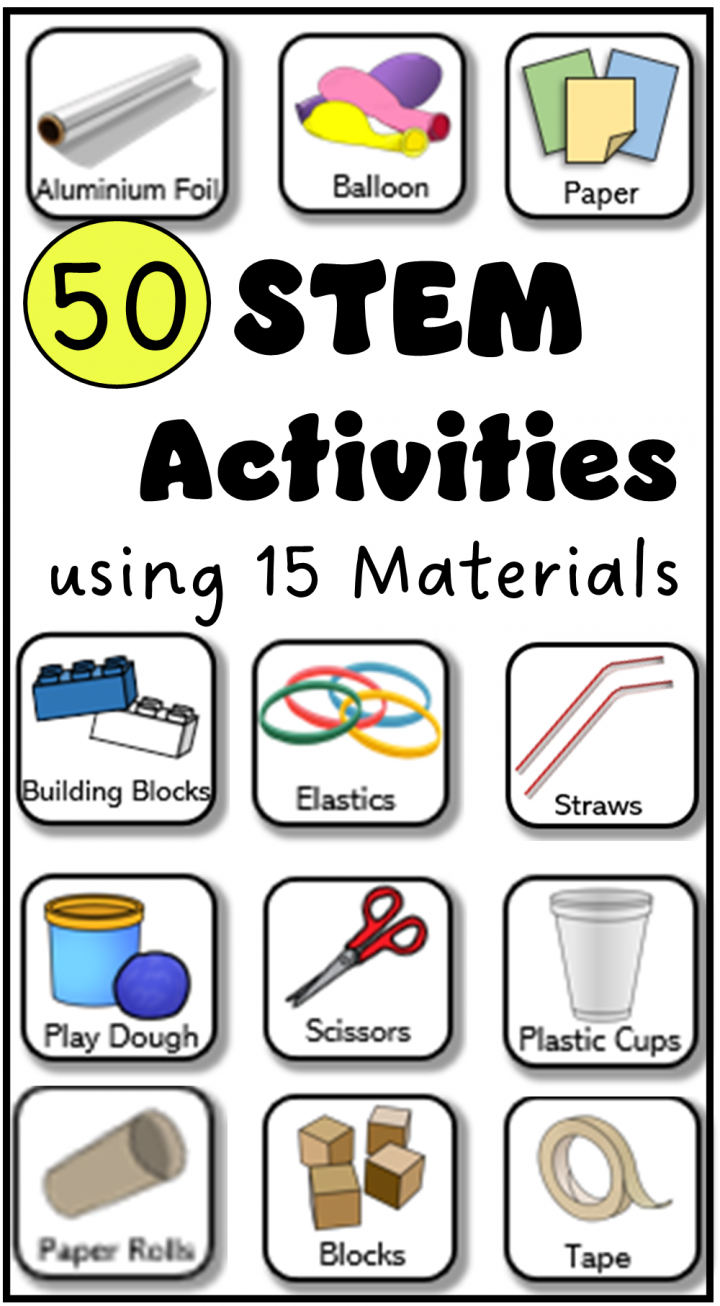
The collection of 50 STEM activities featured below are all hands-on building challenges. They each use, one or several of the 15 materials needed to do all of the challenges.
If you teach a STEM program, or simply want to bring more STEM to your child’s learning, this program is the perfect place to start. Print the activity cards, fill a bin with the 15 materials and you’re ready to go!
For more STEM activities, check out 10 Exciting STEM Activities with 10 Materials and the popular collection of 45+ STEM Challenge Ideas for Kids .
Simple STEM Activities Materials
There are 15 materials you will need in order to do the STEM challenges. The more of each material you can collect, the better. All of the 50 STEM activities in this program use some combination of the materials below. It may look like a lot of supplies, but keep in mind that it is for 50 different activities! You will need:
- Wooden blocks
- Construction paper
- Clothes pins
- Plastic cups
- Plastic building blocks
- Ping pong ball
- Large craft sticks (tongue depressors)
- Paper rolls
- Aluminum foil
Once materials are used for a STEM challenge, hang onto any left over supplies and any other supplies that can be reused for your next STEM challenge. Many of the challenges allow the materials to be recycled and used again and again.
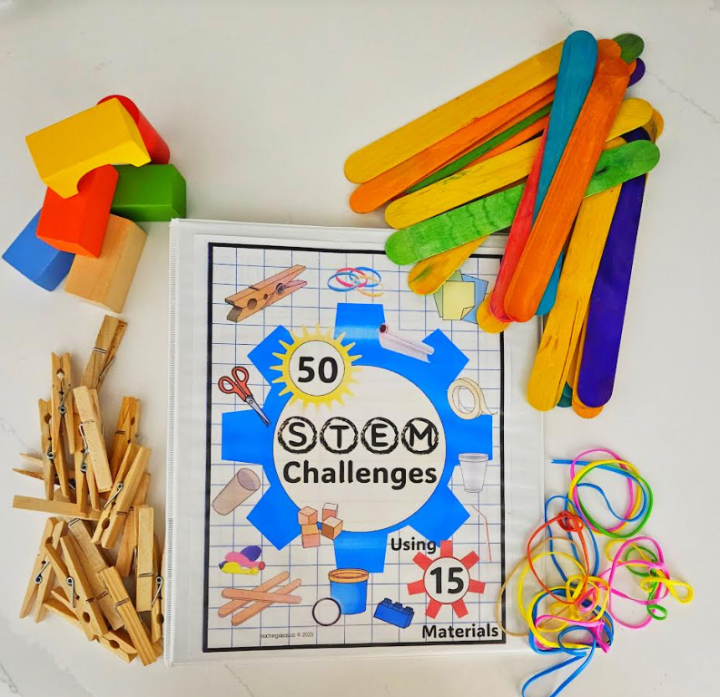
I’ve included an example below of a STEM bin I created in the past full of materials that I pulled from for each STEM challenge.
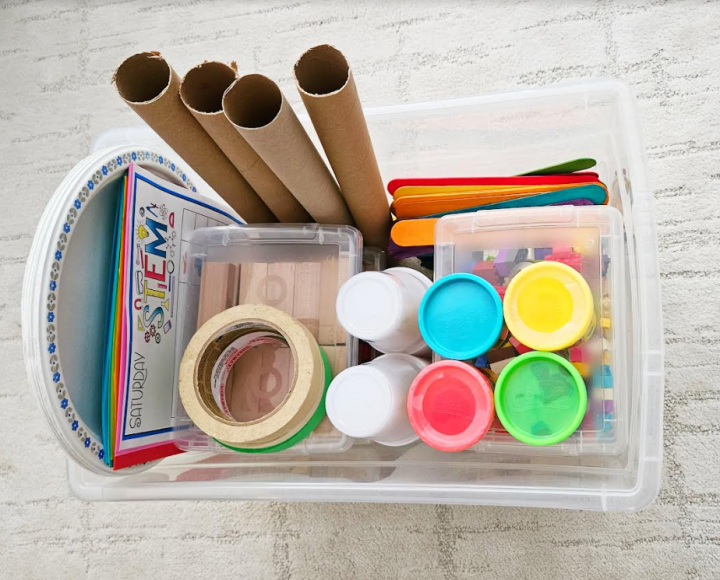
Once you have all of your materials collected, print the activity cards for the challenges.
Benefits of Simple STEM Activities
STEM activities are a great, and fun way to encourage essential skills. These challenges promote critical thinking, creativity, team work, and problem solving. Children learn that the process is as important, if not more important than the final result.
A key part of STEM challenges is trial and error. Encourage children to create and test their solution. If it doesn’t work, have them think about what does work, and what doesn’t and recreate based on what they have learned.
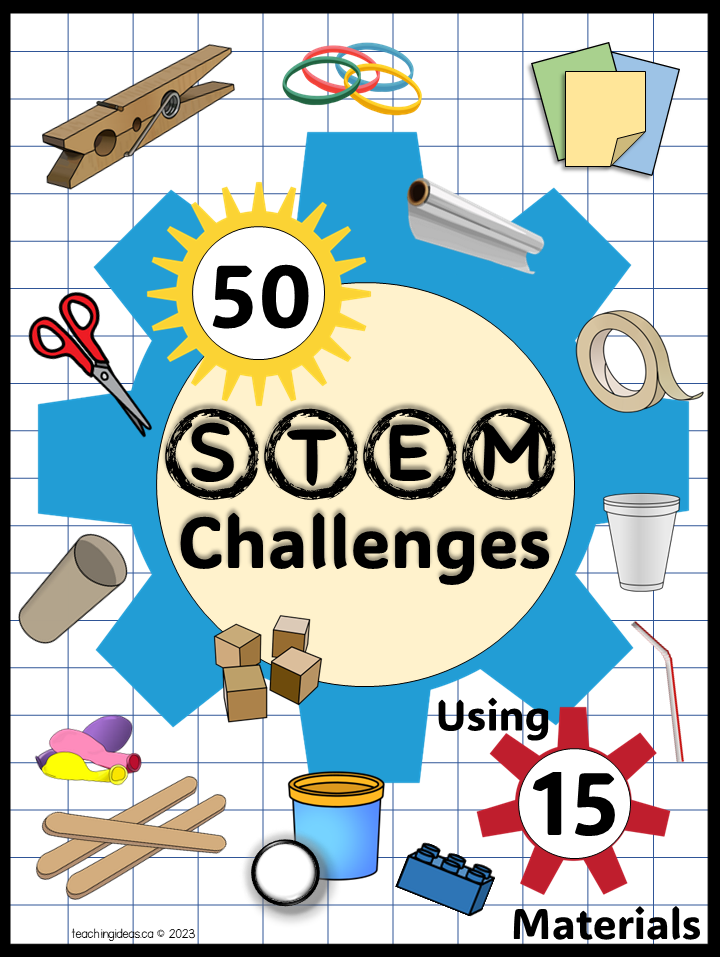
If there is an activity in this collection that you think is going to be too challenging for your group of children, you can always alter the activity, or add more supplies, to make the activity easier. However, avoid helping children as soon as they run into problem. Part of the learning comes when children get stuck. Give them the chance to learn from their mistakes.
STEM Activity Printables
There are 50 activity cards included in the product for the STEM challenges. They are included in the resource in different formats. Print the format that works best for you.
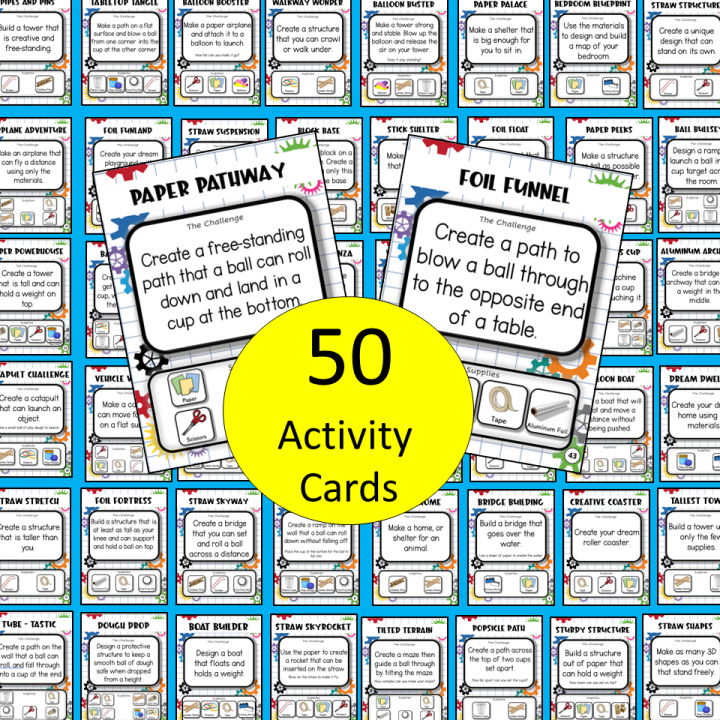
You can print the full page cards, half page or smaller (4 per page) activity cards. Each of the sets are included in black and white and color.
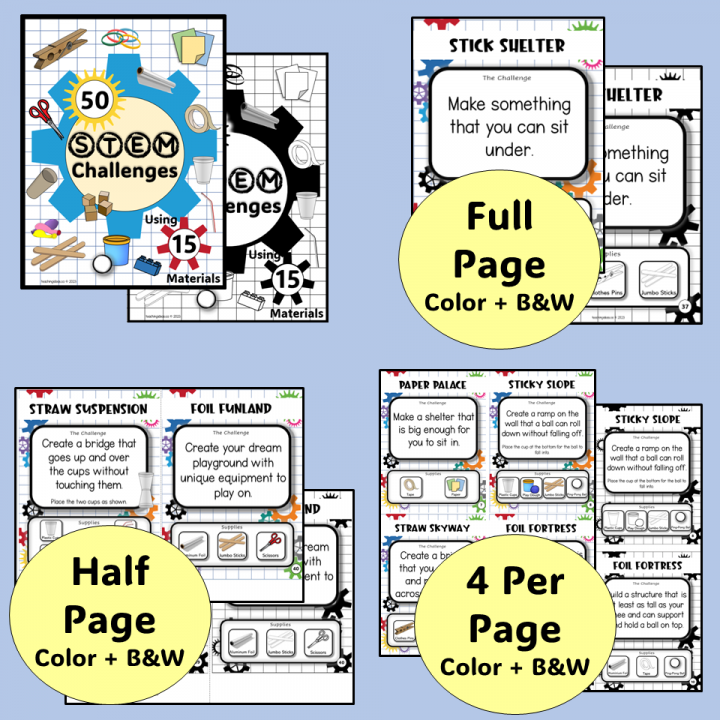
Beyond the activity cards, the resource also includes instructions on how to use the cards, a material list to help keep you organized as you collect materials, and a marking rubric if you are using the resource in a class setting.
Included in the printables, there is also information about STEM education, a student planning sheet, certificates for children upon completing STEM challenge(s) and a list of all of the activities.
If you are just starting your STEM program, these are great sheets and information to make setting up your program easy.
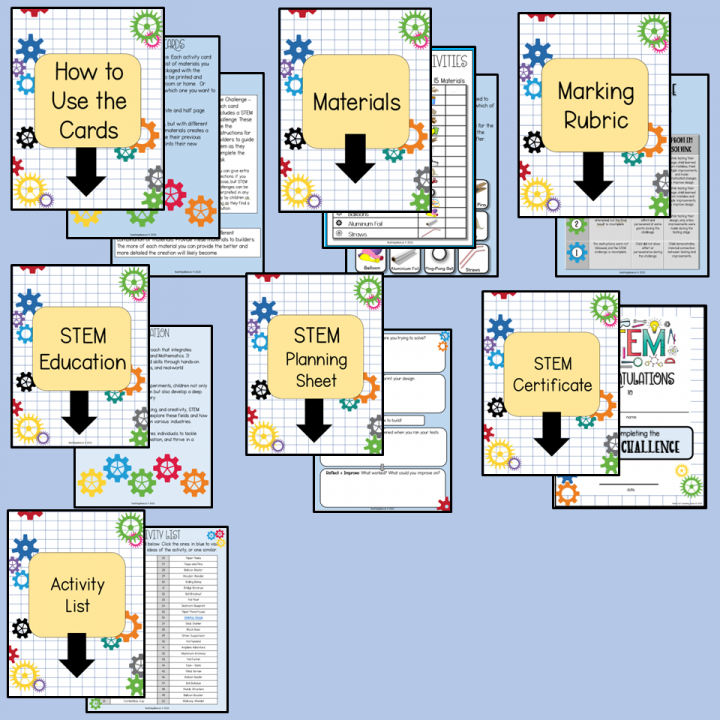
The title of the activity, the challenge as well as the materials needed are all listed on the activity card. A picture of the supplies needed is included to help children know what materials they can use for the challenge.
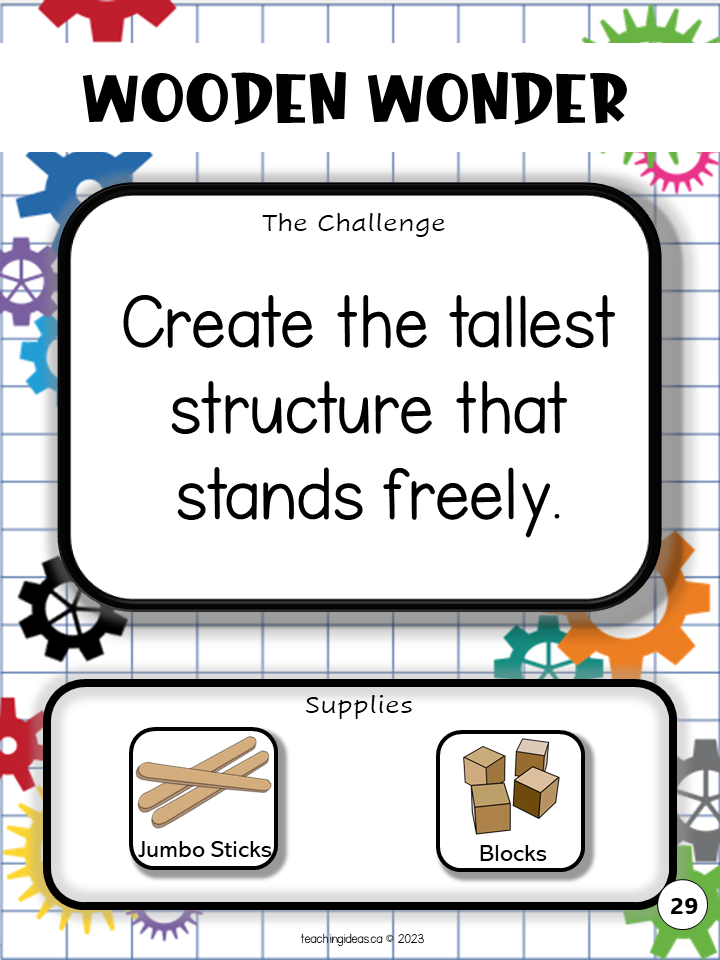
Preparing Your STEM Activities
Whether you use the activities to keep kids busy on rainy days or plan a weekly STEM challenge virtually all year round, this resource is easy to set up and, with the exception of collecting materials, there is no extra prep work involved.
There are lots of different ways you can set up your STEM program. You can print the cover page with the activity cards to create individual packages for children to work through at their own pace, as one option.
Since I have been doing STEM activities in my classroom for several years, I have found that they make great centers!
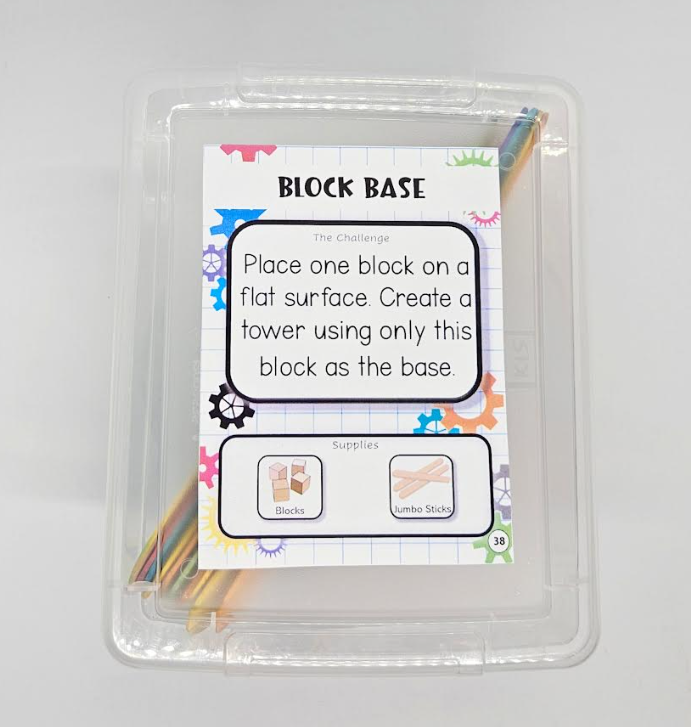
Grab a collection of clear bins, print an activity card and attach the card to the top. Inside the bin, include the materials children need for the challenge.
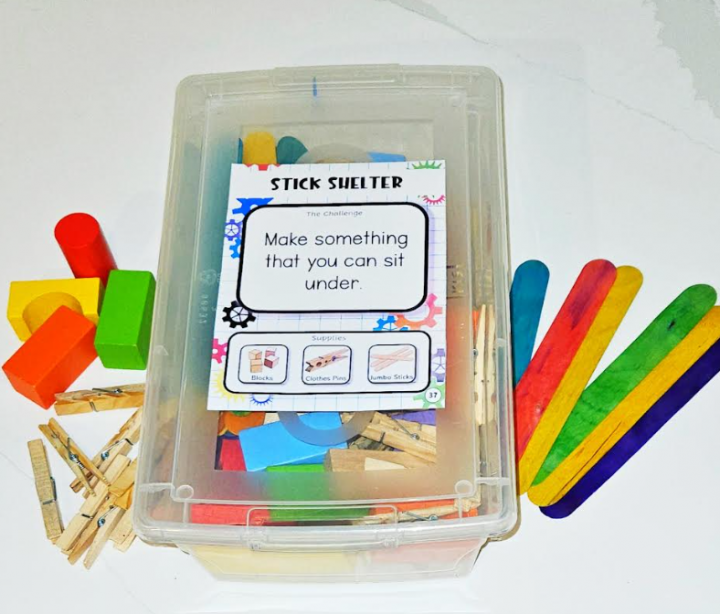
For older children, you can print the smaller activity cards and attach them all with a ring. I laminated my set so that I can use them for many years. Children can choose an activity, and grab the supplies needed and begin creating.
Another way to use the activity cards is to print them and put them in a bag along with the supplies needed for the challenge. These make great kits, or gifts, to give to children to create with at home.
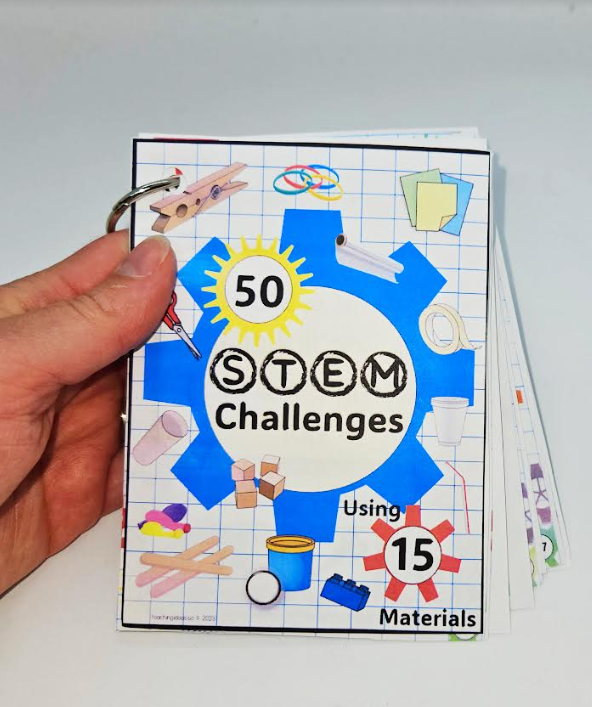
Get your STEM program ready and prepared quickly and easily with the 50 simple STEM activities shown above.
Get all 50 of the activity cards and the other pages featured above in the resource. Click for more information. The program is on sale!
Click the image for more information.
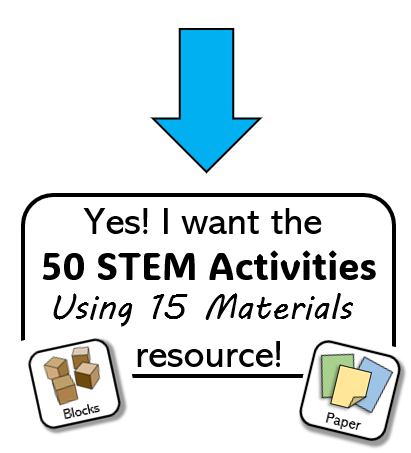
Free Resource Library
Join Hands-On Teaching Ideas to learn about my latest products, promotions and activity ideas. When you subscribe you will also gain access to the Free Resource Library filled with over 100 resources that you can download and use today.
Subscribing is free. Once you subscribe, you will receive a confirmation email. After you confirm you will receive a link to the library.
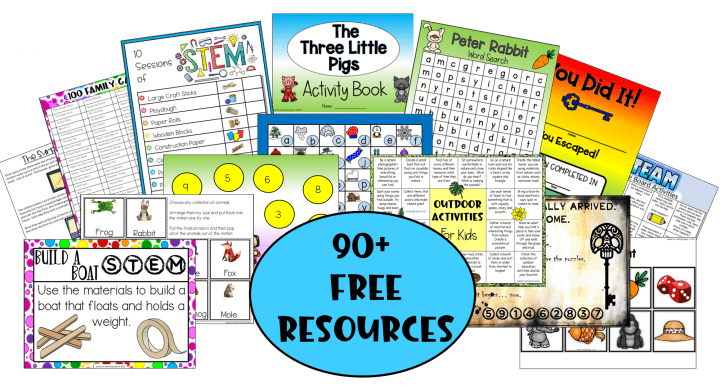
Leave a Reply Cancel Reply
Your email address will not be published.
- Utility Menu
GA4 Tracking Code

fa51e2b1dc8cca8f7467da564e77b5ea
- Make a Gift
- Join Our Email List
- Problem Solving in STEM
Solving problems is a key component of many science, math, and engineering classes. If a goal of a class is for students to emerge with the ability to solve new kinds of problems or to use new problem-solving techniques, then students need numerous opportunities to develop the skills necessary to approach and answer different types of problems. Problem solving during section or class allows students to develop their confidence in these skills under your guidance, better preparing them to succeed on their homework and exams. This page offers advice about strategies for facilitating problem solving during class.
How do I decide which problems to cover in section or class?
In-class problem solving should reinforce the major concepts from the class and provide the opportunity for theoretical concepts to become more concrete. If students have a problem set for homework, then in-class problem solving should prepare students for the types of problems that they will see on their homework. You may wish to include some simpler problems both in the interest of time and to help students gain confidence, but it is ideal if the complexity of at least some of the in-class problems mirrors the level of difficulty of the homework. You may also want to ask your students ahead of time which skills or concepts they find confusing, and include some problems that are directly targeted to their concerns.
You have given your students a problem to solve in class. What are some strategies to work through it?
- Try to give your students a chance to grapple with the problems as much as possible. Offering them the chance to do the problem themselves allows them to learn from their mistakes in the presence of your expertise as their teacher. (If time is limited, they may not be able to get all the way through multi-step problems, in which case it can help to prioritize giving them a chance to tackle the most challenging steps.)
- When you do want to teach by solving the problem yourself at the board, talk through the logic of how you choose to apply certain approaches to solve certain problems. This way you can externalize the type of thinking you hope your students internalize when they solve similar problems themselves.
- Start by setting up the problem on the board (e.g you might write down key variables and equations; draw a figure illustrating the question). Ask students to start solving the problem, either independently or in small groups. As they are working on the problem, walk around to hear what they are saying and see what they are writing down. If several students seem stuck, it might be a good to collect the whole class again to clarify any confusion. After students have made progress, bring the everyone back together and have students guide you as to what to write on the board.
- It can help to first ask students to work on the problem by themselves for a minute, and then get into small groups to work on the problem collaboratively.
- If you have ample board space, have students work in small groups at the board while solving the problem. That way you can monitor their progress by standing back and watching what they put up on the board.
- If you have several problems you would like to have the students practice, but not enough time for everyone to do all of them, you can assign different groups of students to work on different – but related - problems.
When do you want students to work in groups to solve problems?
- Don’t ask students to work in groups for straightforward problems that most students could solve independently in a short amount of time.
- Do have students work in groups for thought-provoking problems, where students will benefit from meaningful collaboration.
- Even in cases where you plan to have students work in groups, it can be useful to give students some time to work on their own before collaborating with others. This ensures that every student engages with the problem and is ready to contribute to a discussion.
What are some benefits of having students work in groups?
- Students bring different strengths, different knowledge, and different ideas for how to solve a problem; collaboration can help students work through problems that are more challenging than they might be able to tackle on their own.
- In working in a group, students might consider multiple ways to approach a problem, thus enriching their repertoire of strategies.
- Students who think they understand the material will gain a deeper understanding by explaining concepts to their peers.
What are some strategies for helping students to form groups?
- Instruct students to work with the person (or people) sitting next to them.
- Count off. (e.g. 1, 2, 3, 4; all the 1’s find each other and form a group, etc)
- Hand out playing cards; students need to find the person with the same number card. (There are many variants to this. For example, you can print pictures of images that go together [rain and umbrella]; each person gets a card and needs to find their partner[s].)
- Based on what you know about the students, assign groups in advance. List the groups on the board.
- Note: Always have students take the time to introduce themselves to each other in a new group.
What should you do while your students are working on problems?
- Walk around and talk to students. Observing their work gives you a sense of what people understand and what they are struggling with. Answer students’ questions, and ask them questions that lead in a productive direction if they are stuck.
- If you discover that many people have the same question—or that someone has a misunderstanding that others might have—you might stop everyone and discuss a key idea with the entire class.
After students work on a problem during class, what are strategies to have them share their answers and their thinking?
- Ask for volunteers to share answers. Depending on the nature of the problem, student might provide answers verbally or by writing on the board. As a variant, for questions where a variety of answers are relevant, ask for at least three volunteers before anyone shares their ideas.
- Use online polling software for students to respond to a multiple-choice question anonymously.
- If students are working in groups, assign reporters ahead of time. For example, the person with the next birthday could be responsible for sharing their group’s work with the class.
- Cold call. To reduce student anxiety about cold calling, it can help to identify students who seem to have the correct answer as you were walking around the class and checking in on their progress solving the assigned problem. You may even want to warn the student ahead of time: "This is a great answer! Do you mind if I call on you when we come back together as a class?"
- Have students write an answer on a notecard that they turn in to you. If your goal is to understand whether students in general solved a problem correctly, the notecards could be submitted anonymously; if you wish to assess individual students’ work, you would want to ask students to put their names on their notecard.
- Use a jigsaw strategy, where you rearrange groups such that each new group is comprised of people who came from different initial groups and had solved different problems. Students now are responsible for teaching the other students in their new group how to solve their problem.
- Have a representative from each group explain their problem to the class.
- Have a representative from each group draw or write the answer on the board.
What happens if a student gives a wrong answer?
- Ask for their reasoning so that you can understand where they went wrong.
- Ask if anyone else has other ideas. You can also ask this sometimes when an answer is right.
- Cultivate an environment where it’s okay to be wrong. Emphasize that you are all learning together, and that you learn through making mistakes.
- Do make sure that you clarify what the correct answer is before moving on.
- Once the correct answer is given, go through some answer-checking techniques that can distinguish between correct and incorrect answers. This can help prepare students to verify their future work.
How can you make your classroom inclusive?
- The goal is that everyone is thinking, talking, and sharing their ideas, and that everyone feels valued and respected. Use a variety of teaching strategies (independent work and group work; allow students to talk to each other before they talk to the class). Create an environment where it is normal to struggle and make mistakes.
- See Kimberly Tanner’s article on strategies to promoste student engagement and cultivate classroom equity.
A few final notes…
- Make sure that you have worked all of the problems and also thought about alternative approaches to solving them.
- Board work matters. You should have a plan beforehand of what you will write on the board, where, when, what needs to be added, and what can be erased when. If students are going to write their answers on the board, you need to also have a plan for making sure that everyone gets to the correct answer. Students will copy what is on the board and use it as their notes for later study, so correct and logical information must be written there.
For more information...
Tipsheet: Problem Solving in STEM Sections
Tanner, K. D. (2013). Structure matters: twenty-one teaching strategies to promote student engagement and cultivate classroom equity . CBE-Life Sciences Education, 12(3), 322-331.
- Designing Your Course
- A Teaching Timeline: From Pre-Term Planning to the Final Exam
- The First Day of Class
- Group Agreements
- Classroom Debate
- Flipped Classrooms
- Leading Discussions
- Polling & Clickers
- Teaching with Cases
- Engaged Scholarship
- Devices in the Classroom
- Beyond the Classroom
- On Professionalism
- Getting Feedback
- Equitable & Inclusive Teaching
- Advising and Mentoring
- Teaching and Your Career
- Teaching Remotely
- Tools and Platforms
- The Science of Learning
- Bok Publications
- Other Resources Around Campus
The Tech Edvocate
- Advertisement
- Home Page Five (No Sidebar)
- Home Page Four
- Home Page Three
- Home Page Two
- Icons [No Sidebar]
- Left Sidbear Page
- Lynch Educational Consulting
- My Speaking Page
- Newsletter Sign Up Confirmation
- Newsletter Unsubscription
- Page Example
- Privacy Policy
- Protected Content
- Request a Product Review
- Shortcodes Examples
- Terms and Conditions
- The Edvocate
- The Tech Edvocate Product Guide
- Write For Us
- Dr. Lynch’s Personal Website
- The Edvocate Podcast
- Assistive Technology
- Child Development Tech
- Early Childhood & K-12 EdTech
- EdTech Futures
- EdTech News
- EdTech Policy & Reform
- EdTech Startups & Businesses
- Higher Education EdTech
- Online Learning & eLearning
- Parent & Family Tech
- Personalized Learning
- Product Reviews
- Tech Edvocate Awards
- School Ratings
What Is an AHK File?
Keeping yourself safe in college: everything you need to know, myths about online high schools: everything you need to know, reasons you should study geography: everything you need to know, the vtoman jump 1800 portable power station: the best of the best, key roles of a school superintendent: everything you need to know, is earning a degree online worthwhile and beneficial, why learners cheat: everything you need to know, top issues in education: everything you need to know, duties of a school principal: everything you need to know, 14 project-based learning activities for the science classroom.
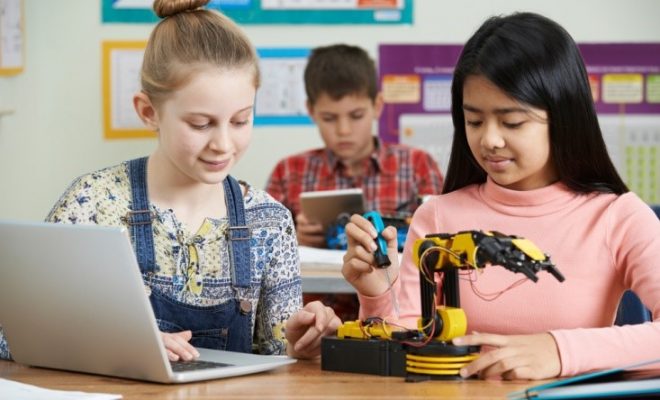
One of the most popular methods of facilitating deep learning in K-12 schools in problem-based learning. It starts, as the name suggests, with a problem. In this model, students are presented with an open-ended problem. Students must search through a variety of resources, called trigger material, to help them understand the problem from all angles. What would project-based learning look like in a subject like science? That’s what I plan to explore in this piece. Below you will find a list of 14 project-based learning activities for the K-12 science classroom.
- Student Farm. Students will learn lessons about science, social studies, math, and economics through planting their organic farm. They can begin by researching the crops they want, figure out what kind of care is needed, and then use a budget to determine what materials they must purchase. They can even sell food from their farm to contribute to a cause or fundraiser.
- Bridge Building. Students begin by studying the engineering of bridge building, comparing the construction of famous bridges such as the Golden Gate Bridge or Tower Bridge in London. Then they work in teams to construct bridges out of Popsicle sticks. The challenge is to get their bridge to hold five pounds (for younger students) or twenty pounds (for more advanced students).
- Shrinking Potato Chip Bags in the Microwave. Students can learn about polymers through hands-on activities using some of their favorite products, like shoes and sporting equipment. As a culminating activity, they can put a wrapper from their favorite chips or candy bar into the microwave for five seconds to learn about how polymers return to their natural state when exposed to the heat.
- Design an App. Students love using the newest apps and games, so take it to the next level by having them design their own! With Apple developer tools, kids can learn how to create an app or online game. They can learn about technology and problem-solving skills while engaged in what they love.
- Gummy Bear: Shrink or Grow? For a project-based lesson on osmosis and solubility, you will just need gummi bears and different liquids and solutions (water, salt water, vinegar, etc.). Children will place a gummi bear in each solution overnight and then measure the results.
- The Old Egg in a Bottle Trick . This old trick is an impressive PBL activity for kids to learn about the correlation between temperature and pressure,. Using just eggs, a wide mouth glass bottle, matches, and strips of paper, children will be able to make an egg “magically” fit through the bottle’s opening.
- Cabbage Acid-Base Indicator . Children will love this hands-on approach to learning how to identify an acid or a base just using purple cabbage and seeing colors change.
- Carnation Color Wonders . An uncomplicated way to teach the importance of the various parts of the flower, the carnation color experiment shows kids how stems provide nourishment to the whole plant.
- Polymers & Pampers . If your middle school scientist has a younger sibling at home in diapers, this is a great PBL activity to teach how polymers are essential for products like diapers.
- Make a Battery Using… Anytime a kid can turn produce into a battery, it is fun! So, why not compare a lemon battery to a potato battery to see which one works better?
- Helmet Drop Test . The helmet drop test is a practical PBL project to teach kids the importance of safety helmets. Simply gather different types of helmets and a several melons. Strap the helmets to the melons and drop each from the same height and measure the results.
- How Much Sugar is in that Soda? . Health-conscious parents will love this PBL activity because it teaches kids how much sugar is in their soft drinks. If you have soft drinks, sugar, and measuring cups, you can do this experiment in your kitchen.
- Ways to Clean a Penny . To teach children how acid reacts with salt works to remove the dullness of pennies, kids can do a simple PBL activity using salt and vinegar. They can also test other acids to compare results.
- Oranges: Float or Sink? . To teach kids about density, all you need are oranges and a bowl of water. You can add to this experiment by testing other fruits with peels.
Did we miss any. Please share your favorite project-based learning activities in the comments below.
How College Athletics Programs are Innovativating with ...
How teachers can use podcasts to promote ....
Matthew Lynch
Related articles more from author.

Plagiarism Concerns Are Prevalent Among US Students

The 10 Best Memphis BBQ Joints That Redefine Smoky Southern Flavor

The Year’s Best International Crime Series

Best Nonfiction 2024
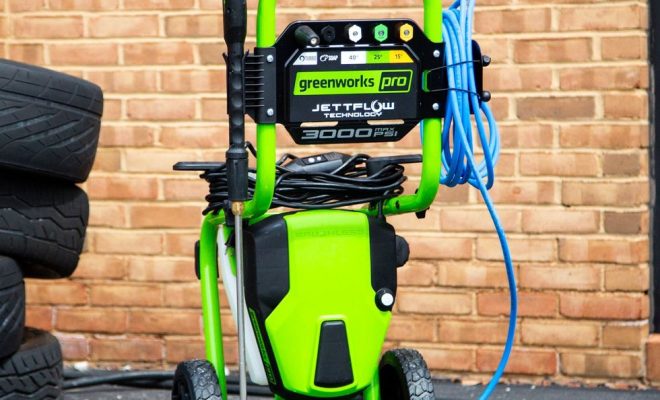
Best Pressure Washers, Tested – Car and Driver

Where Do Teachers Turn for Technology Assistance?
- Grades 6-12
- School Leaders
Free end-of-year letter templates to your students 📝!
65+ Real-World Project-Based Learning Ideas for All Ages and Interests
Find and implement solutions to real-world problems.
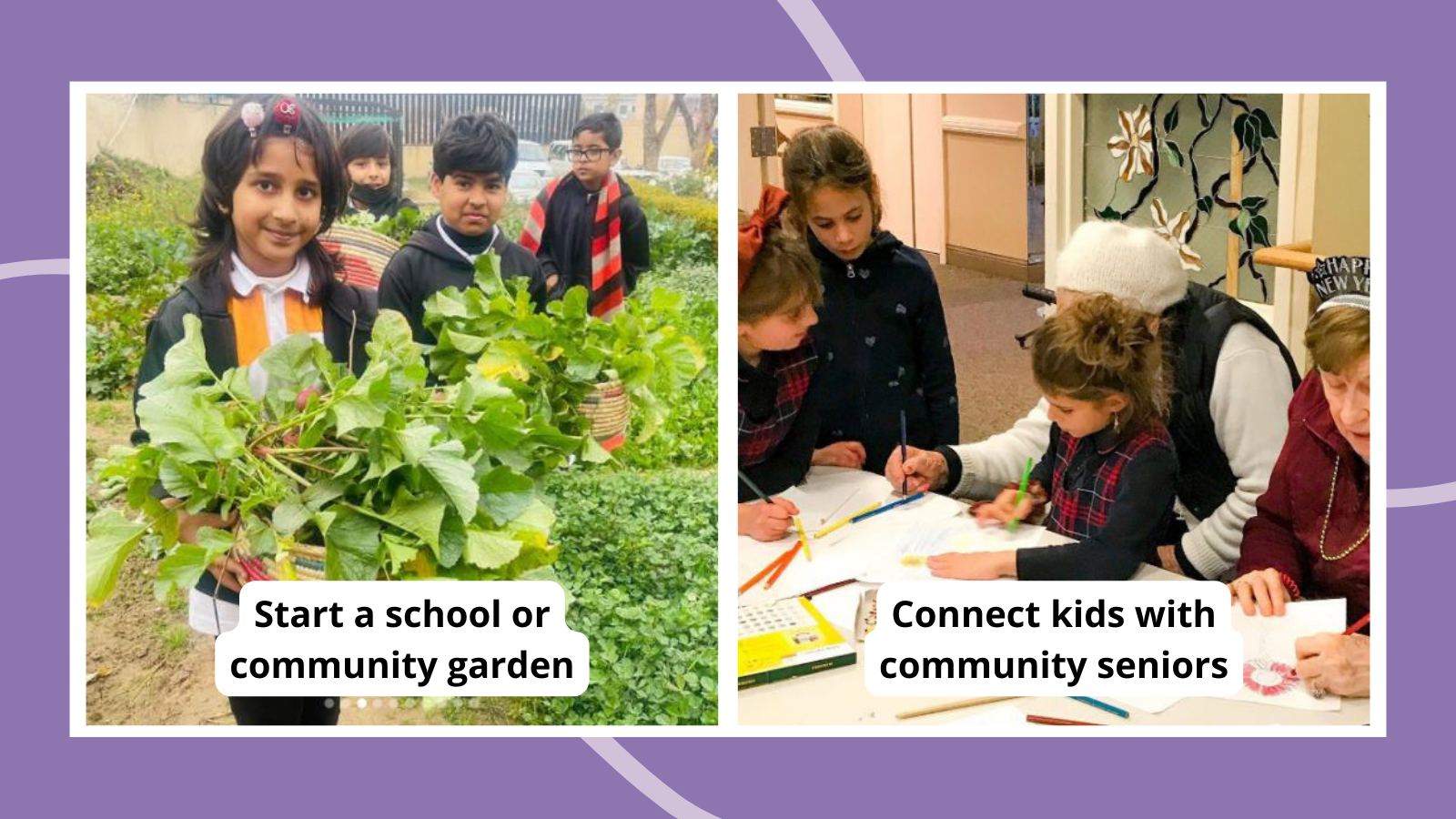
Project-based learning is a hot topic in many schools these days, as educators work to make learning more meaningful for students. As students conduct hands-on projects addressing real-world issues, they dig deeper and make personal connections to the knowledge and skills they’re gaining. But not just any project fits into this concept. Learn more about strong project-based learning ideas, and find examples for any age or passion.
What is project-based learning?
Project-based learning (PBL) uses real-world projects and student-directed activities to build knowledge and skills. Kids choose a real-world topic that’s meaningful to them (some people call these “passion projects”), so they’re engaged in the process from the beginning. These projects are long-term, taking weeks, months, or even a full semester or school year. Students may complete them independently or working in small groups. Learn much more about project-based learning here.
What makes a good PBL project?
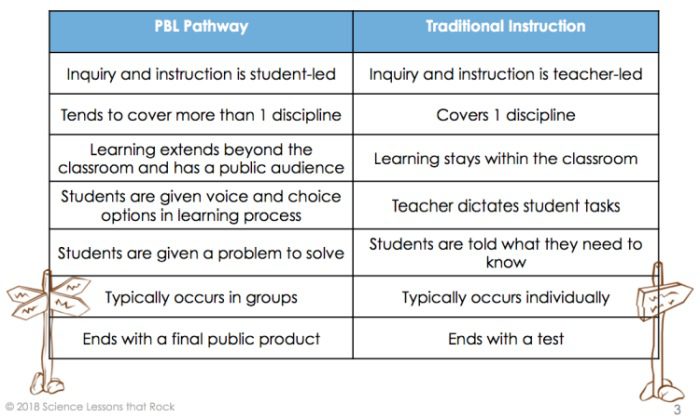
In many ways, PBL is more like the work adults do in their daily jobs, especially because student efforts have potential real-world effects. A strong PBL project:
- Addresses a real-world issue or problem
- Requires sustained and independent inquiry, in and out of the classroom
- Allows students voice and choice throughout the project
- Combines elements of many disciplines
- Includes collaboration with public partners, such as universities, community organizations, or businesses
- Produces a public product that is seen by those outside the school community
- Covers a complete process, including activities like research, design, production, marketing or public awareness, and enlisting supporters or investors
Outdoor Project-Based Learning Ideas
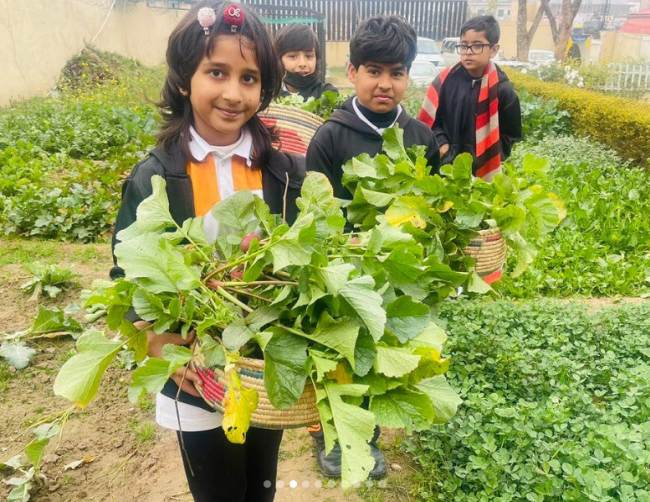
- Create a new local park, or improve an existing one by adding new features or providing needed maintenance.
- Plant a community garden to provide food for a soup kitchen, food pantry, or other organization.
- Design and create a butterfly, pollinator, or other wildlife garden to support the local ecosystem.
- Build a new walking or biking trail that’s safe for people of all ages to use.
- Devise and implement a way to reduce litter in your community.
- Set up and manage a school or community compost pile, and distribute the resulting soil to those who need it most.
- Find and help the public use a new way to grow food that requires less soil, water, or fertilizers, which are in short supply in some parts of the world.
- Design, build, and install a completely unique piece of playground equipment that serves a specific purpose or need.
School Community Project-Based Learning Ideas
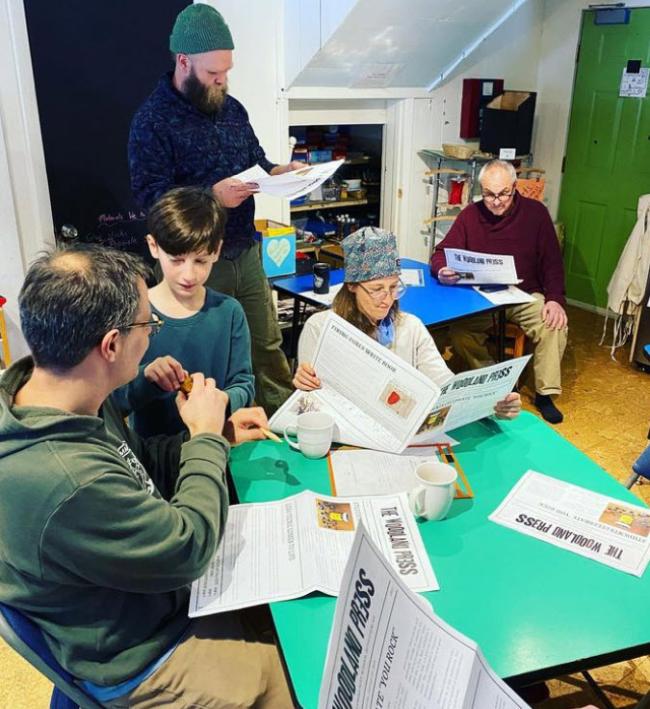
- Start a comprehensive recycling program at school, or substantially improve participation in an existing one.
- Add collaborative artwork like murals or other displays to school hallways, bathrooms, or grounds.
- Determine a location or program at your school that needs improvement, then make a plan, raise the funds, and implement your ideas.
- Come up with ways to celebrate your school’s diversity and improve relationships between all students.
- Start and run a school store , including inventory, financial plans, and marketing.
- Write a school handbook for new students, with tips and tricks for helping them feel at home.
- Figure out how to offer healthier, better-tasting meals and snacks in the school cafeteria.
- Implement a mentoring program for older students to help younger students, with planned activities and appropriate training for older students.
- Design and propose a new style of grading system that ensures equity.
- Find ways to improve the indoor recess experience at your school.
- Set up and run a new school newspaper, magazine, podcast, video channel, etc.
Greater Community Project-Based Learning Ideas
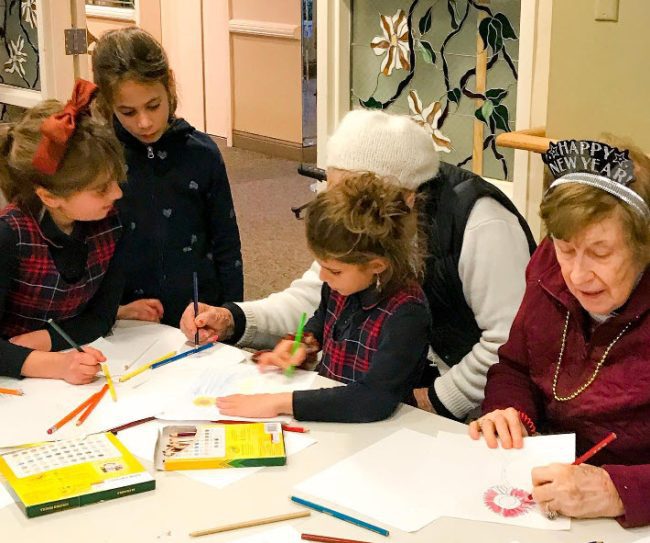
- Coordinate a community art project in a central location to celebrate local culture or artists.
- Set up a program for schoolkids to socialize with senior citizens in nursing homes, hospitals, or retirement communities.
- Create a program to offer free translation services for ESL families in the community.
- Help a local animal shelter improve its facilities, or find new ways to match homeless pets with their forever families.
- Build and maintain Little Free Libraries around your community, especially in underserved areas.
- Help local businesses become more environmentally conscious, increasing sustainability and decreasing waste.
- Create and lead a walking tour of your community, highlighting its culture, history, landmarks, and more.
- Find a way to record and celebrate local voices in your community’s history.
- Come up with ideas for welcoming immigrants and other newcomers to your community.
- Set up a series of events that will encourage the community to mix and experience each others’ foods, cultures, and more.
- Create and implement a new program to inspire a love of books and reading in preschool students.
- Set up and help run a new charitable organization your community needs.
Social Issues Project-Based Learning Ideas
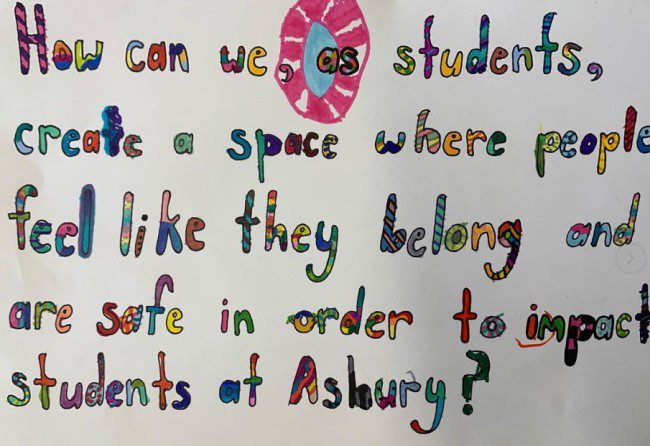
- Start an awareness campaign on a topic that’s important to you, like anti-bullying, healthy living, protecting the environment, civil rights, equality and equity, etc.
- Come up with and implement ways to increase voter turnout in your community, especially among younger voters.
- Write, record, and share with a wider audience your own TED Talk–style video on an issue that hasn’t been covered yet or on which you have a unique perspective.
- Devise and implement ways for unheard voices to be amplified in your school or community.
- Write and publicly perform a play that highlights a social issue that’s important to you.
- Look for areas in your community that present challenges to those with disabilities, and help to improve them to overcome those challenges.
- Research, write, and publicly present and defend a position paper on an issue that’s important to your community.
- Choose a real court case, then research the law and work with legal experts to prepare and present your own case as you would in a courtroom.
- Write, edit, seek, and incorporate real-world feedback, and publish or publicly present your own book, poem, or song on an issue that’s important to you.
- Start a program to teach a specific group (e.g., preschoolers, senior citizens, business owners) to care for and protect the environment.
- Plan and hold a fundraiser to support an issue you care about.
- Choose a law you feel is unjust, and write, research, and publicly present and defend a position paper about your desired change.
STEM Project-Based Learning Ideas
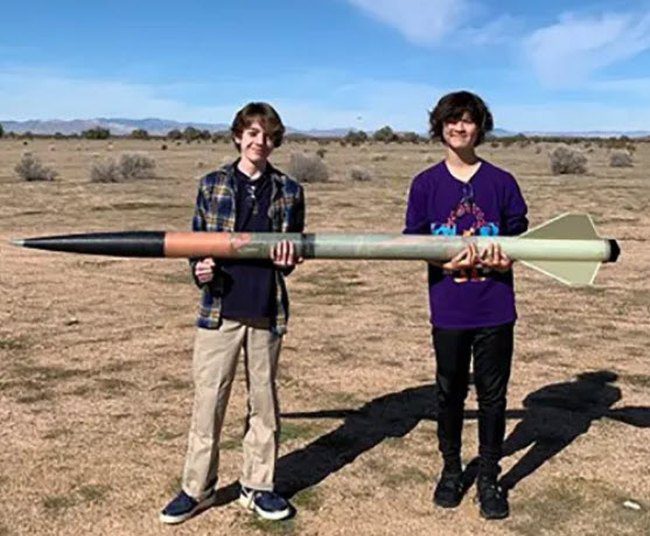
- Create an app that meets a specific purpose for a specific audience.
- Invent something new that the world needs, and then fund, create, and sell your product in the community.
- Design a game to help students learn important STEM concepts.
- Find a simple way to improve an existing product, especially if it cuts costs or improves environmental sustainability.
- Explore ways to reduce the amount of waste we produce, especially plastic and other landfill-bound items.
- Write a book or graphic novel that’s entertaining but also teaches kids about science or math.
- Devise new ways to provide clean drinking water to communities where water is scarce.
- Build an effective solar oven people can use to cook during extended power outages, or in areas where electricity isn’t available.
- Work with a university or STEM organization to gather, analyze, and present real-world scientific data.
- Design a building to fit a specific purpose or need, including researching the requirements and zoning laws, accurately drafting a plan, determining the costs, and presenting the plan to the proposed client.
- Create an interactive hands-on exhibit to teach people about STEM concepts.
- Determine a type of website you believe is missing, then research, build, and publish the site you envision.
Creative Arts Project-Based Learning Ideas

- Organize an art show for the community, seeking out those who ordinarily might not have a chance to display their work.
- Create and teach an art class in your area of expertise to children, the elderly, or another segment of the population.
- Design a mural for an area in your community that needs beautification, and seek funding or other assistance from community members to install it.
- Write a play about a topic that’s meaningful to you or your community. Work with the community to stage a performance for all to attend.
- Invite local dancers to perform at a school or community Festival of Dance, highlighting a variety of cultures and dance styles.
- Start a regular writer’s workshop where community writers can come together to share and seek feedback. Invite local authors or publishing experts to speak as guests.
- Collect stories, poems, and essays from local authors, and put them together into a book. Sell the book to raise money for a cause that’s important to local writers.
- Gather singers or instrumentalists from your community into a choir or band. Put on a concert to raise money for a special cause, or take your choir on tour to local retirement homes, hospitals, etc.
- Write a song about a person or cause that’s important to you. Produce and record the song, then find a way to share it with others.
- Make a short film about a local hero, community event, or local place. Invite others to do the same, and organize a local film festival.
What are some your favorite project-based learning ideas? Come share your thoughts in the We Are Teachers HELPLINE group on Facebook !
Plus, meaningful service learning projects for kids and teens ..
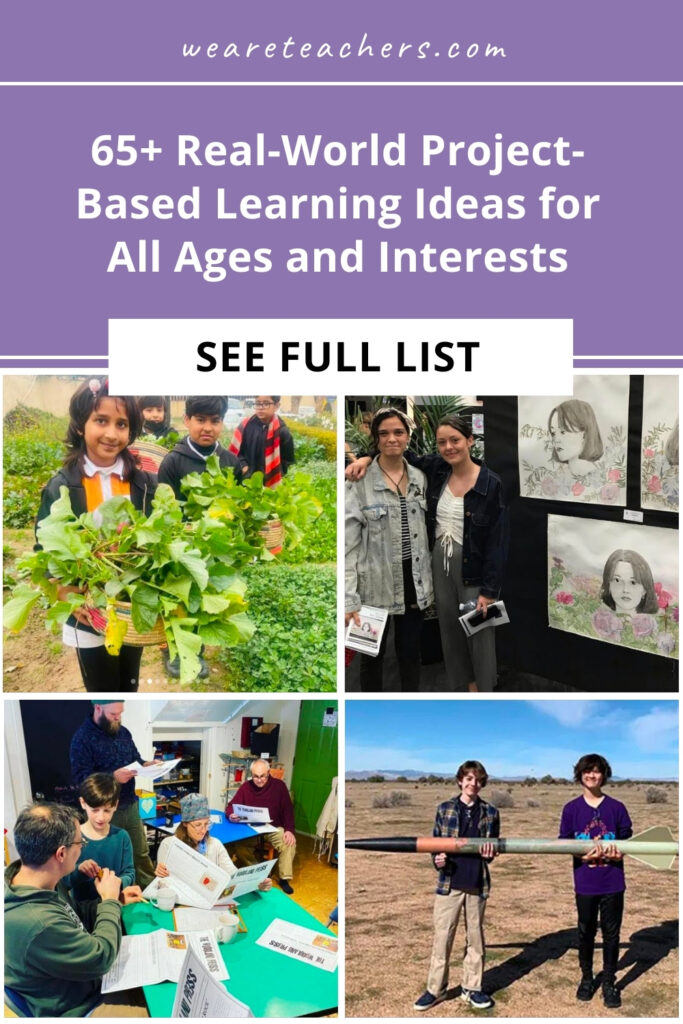
You Might Also Like
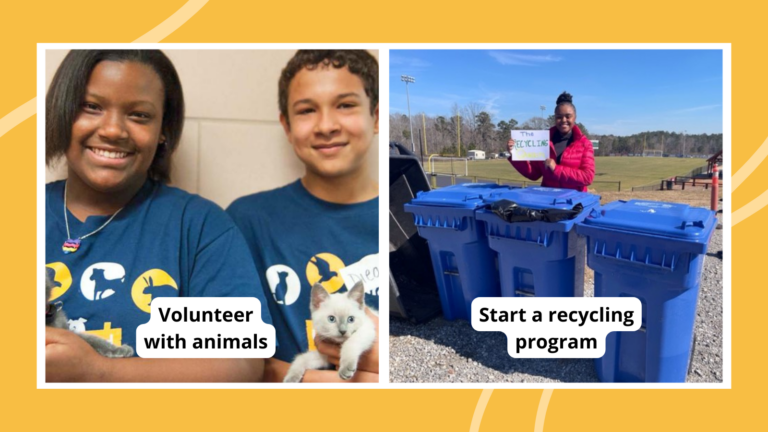
30 Meaningful Service Learning Projects for Kids and Teens
Inspire a sense of community and generosity. Continue Reading
Copyright © 2024. All rights reserved. 5335 Gate Parkway, Jacksonville, FL 32256

Top 10 Physics Science Fair Projects
by Samantha Johnson | Oct 18, 2023 | Science Projects , Top
Physics science fair projects offer an exciting avenue for students to delve into the fascinating world of physics. From exploring the fundamental laws of motion to discovering the mysteries of quantum mechanics, these projects provide a unique opportunity for students to engage in hands-on exploration, inquiry, and discovery. They have the chance to investigate a wide range of topics. Students develop critical thinking skills, problem-solving abilities, and a deeper understanding of scientific concepts by designing experiments, conducting observations, and analyzing data.
They learn to apply the scientific method, formulate hypotheses, and draw conclusions based on evidence. In this article, we will look at the 10 top physics science fair projects that will serve as a platform for students to explore the mysteries of the physical world, unlock their potential as young scientists, and ignite a lifelong passion for scientific inquiry.
List of Top 10 Physics Science Fair Projects
1. Exploring Superconductivity: Zero Resistance Wonders
Investigating superconductivity allows students to delve into cutting-edge research and provides an opportunity to understand the fundamental principles of quantum mechanics and materials science. Exploring superconductivity as a physics science fair project fuels scientific curiosity and encourages a passion for innovation and discovery.
Engaging in superconductivity projects allows students to develop experimental skills, critical thinking, and an understanding of the potential applications of superconductors in various fields, such as energy transmission, magnet technology, and medical imaging.

To demonstrate the superconductivity:
- Investigate the critical temperature, which is the temperature at which a material becomes superconducting, and study the factors that influence it.
- Explore the phenomenon of flux pinning, where superconductors trap and hold magnetic fields.
- Investigate the relationship between magnetic field strength and the stability of flux pinning, providing insights into the intricate dynamics of superconducting materials.
2. Newton’s Laws of Motion: From Rest to Motion
Newton’s Laws of Motion form the cornerstone of classical physics and provide an interesting topic for physics science fair projects. Investigating these laws allows students to explore the fundamental principles that govern the motion of objects. Students contribute to the ongoing understanding and application of Newton’s Laws of Motion by showcasing their projects.

To understand Newton’s Laws of Motion :
- Design experiments to demonstrate Newton’s First Law by observing the behavior of objects on different surfaces or in different environments.
- As per Newton’s Second Law, investigate the relationship between force, mass, and acceleration.
- Investigate Newton’s Third Law by designing experiments that demonstrate the concept of action-reaction pairs.
- Explore the practical applications of these laws, such as the design and optimization of vehicles, sports equipment, and everyday objects. Analyze the forces involved in various motions, such as projectile or circular motion, and investigate the factors that affect these motions.
3. Heat Transfer: Conduction, Convection and Radiation
Investigating heat transfer allows students to understand the principles behind the movement of thermal energy and explore their practical applications. They can explore real-world applications, such as improving insulation, designing efficient cooling systems, or understanding the behaviour of thermal radiation. This physics science fair project helps you understand the importance of efficient energy management and highlights the impact of heat transfer on various aspects of our daily lives.

To investigate heat transfer:
- For conduction , design experiments to study how heat flows through different materials and investigate the factors that influence the heat transfer rate. Explore concepts such as thermal conductivity, insulation, and surface area.
- For convection , examine the movement of fluids and how it affects heat transfer. Investigate the role of density, temperature gradients, and fluid circulation in the transfer of thermal energy.
- For radiation , investigate what involves the emission and absorption of electromagnetic waves. Explore the properties of different materials and their ability to absorb, reflect, or transmit heat radiation.
4. Investigating Black Holes: Unveiling the Secrets of Space
Black holes, cosmic objects with immense gravitational pull, provide an intriguing subject for physics science fair projects. Exploring black holes allows students to delve into the mysteries of space. It offers an opportunity to understand the principles of gravity, spacetime, and the behavior of matter under extreme conditions. Engaging in black hole projects enables students to develop their understanding of general relativity , quantum mechanics, and the universe’s structure.

To investigate black holes :
- Design experiments or simulations to study their properties, such as event horizons and gravitational lensing. Analyze astronomical observations and explore the evidence supporting the existence of black holes.
- Explore the processes involved in the formation and evolution of black holes.
- Investigate the collapse of massive stars or other scenarios that lead to the formation of black holes, shedding light on the life cycle of these cosmic phenomena.
5. Understanding Radioactivity: Decay and Half-Life
Investigating radioactivity allows students to explore the principles of nuclear decay and the concept of half-life while highlighting their practical applications in various fields. Students contribute to the understanding and practical applications of nuclear physics by showcasing their physics science fair project. They can explore real-world applications , such as radiometric dating, radiation therapy, or the use of nuclear energy.

To understand radioactivity :
- Design experiments to study radioactive decay and measure decay rates.
- Explore the concept of half-life, which represents the time it takes for half of a radioactive substance to decay, and investigate the factors that influence it.
- Investigate different methods of measuring radioactivity and explore the use of radiation detectors or Geiger-Muller counters.
- Analyze the relationship between radioactive decay and the emission of different types of radiation, such as alpha, beta, or gamma particles.
6. The Science of Mirrors: Reflection and Image Formation
The science of mirrors, focusing on reflection and image formation, serves as an interesting topic for physics science fair projects. Investigating the principles behind mirrors allows students to understand the behaviour of light and the practical application of mirror principles. They can explore practical applications, such as the design of optical instruments, artistic illusions, or the use of mirrors in everyday life.

To understand the science of mirrors :
- Design experiments to explore the laws of reflection.
- Analyze the relationship between the incident and reflected angles and observe the behavior of light rays as they interact with different mirror surfaces.
- Investigate image formation using mirrors.
- Explore the formation of real and virtual images by different types of mirrors, such as plane, concave, or convex mirrors.
- Understand the concepts of magnification, focal length, and image characteristics by manipulating object distances and observing the resulting images.
7. Investigating the Doppler Effect: Sound and Light in Motion
The Doppler Effect, which describes the change in frequency or pitch of sound and light waves as a source or observer moves relative to each other, provides a fascinating topic for physics science fair projects. Exploring the Doppler Effect allows students to understand the behavior of waves in motion and the principles of wave dynamics. They can explore the intricate relationship between motion and wave behavior while uncovering the fundamental principles that govern these phenomena.

To understand the Doppler effect :
- Design experiments to demonstrate and analyze this phenomenon in sound and light waves.
- Investigate the frequency shifts experienced by stationary observers as sources move towards or away from them.
- Investigate the applications of Doppler radar systems for weather monitoring and Doppler ultrasound in medical diagnostics.
- Understand the significance and impact of the Doppler Effect in real-world scenarios.
8. The Physics of Fluid Pressure: From Hydraulics to Pneumatics
Investigating fluid pressure allows students to explore the fundamental principles of fluid mechanics and their practical applications. Engaging in projects centered around fluid pressure enables students to develop their experimental skills, critical thinking, and understanding of energy transmission.
They can explore real-world applications, such as hydraulic machinery, pneumatic systems , or the human body’s circulatory system. Students contribute to the understanding and practical applications of fluid pressure by showcasing their physics science fair project.

To understand the physics of fluid pressure :
- Design experiments to demonstrate and analyze concepts such as Pascal’s law, which describes the transmission of force through confined fluids in hydraulic systems.
- They can construct setups using syringes or hydraulic jacks to showcase the multiplication of force through fluid pressure.
- Explore pneumatics, which involves compressed gases to transmit force and energy.
- Design experiments using air compressors, valves, and actuators to demonstrate the conversion of potential energy into kinetic energy through air pressure.
9. Understanding Nuclear Fusion: Creating a Mini Sun
The sun’s nuclear fusion process makes for a fascinating topic for physics science fair projects. Investigating nuclear fusion allows students to explore the principles of fusion reactions and the potential for clean and abundant energy sources.
They can explore the complexities of fusion reactions, the behaviour of plasma, and the potential impact of fusion energy on addressing global energy needs. Students contribute to the ongoing research and understanding of nuclear fusion by showcasing their projects.

To understand Nuclear Fission :
- Design experiments or simulations to understand the conditions required for fusion reactions.
- Investigate factors such as temperature, pressure, and fuel composition that influence the initiation and sustainability of fusion reactions.
- Explore the practical applications of nuclear fusion as a potential energy source.
- Analyze the challenges and advancements in fusion reactor designs, explore the potential of fusion as a clean and sustainable power generation method, and investigate the technologies developed to harness fusion energy.
10. The Physics of Music: Investigating Harmonics and Instruments
Investigating the principles behind harmonics and musical instruments allows students to explore the intricate relationship between physics and the art of sound. Engaging in this physics science fair project enables students to develop their experimental skills, critical thinking, and understanding of wave dynamics.
They can explore the acoustics of different instruments, the behavior of sound waves , and the principles that shape musical sounds. They inspire others with the wonders of sound and music and highlight the remarkable interplay between physics, art, and the joy of creating and appreciating music.

To understand the physics of music :
- Design experiments to study harmonics and the relationship between fundamental frequencies and overtones.
- Analyze the properties of different musical instruments and explore how they produce specific harmonic patterns.
- Investigate the physics behind instrument construction.
- Investigate elements like string tension, tube length, or vibrating surfaces to learn how they affect the sound that instruments generate.
- Explore the connection between instrument design, physics principles, and musical tones.
Physics science fair projects offer an enriching experience for students to delve into the fascinating world of physics. By exploring topics such as waves, forces, electricity, optics, and more, students gain a deeper understanding of the fundamental principles that govern the universe. These projects provide a platform for students to develop critical thinking, problem-solving, and experimental skills while fostering their creativity and passion for scientific exploration. Through their innovative projects, students contribute to the advancement of knowledge, inspire curiosity in others, and showcase the incredible potential and practical applications of physics.
Also Read: Top Project Ideas For Nanotechnology

Samantha Johnson is a passionate writer and enthusiast for creative projects and innovative ideas. Specializing in project ideas, she understands the unique interests and cultural nuances that shape our future generation. Whether it’s DIY crafts, home improvement, or technology-based innovations, she seeks out projects that align with the spirit of innovation, resourcefulness, and entrepreneurship. Samantha aims to inspire and empower her readers, helping them explore their creativity and turn their ideas into reality.
Search your Ideas here
Related projects.
- Best Science Projects for 2nd Graders
- 10 Simple Science Fair Topics
- Top 20 Science Project Research Ideas
- Science Fair Project Ideas For 8th Graders
- Top 10 Mind-Blowing Science Projects That Will Amaze…
- Top DIY Lash Extensions Ideas 2024
- Best Homemade Febreze Recipes 2024
- How To Make Homemade Goo Gone For Wood & Glass
- How To Make Homemade Paint
- How To Make A DIY 18650 Power Bank?
Most Viewed Ideas
- How To Make Earthquake Alarm Working Model
- How To Make A Kidney Working Model
- Long and Short Wavelength Colours | Science Experiment
- How To Make An Air Cooler Science Model
- How To Make A Calendar Application in C++ | C++ Project
You May Also Like To Create…

Top 5 DIY Planter Box Ideas
Introduction Are you ready to add a touch of greenery to your home or garden? DIY planter...

Easy DIY Closet Ideas To Try In 2024
Introduction In 2024, revamping your closet space has never been easier with these five...

5 Best DIY Gnat Trap Ideas
Introduction Do the irritating gnats bother you as well? Are you tired of them flying around your...
Submit a Comment Cancel reply
Your email address will not be published. Required fields are marked *
Save my name, email, and website in this browser for the next time I comment.
Submit Comment

- Paper Craft
- Environment
- Electronics
- Machine Learning
- Engineering
- Science Projects
- Decoration Ideas
- Online Training
- Video Tutorials
- Submit your Ideas
- Advertise with us
- Privacy Policy
- Terms and Conditions
10 Unique Science Investigatory Project Ideas
1. bioluminescent bacteria: investigate glow-in-the-dark bacteria for eco-friendly lighting solutions., 2. solar desalination: create a solar-powered device to purify seawater for drinking., 3. magnetic levitation: explore levitating objects using magnetic fields for practical applications., 4. plant-based water filtration: develop filters using plants to purify contaminated water., 5. edible packaging: invent biodegradable packaging materials from edible substances., 6. ai-powered agriculture: implement ai for optimizing crop growth and resource management., 7. hydrogen fuel cells: build a system converting water into clean energy for vehicles., 8. electromagnetic railgun : construct a railgun propelled by electromagnetic forces., 9. 3d printed organs: utilize 3d printing to create artificial organs for medical transplants., 10. self-healing materials: develop materials capable of repairing themselves for durability., discover more stories.
Top 151+ Mini Project Ideas For Engineering Students

Engineering education is a dynamic blend of theoretical knowledge and practical application. Mini projects stand as a cornerstone of this learning journey, offering students a chance to bridge the gap between classroom concepts and real-world scenarios. These projects not only nurture creativity and problem-solving skills but also provide a platform to dive into various engineering disciplines.
In this blog, we’re excited to present a curated list of more than awesome mini project ideas for engineering students. Ranging across diverse domains, these ideas promise to ignite curiosity, enhance technical prowess, and encourage hands-on exploration. Whether you’re an electrical enthusiast, a computer science prodigy, a mechanical maven, or an aspiring civil engineer, there’s a project idea here for you.
What is Mini Project in Engineering?
Table of Contents
A mini project in engineering is a small-scale hands-on task that students undertake to apply the concepts they’ve learned in their studies. It’s like a practical experiment where they work on a real-world challenge, building something or solving a problem using engineering principles. Mini projects help students bridge the gap between theory and practice, allowing them to gain valuable skills, enhance creativity, and get a taste of what working as an engineer might be like. These projects can cover various fields, such as electronics, software, mechanics, or even environmental issues, providing a practical and fun way to learn and explore.
Purpose of Mini-Projects for Engineering Students
Mini projects hold a crucial role in the academic curriculum of engineering students. They serve several valuable purposes, contributing to holistic skill development and knowledge enhancement. Here are some key reasons why mini-projects are essential for engineering students:
Application of Theory
Mini projects provide a platform for students to practically apply the theoretical concepts they have learned in their lectures. This application enhances their understanding of the subject matter and promotes deeper learning.
Problem-Solving Skills
Engineering is all about problem-solving. Mini projects expose students to real-world challenges, encouraging them to think critically and come up with innovative solutions.
Hands-On Experience
These projects offer a hands-on experience of working with tools, technologies, and equipment that are commonly used in the industry. This practical exposure is invaluable for future engineering careers.
Teamwork and Collaboration
Many mini projects are designed to be completed in teams. This promotes teamwork, collaboration, and effective communication among students – essential skills for any engineering job.
Time Management
Mini projects have deadlines, helping students develop time management skills as they need to balance their project work with other academic commitments.
Portfolio Building
Successful completion of mini-projects allows students to build a portfolio showcasing their practical skills and projects, which can be beneficial for job applications.
Exploration of Interests
Mini projects often allow students to choose projects aligned with their interests, helping them explore potential career paths within engineering.
Mini Project Ideas For Engineering Students
Here are some mini project ideas for engineering students:
1. Smart Home Automation System
Create a system that allows users to control household appliances remotely through a mobile app or voice commands.
2. Solar-Powered Phone Charger
Design a portable charger that uses solar panels to recharge mobile devices, perfect for eco-friendly charging on the go.
3. Bluetooth-Based Health Monitoring System
Develop a wearable device that measures vital signs and sends data to a smartphone app via Bluetooth for health tracking. This is one of the major mini project ideas for engineering students.
4. Gesture-Controlled Robot
Build a robot that can be controlled using hand gestures, providing a hands-free way to navigate and interact with its surroundings.
5. Automated Plant Watering System
Construct a system that monitors soil moisture levels and waters plants automatically, ensuring optimal growth and hydration.
6. Home Security System with Intruder Detection
A home security system is one of the important mini project ideas for engineering students. Design a security system with motion sensors and cameras that send alerts to the user’s phone when suspicious activity is detected.
7. Traffic Density Analyzer
Create a system that uses image processing to analyze traffic density and provides real-time data to commuters.
8. Voice-Activated Home Assistant
Build a voice-controlled assistant that can answer questions, set reminders, and control smart devices around the house.
9. Virtual Reality (VR) Tour of Historical Sites
Develop a VR experience that allows users to explore historical landmarks and sites from the comfort of their homes.
10. Smart Mirror
Construct a mirror that displays real-time information like weather, calendar events, and news headlines. This is one of the best mini project ideas for engineering students.
11. Automated Pet Feeder
Design a device that dispenses food for pets at scheduled times, even when the owner is away.
12. Home Energy Monitoring System
Create a system that monitors and displays energy consumption in real time, helping users make informed decisions about energy usage.
13. QR Code-Based Campus Navigation
Develop an app that uses QR codes placed around the campus to guide users to different buildings and locations.
14. Weather Station with Data Logging
Build a weather station that records temperature, humidity, and atmospheric pressure, storing data for analysis.
15. Smart Dustbin with Segregation
Design a smart dustbin that uses sensors to sort recyclable and non-recyclable waste, promoting eco-friendly waste disposal.
16. Automatic Library Book Locator
The automatic library book locator is one of the exciting mini project ideas for engineering students. Create a system that uses RFID tags to help users locate books within a library easily.
17. Voice-Controlled Car
Build a miniature car that responds to voice commands for various functions like forward, backward, left, and right.
18. Remote-Controlled Quadcopter
Construct a quadcopter that can be controlled remotely, exploring aerial photography and navigation.
19. Home Garden Automation System
Design a system that monitors and controls irrigation, lighting, and temperature for a home garden.
20. RFID-Based Attendance System
Develop a system that uses RFID cards to automate attendance tracking in classrooms or offices.
21. Biometric Door Lock
Create a door lock system that uses fingerprint or facial recognition for enhanced security.
22. Morse Code Translator
Build a device that translates text into Morse code and vice versa, teaching users this historical communication method.
23. Voice-Controlled Music Player
Design a music player that changes tracks, adjusts volume, and plays specific songs in response to voice commands.
24. Arduino-Based Game
Develop a simple electronic game using Arduino, providing entertainment and hands-on coding experience. This is one of the key mini project ideas for engineering students.
25. GPS-Based Navigation System
Create a navigation system that guides users to a destination using GPS and displays real-time directions.
26. Smart Water Quality Monitoring System
Build a device that measures water quality parameters like pH, turbidity, and temperature, transmitting data to a mobile app.
27. E-Commerce Price Comparison App
Develop a mobile app that scans barcodes and compares prices of products across different online stores.
28. Home Workout Assistant
Home Workout Assistant is one of the well-known mini project ideas for engineering students. Design an app or device that guides users through home workouts, tracking progress and suggesting exercises.
29. Language Translation Device
Create a handheld device that can translate spoken language in real-time, aiding communication between different language speakers.
30. Gesture-Controlled Prosthetic Hand
Build a prosthetic hand that can be controlled using hand gestures, offering amputees a more intuitive and natural way to interact.
31. Smart Parking System
Design a system that uses sensors to identify available parking spots and guides drivers to vacant spaces.
32. Automated Greenhouse System
Create an automated greenhouse with sensors that maintain ideal conditions for plant growth, controlling factors like temperature, humidity, light, and soil moisture.
33. Smart Traffic Light Control System
Design a traffic light system that optimizes flow using real-time data, adjusting light durations based on traffic patterns to alleviate congestion.
120 Mini Project Ideas For Engineering Students
Here are a few more specific mini project ideas for engineering students:
- Bluetooth-Based Attendance System
- Voice-Controlled Home Automation
- IoT-Based Water Quality Monitoring
- Face Recognition Door Lock
- Smart Waste Management System
- Automated Railway Crossing System
- Mobile Controlled Robot
- Voice-Activated Alarm Clock
- Solar-Powered Water Heater
- Home Energy Management System
- GPS-Based Fleet Tracking
- Smart Bicycle Lock
- Gesture-Controlled Drone
- Biometric ATM System
- Touchless Hand Sanitizer Dispenser
- RFID-Based Inventory Management
- Smart Wearable for Senior Citizens
- Pollution Monitoring System
- Smart Agriculture System
- RFID-Based Toll Collection
- Voice-Controlled Home Security
- Solar-Powered Air Conditioning
- Smart Helmet for Bike Riders
- IoT-Based Smart Vending Machine
- Home Automation with Face Recognition
- Remote-Controlled Lawn Mower
- Gesture-Controlled PC
- IoT-Based Air Quality Monitoring
- Water Level Monitoring System
- Voice-Activated Light Switch
- Smart Shopping Cart
- Automated Pet Grooming System
- RFID-Based Access Control
- Gesture-Controlled Robotic Arm
- Smart Water Heater Control
- IoT-Based Smart Mirror
- Face Recognition Attendance System
- Voice-Controlled Home Theater
- RFID-Based Smart Locker System
- Smart Food Ordering System
- Automatic Street Light Control
- Home Automation with IoT
- Voice-Controlled Garage Door Opener
- IoT-Based Smart Parking
- Gesture-Controlled Home Appliances
- RFID-Based Smart Museum Guide
- Smart Refrigerator
- Voice-Activated Temperature Control
- IoT-Based Plant Monitoring
- Automated Pet Surveillance
- Solar-Powered Street Lighting
- Gesture-Controlled Gaming Console
- Smart Bicycle Tracker
- Voice-Controlled Home Brewery
- IoT-Based Smart Greenhouse
- RFID-Based Smart Shopping Cart
- Smart Geyser Control System
- Automated Plant Health Monitoring
- Solar-Powered Water Pump
- Gesture-Controlled Home Lighting
- IoT-Based Smart Locker System
- RFID-Based Asset Tracking
- Voice-Controlled Garage Security
- Smart Water Purifier
- Automated Greenhouse Irrigation
- Solar-Powered Irrigation System
- Gesture-Controlled Drone Photography
- IoT-Based Waste Sorting
- RFID-Based School Attendance
- Voice-Activated Coffee Maker
- Smart Fish Tank
- Automated Home Brewery
- Solar-Powered Air Purifier
- Gesture-Controlled Smart Glasses
- IoT-Based Home Safety
- RFID-Based Library Management
- Voice-Controlled Smart Garden
- Smart Beehive Monitoring
- Automated Plant Fertilization
- Solar-Powered Ventilation System
- Gesture-Controlled Virtual Keyboard
- IoT-Based Smart Backpack
- RFID-Based Luggage Tracking
- Voice-Activated Car Security
- Smart Bird Feeder
- Automated Pet Entertainment
- Solar-Powered Fan
- Gesture-Controlled TV Remote
- IoT-Based Smart Bike Lock
- RFID-Based Museum Exhibit Control
- Voice-Controlled Fan Speed
- Smart Dog Collar
- Automated Plant Pruning
- Solar-Powered Water Fountain
- Gesture-Controlled Camera
- IoT-Based Smart Home Office
- RFID-Based Smart Warehouse
- Voice-Activated Mood Lighting
- Smart Cat Feeder
- Automated Pet Health Monitoring
- Solar-Powered Battery Charger
- Gesture-Controlled AR/VR System
- IoT-Based Smart Music Player
- RFID-Based Document Tracking
- Voice-Controlled Thermostat
- Smart Aquarium
- Automated Plant Pest Control
- Solar-Powered Outdoor Heater
- Gesture-Controlled Smart Watch
- IoT-Based Smart Doorbell
- RFID-Based Asset Inventory
- Voice-Activated Pet Toys
- Smart Plant Growth Chamber
- Automated Home Composting
- Solar-Powered Water Heater Controller
- Gesture-Controlled Light Art Installation
- IoT-Based Smart Fitness Tracker
- RFID-Based Event Management System
- Voice-Controlled Plant Watering System
- Smart Plant Disease Detection
Mini projects are an integral part of an engineering student’s journey. They serve as a bridge between theoretical knowledge and practical application, fostering critical thinking, problem-solving abilities, and hands-on skills. By engaging in these mini project ideas for engineering students not only enhances their academic learning but also prepares themselves for the challenges, they will face in their future engineering careers.
However, the diverse range of mini project ideas across different engineering disciplines ensures that students can explore their interests and gain exposure to various fields, ultimately becoming well-rounded and capable engineers. So, embrace these mini projects as opportunities for growth, innovation, and a deeper understanding of the fascinating world of engineering.
Related Posts
8 easiest programming language to learn for beginners.
There are so many programming languages you can learn. But if you’re looking to start with something easier. We bring to you a list of…
10 Online Tutoring Help Benefits
Do you need a computer science assignment help? Get the best quality assignment help from computer science tutors at affordable prices. They always presented to help…
University of Washington Information School

Divyansh Chouhan
Abhishek kulkarni, tanishqa shetty, full results, customize your experience.
Help | Advanced Search
Computer Science > Computation and Language
Title: self-reflection in llm agents: effects on problem-solving performance.
Abstract: In this study, we investigated the effects of self-reflection in large language models (LLMs) on problem-solving performance. We instructed nine popular LLMs to answer a series of multiple-choice questions to provide a performance baseline. For each incorrectly answered question, we instructed eight types of self-reflecting LLM agents to reflect on their mistakes and provide themselves with guidance to improve problem-solving. Then, using this guidance, each self-reflecting agent attempted to re-answer the same questions. Our results indicate that LLM agents are able to significantly improve their problem-solving performance through self-reflection ($p < 0.001$). In addition, we compared the various types of self-reflection to determine their individual contribution to performance. All code and data are available on GitHub at this https URL
Submission history
Access paper:.
- HTML (experimental)
- Other Formats
References & Citations
- Google Scholar
- Semantic Scholar
BibTeX formatted citation
Bibliographic and Citation Tools
Code, data and media associated with this article, recommenders and search tools.
- Institution
arXivLabs: experimental projects with community collaborators
arXivLabs is a framework that allows collaborators to develop and share new arXiv features directly on our website.
Both individuals and organizations that work with arXivLabs have embraced and accepted our values of openness, community, excellence, and user data privacy. arXiv is committed to these values and only works with partners that adhere to them.
Have an idea for a project that will add value for arXiv's community? Learn more about arXivLabs .

IMAGES
VIDEO
COMMENTS
In this post you'll find seven problem-solving science fair projects gleaned from the Education.com website. They provide simple, but realistic, introductions to real-world careers in electronics, robotics & automation, and construction engineering. ... Here are 7 science fair project ideas that focus on solving problems: 1. Cell phone dead ...
Below is a list of the 1149 science fair project ideas on our site. To help you find a topic that can hold your interest, ... Solving Logic Problems: Pure Mathematics: The Birthday Paradox: Pure Mathematics: The Effects of Card Counting on a Simple Card Game:
Browse Science Projects. Over 1,200 free science projects for K-12. Browse by subject, grade level, or try our Topic Selection Wizard to find your winning science project. With science projects in 32 different areas of science from astronomy to zoology, we've got something for everyone! Let us help you find a science project that fits your ...
STEM projects, which encompass science, technology, engineering, and math, are the perfect way to ignite curiosity, develop problem-solving skills, and have a blast while learning. In this blog post, you'll discover over 150 engaging STEM projects for young learners, elementary school students, middle school students, high school students ...
See the project. Growing food during a flood. A natural disaster that often devastates communities, floods can make it difficult to grow food. In this project, students explore "a problem faced by farmers in Bangladesh and how to grow food even when the land floods." See the project. Solving a city's design needs. Get your middle or high ...
Okay, this is the hardest part of the whole project…picking your topic. But here are some ideas to get you started. Even if you don't like any, they may inspire you to come up with one of your own. Remember, check all project ideas with your teacher and parents, and don't do any project that would hurt or scare people or animals. Good luck!
Animal Habitat Activities and Projects. Balloon Science Experiments and Projects. Climate Change Activities and Project Ideas. Electricity Experiments and Science Projects. Ocean Experiments, Projects, and Activities. Plant Life Cycle Projects and Experiments. Science Projects for Learning About Germs. Space Science Experiments and Activities.
Projects can teach kids about Physics concepts like gravity, tension, friction, as well as Math ideas like slope, angle, and weight. Set a large slope to make the zip line fast, and add slack to the line to slow it down. You could even arrange this project as a race. 2. Slow Ball Race.
Grade School Science Project Ideas . Students are introduced to the scientific method in grade school and learn how to propose a hypothesis. Grade school science projects tend to be quick to complete and should be fun for the student and the teacher or parent. Examples of suitable project ideas include: . Determine whether insects are attracted to lights at night because of their heat or their ...
Our fifth grade projects are written and tested by scientists and are specifically created for use by students in the fifth grade. Students can choose to follow the science experiment as written or put their own spin on the project. For a personalized list of science projects, fifth graders can use the Science Buddies Topic Selection Wizard.
18 3rd Grade Classroom Management Tips and Ideas; Teaching 3rd Graders Problem Solving Skills; How to Do a Great Elementary Science Fair Project and Board Layout; Conclusion. In the dynamic landscape of 3rd-grade science education, the power of hands-on learning shines through science fair projects.
Quick STEM activities help illustrate the concepts of science, technology, engineering, and math in a fast, easy-to-see way that is ideal for quick science and STEM lessons, such as for early elementary science class, kindergarten lessons, STEM and science centers, preschool, STEM summer camp, and more! The quick demonstrations work well when ...
For those inclined towards Science, Technology, Engineering, and Mathematics (STEM), engaging in hands-on projects can be an excellent way to foster curiosity, creativity, and problem-solving abilities. Here, we've curated 15 stimulating STEM projects tailor-made for high school students.
Engineering science fair projects can be a great way for students to develop problem solving, critical thinking, and research skills in a fun and engaging way. They are challenging! We do our best learning and growing when we are challenged. If you're looking for some ideas for engineering science fair projects that your child can do at home ...
This results in a wide range of health issues like nose and throat irritation, headaches, fatigue and nausea. This STEM project, however, gives us a solution to this. Use solar powered ovens to safely cook food. Students apply science concepts like heat energy, light, and reflection.
I created this collection of 50 Simple STEM Activities using only 15 materials. Most of the materials are supplies you likely already have on hand, such as paper, elastics and scissors. STEM activities are a great way to develop Science, Technology, Engineering and Math skills. The more of these skills mixed into the activity, the better.
Problem Solving in STEM. Solving problems is a key component of many science, math, and engineering classes. If a goal of a class is for students to emerge with the ability to solve new kinds of problems or to use new problem-solving techniques, then students need numerous opportunities to develop the skills necessary to approach and answer ...
Below you will find a list of 14 project-based learning activities for the K-12 science classroom. Student Farm. Students will learn lessons about science, social studies, math, and economics through planting their organic farm. They can begin by researching the crops they want, figure out what kind of care is needed, and then use a budget to ...
Robotics Science Projects. (60 results) Robots are made to go and do what humans either can not, or do not want to do. They are used in hundreds of ways from exploring Mars, to working tirelessly on a manufacturing line, to providing companionship. Not to mention they make great movie characters!
Project-based learning (PBL) uses real-world projects and student-directed activities to build knowledge and skills. Kids choose a real-world topic that's meaningful to them (some people call these "passion projects"), so they're engaged in the process from the beginning. These projects are long-term, taking weeks, months, or even a ...
Design experiments using air compressors, valves, and actuators to demonstrate the conversion of potential energy into kinetic energy through air pressure. 9. Understanding Nuclear Fusion: Creating a Mini Sun. The sun's nuclear fusion process makes for a fascinating topic for physics science fair projects.
AI Scholars Live Online is a 10 session (25-hour) program that exposes high school students to fundamental AI concepts and guides them to build a socially impactful project. Taught by our team of graduate students from Stanford, MIT, and more, students receive a personalized learning experience in small groups with a student-teacher ratio of 5:1.
10 Unique Science Investigatory Project Ideas. 2. Solar Desalination: Create a solar-powered device to purify seawater for drinking. 3. Magnetic Levitation: Explore levitating objects using magnetic fields for practical applications. Discover 10 unique science investigatory project ideas, from bioluminescent bacteria to 3D printed organs.
Problem-Solving Skills. Engineering is all about problem-solving. Mini projects expose students to real-world challenges, encouraging them to think critically and come up with innovative solutions. Hands-On Experience. These projects offer a hands-on experience of working with tools, technologies, and equipment that are commonly used in the ...
Summary. Areas of Science. Pure Mathematics. Difficulty. Time Required. Average (6-10 days) *Note: For this science project you will need to develop your own experimental procedure. Use the information in the summary tab as a starting place. If you would like to discuss your ideas or need help troubleshooting, use the Ask An Expert forum.
A data science project is a practical application of your skills. A typical data science project allows you to use skills in data collection, cleaning, exploratory data analysis, visualization, programming, machine learning, and so on. It helps you take your skills to solve real-world problems.
MLIS Master of Library and Information Science MSIM Master of Science in Information ... Grants & Awards Recent funding for iSchool research projects Research Events Guest lectures and our Research Fair ... How to come up with startup ideas and identify a problem worth solving. UW Seattle campus. May 20 . 12:30-1:20PM. iSchool Research ...
In this study, we investigated the effects of self-reflection in large language models (LLMs) on problem-solving performance. We instructed nine popular LLMs to answer a series of multiple-choice questions to provide a performance baseline. For each incorrectly answered question, we instructed eight types of self-reflecting LLM agents to reflect on their mistakes and provide themselves with ...